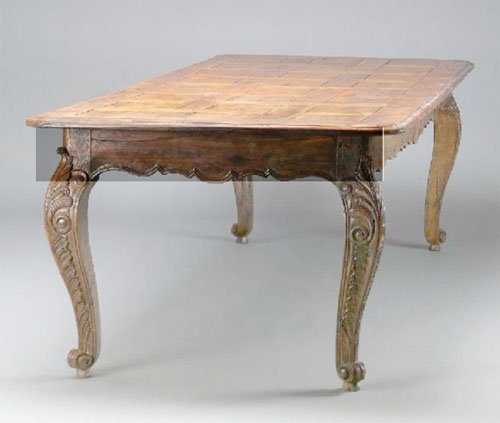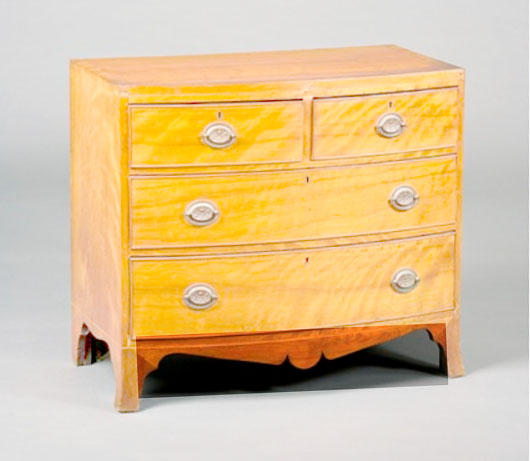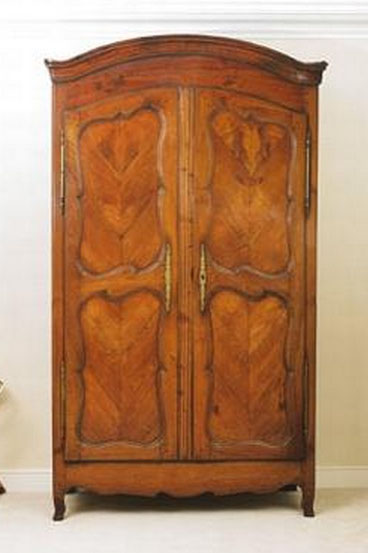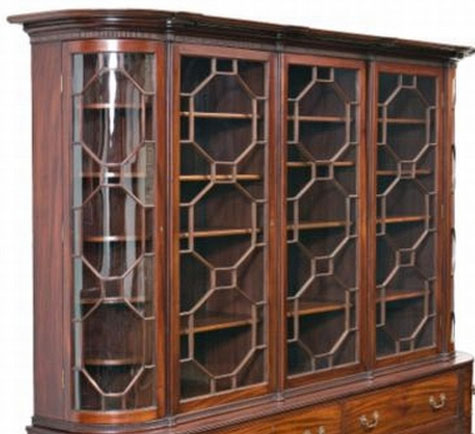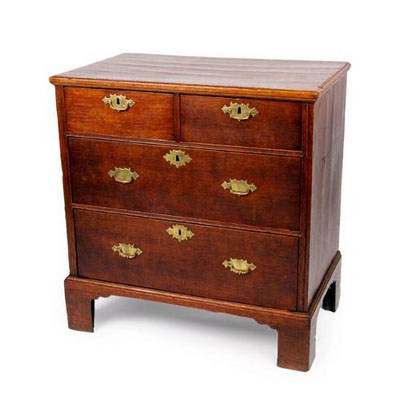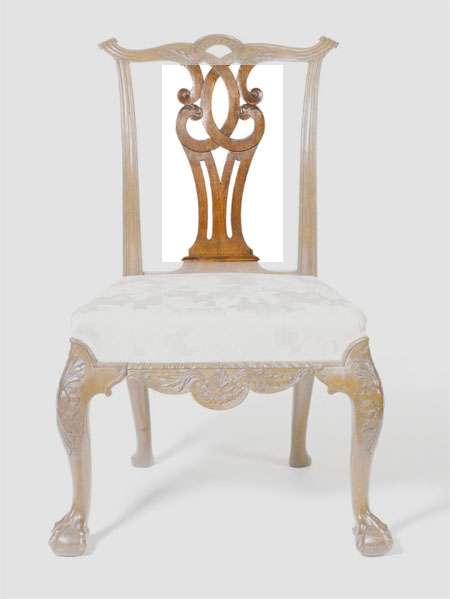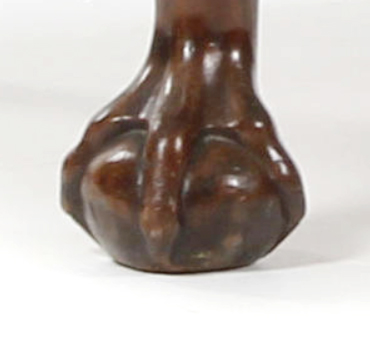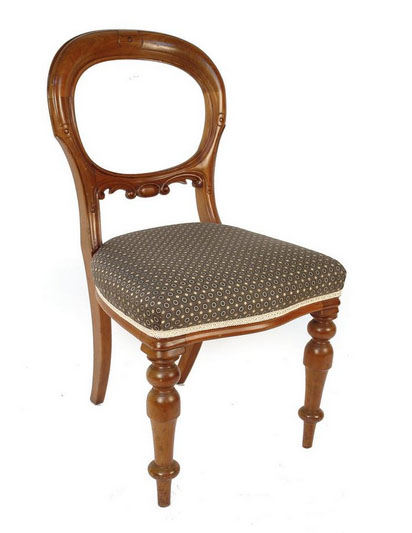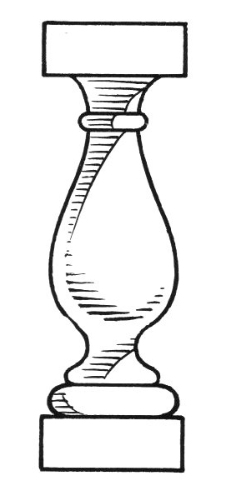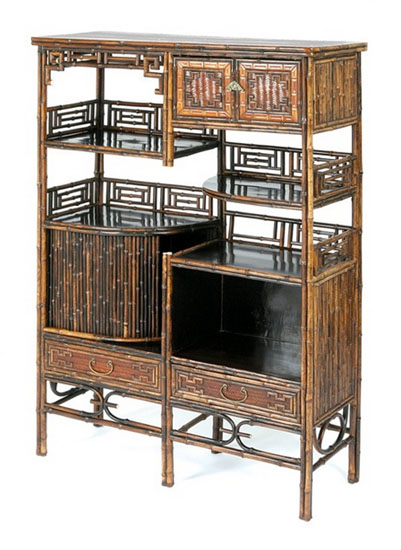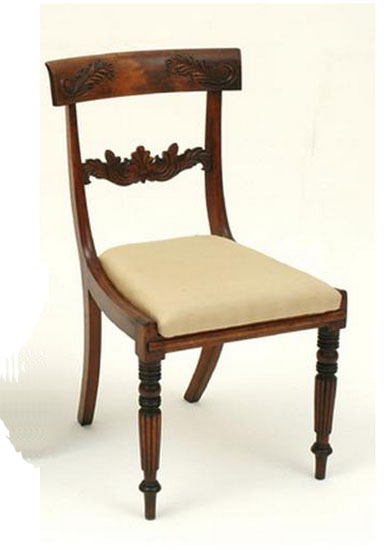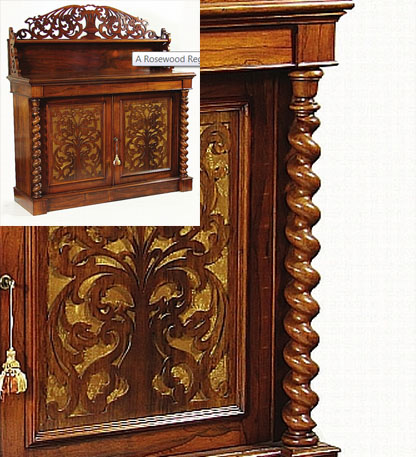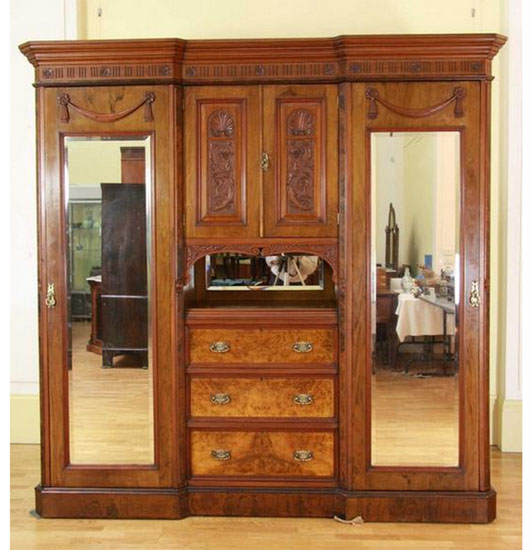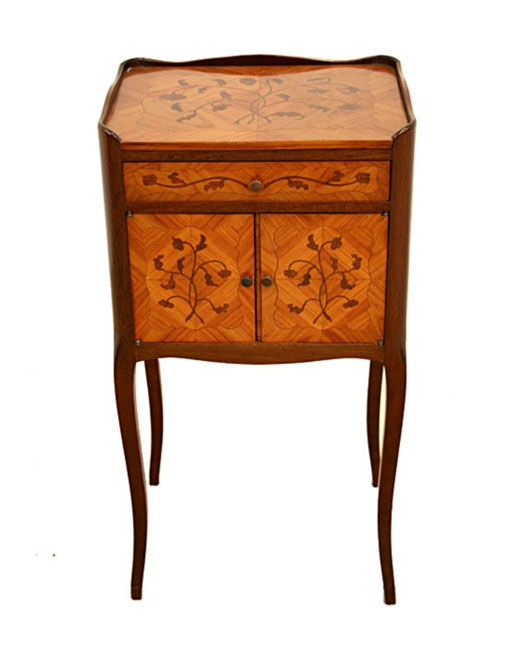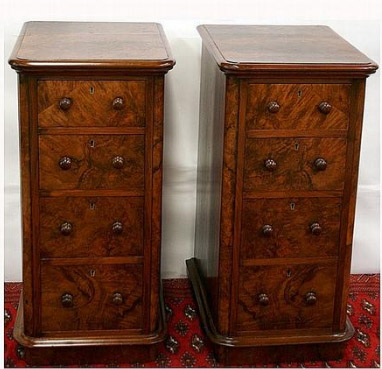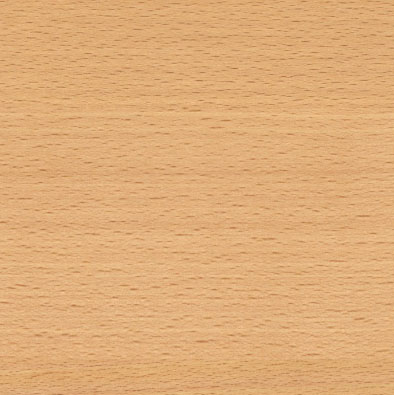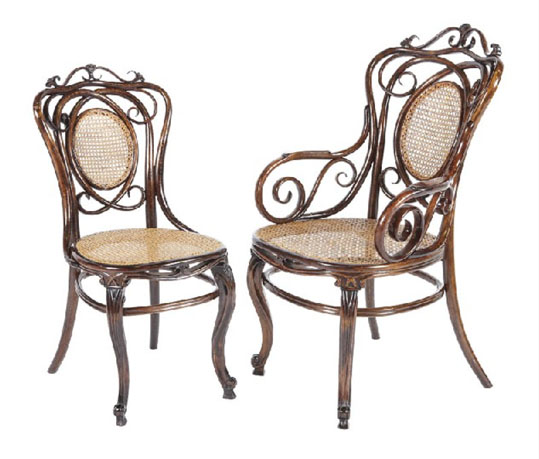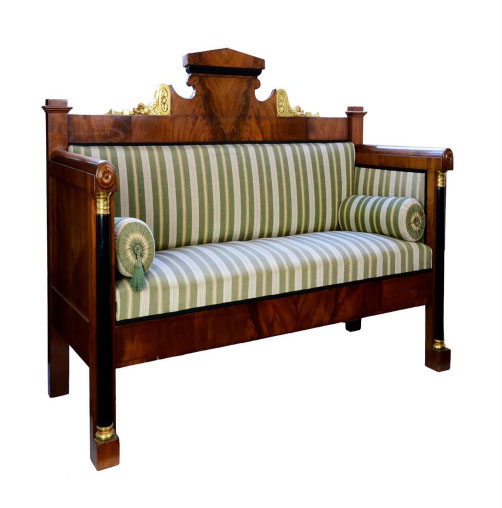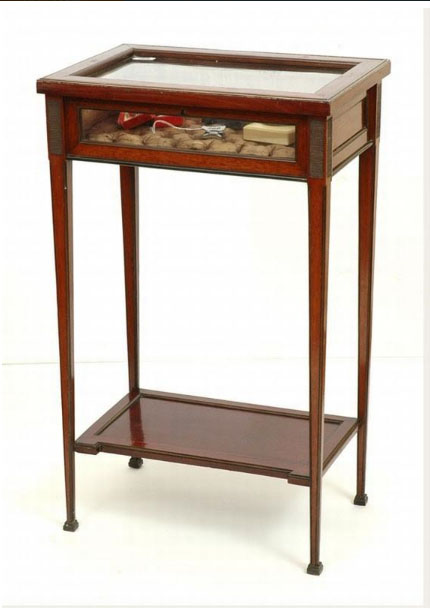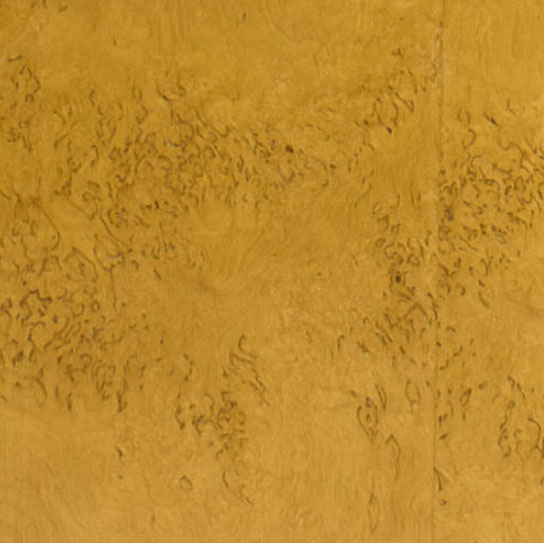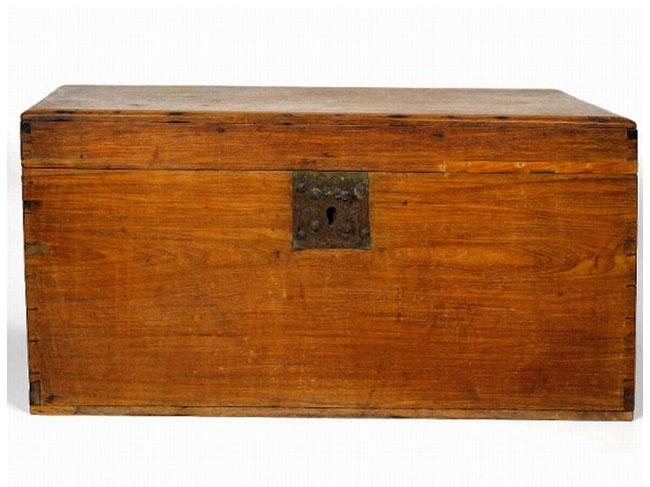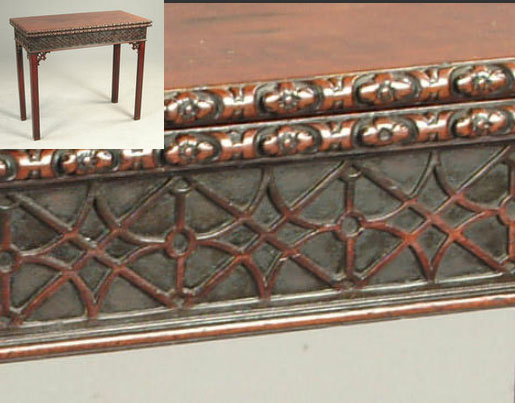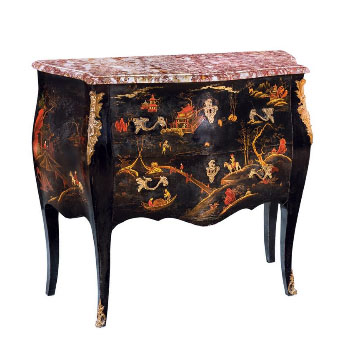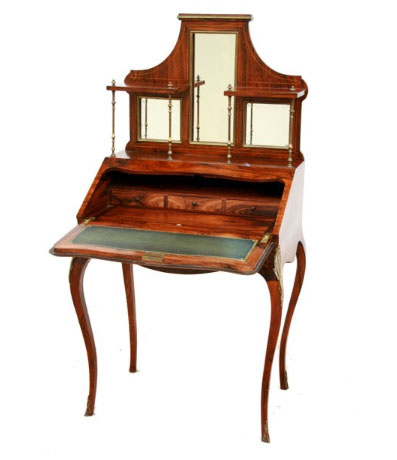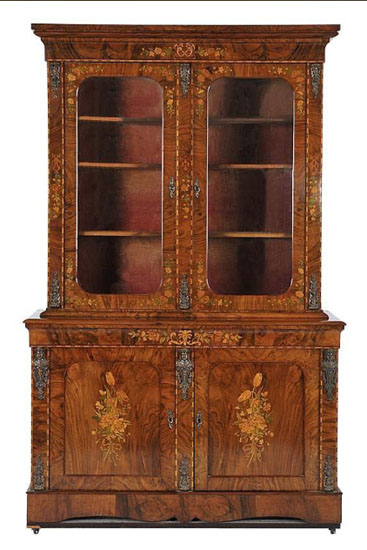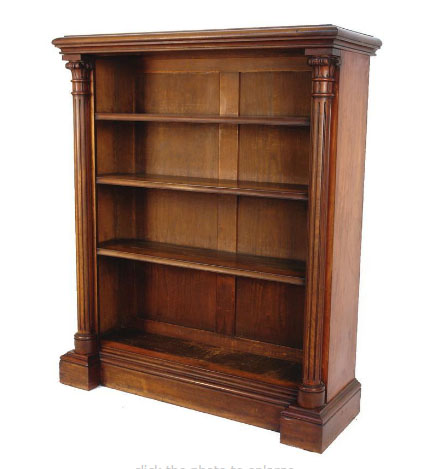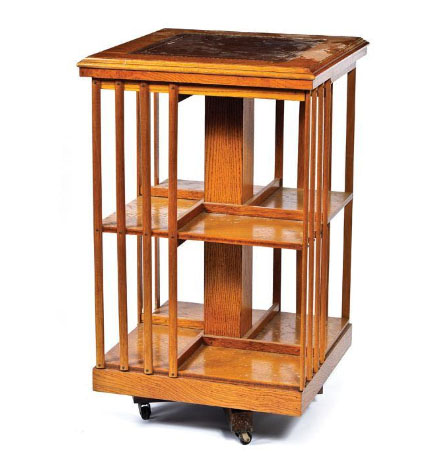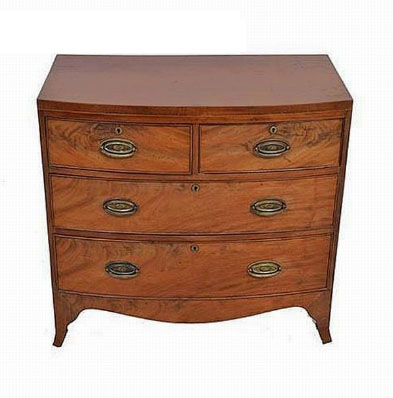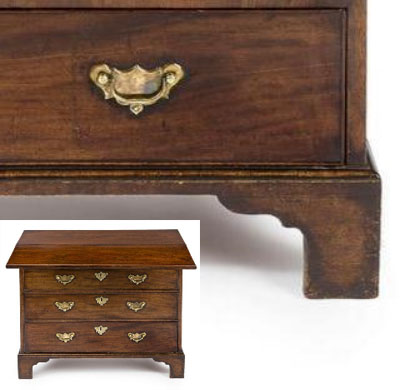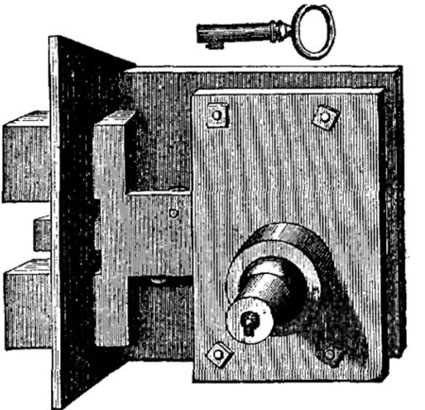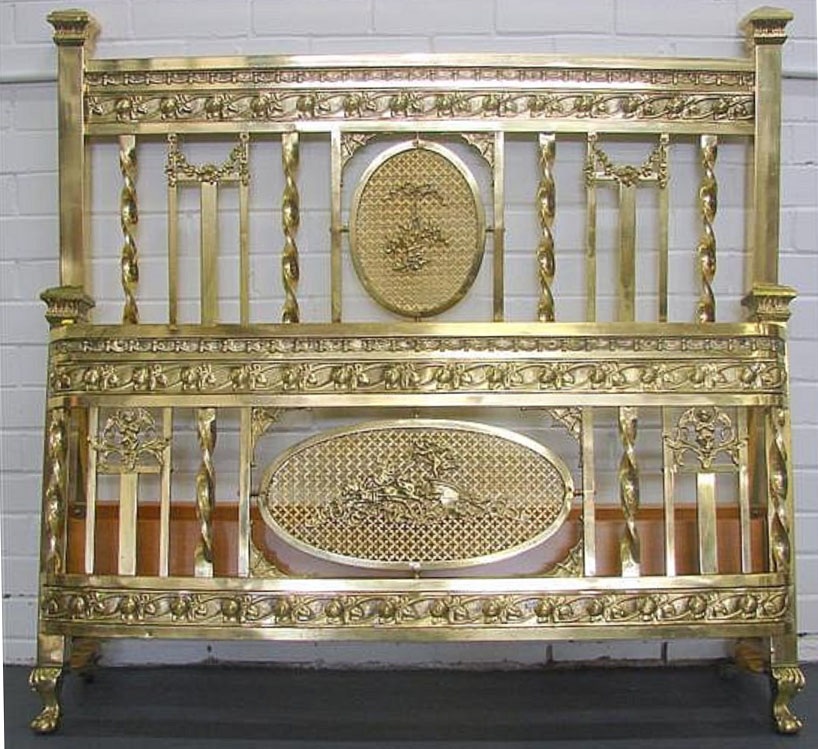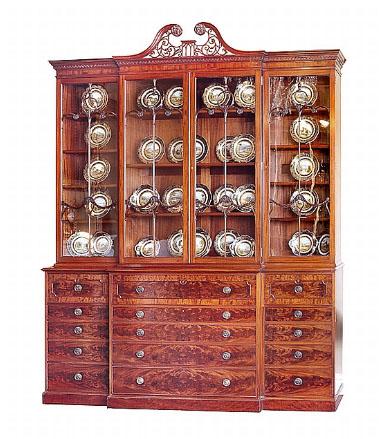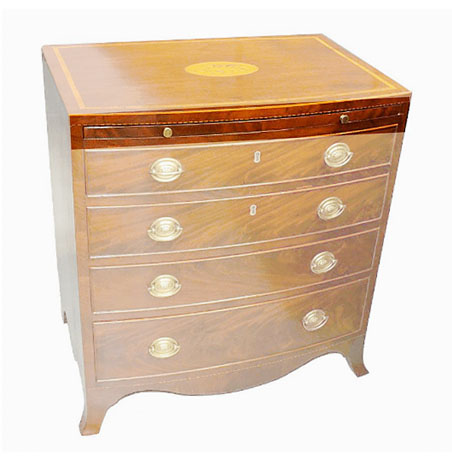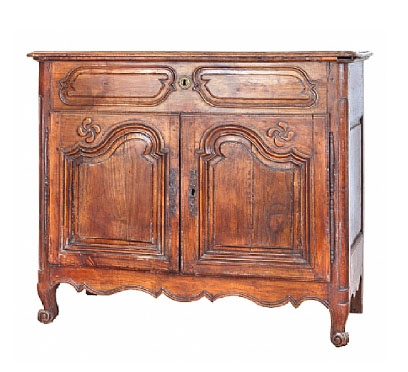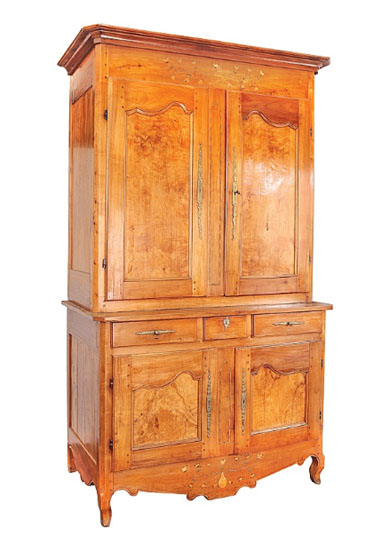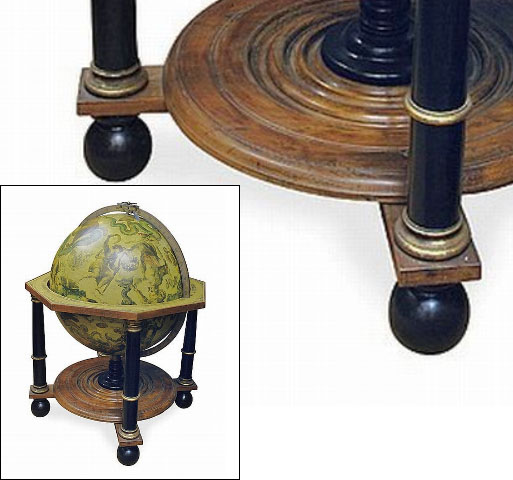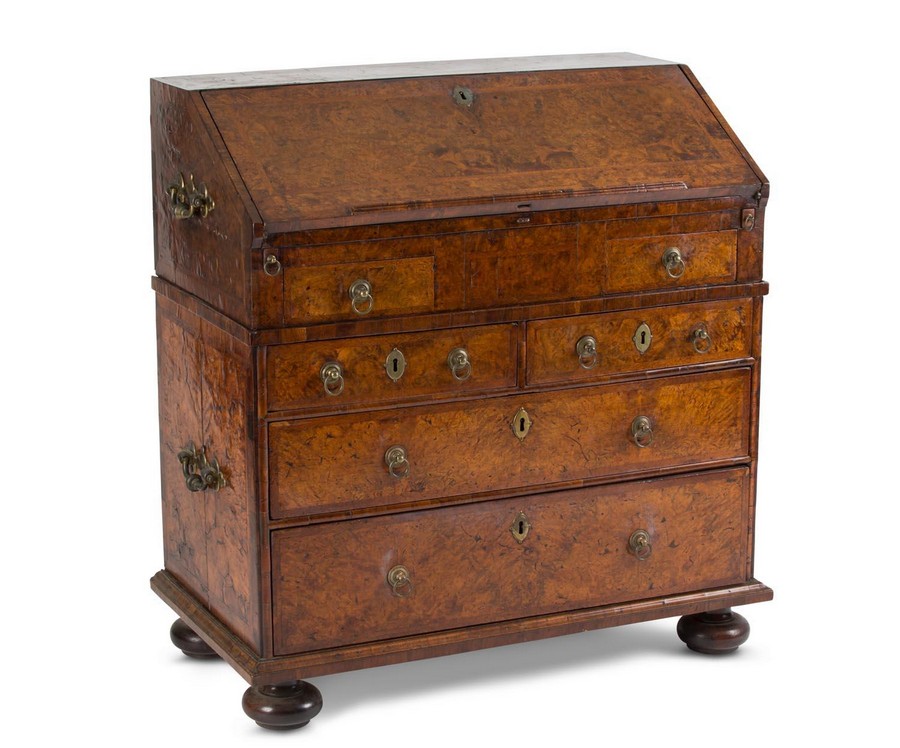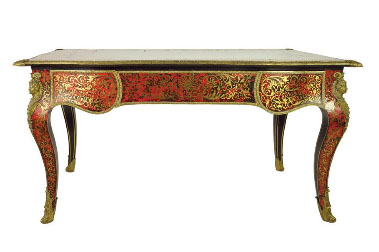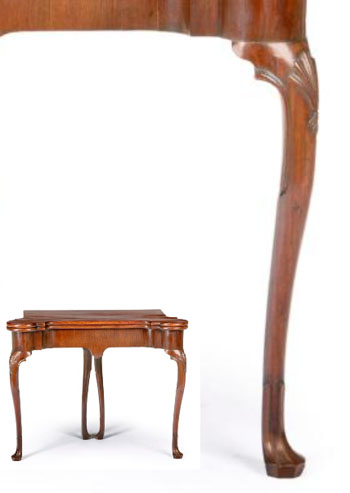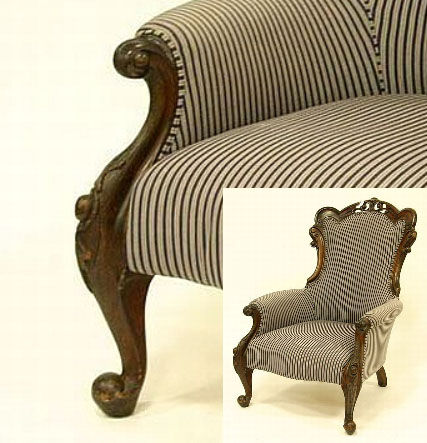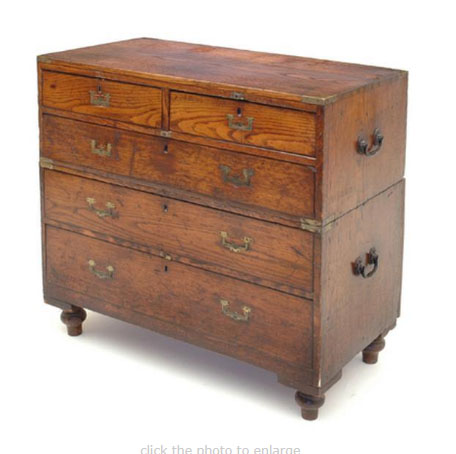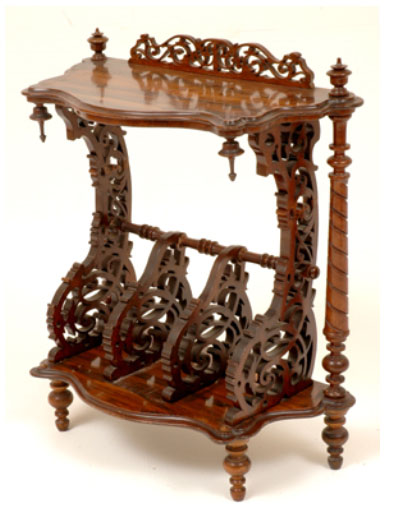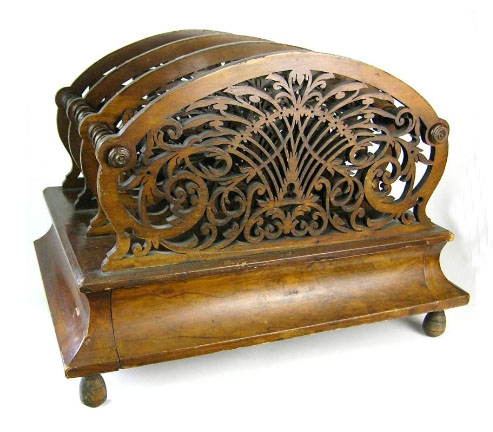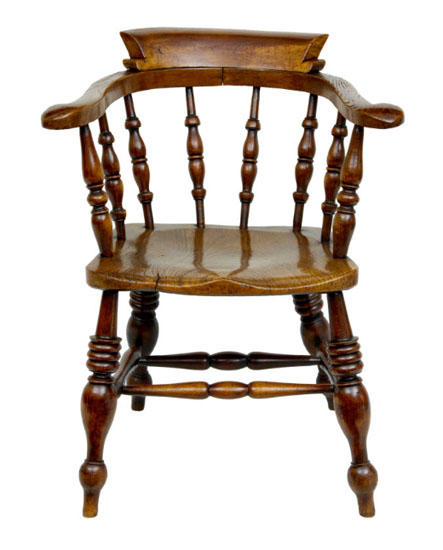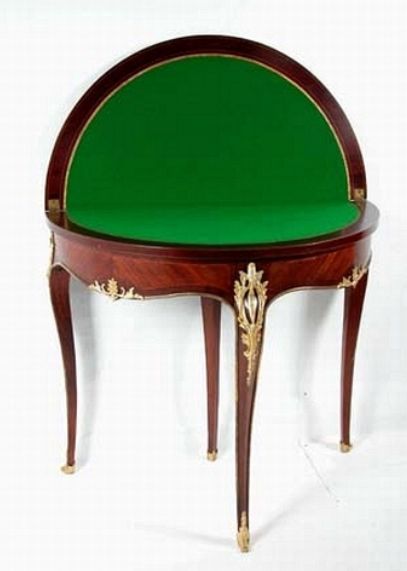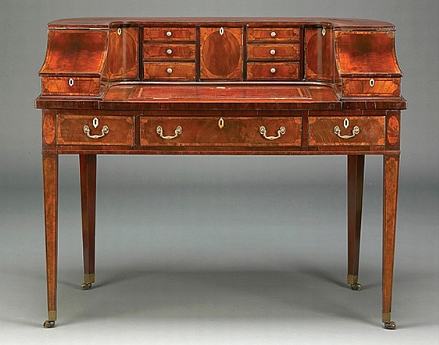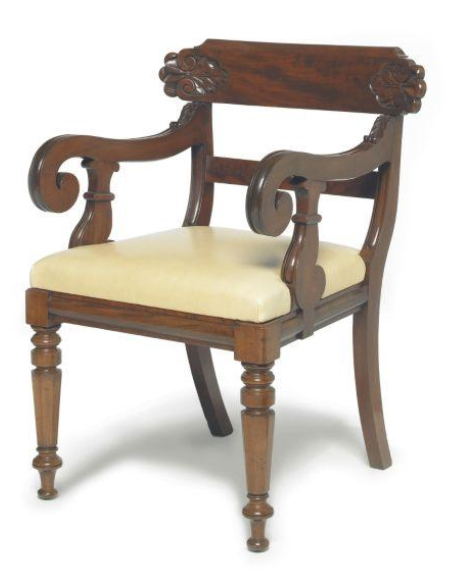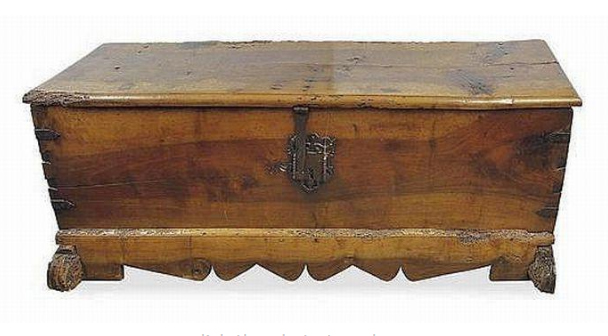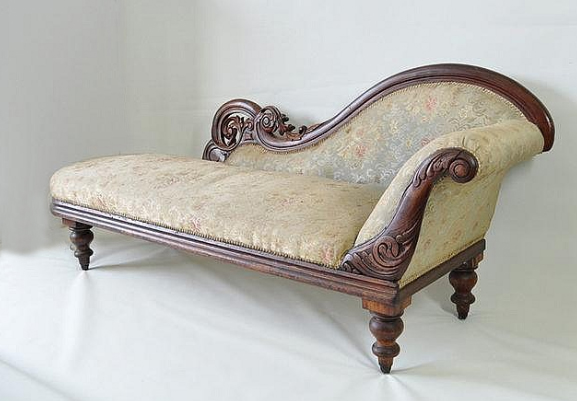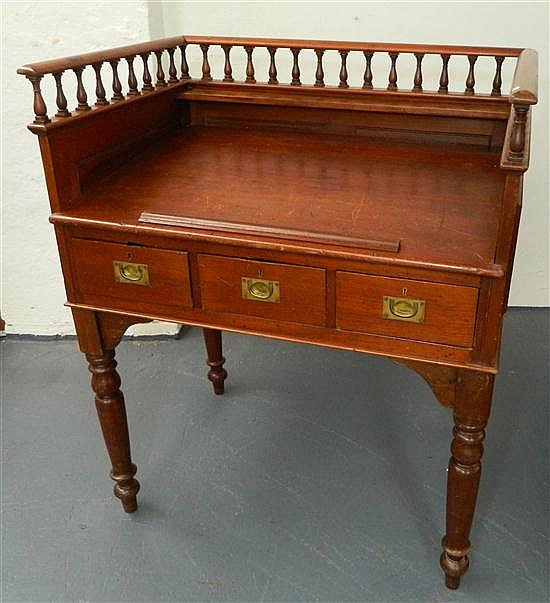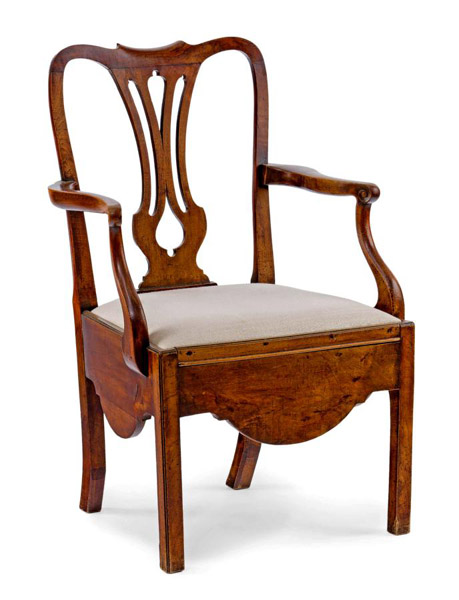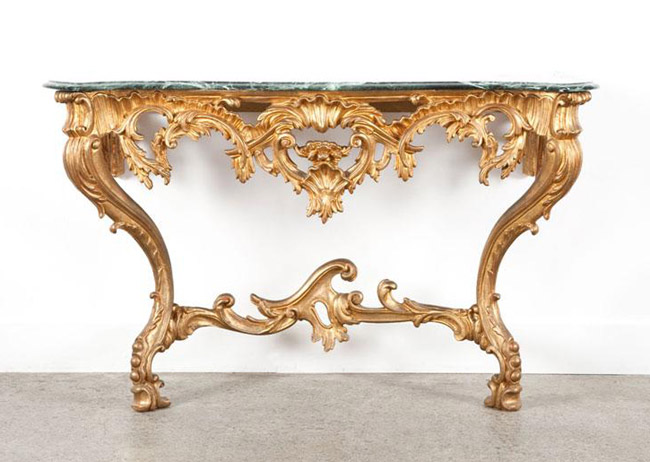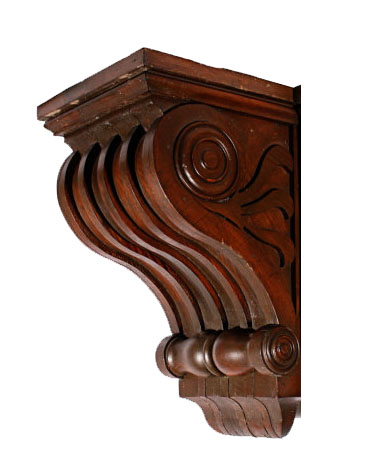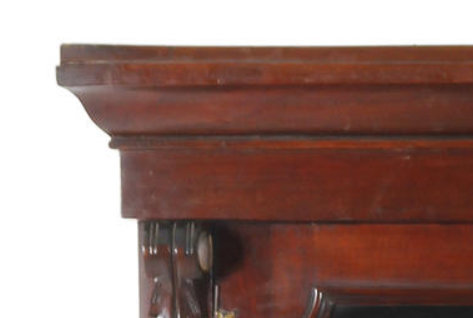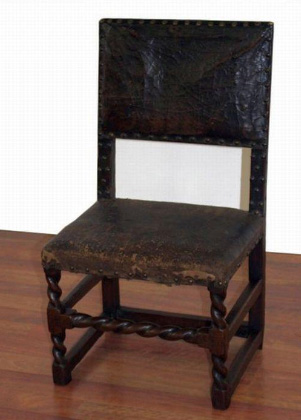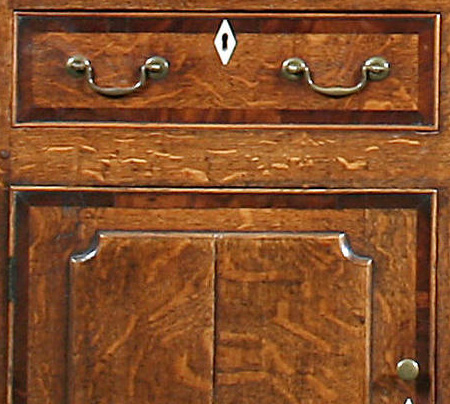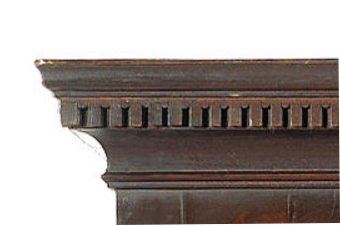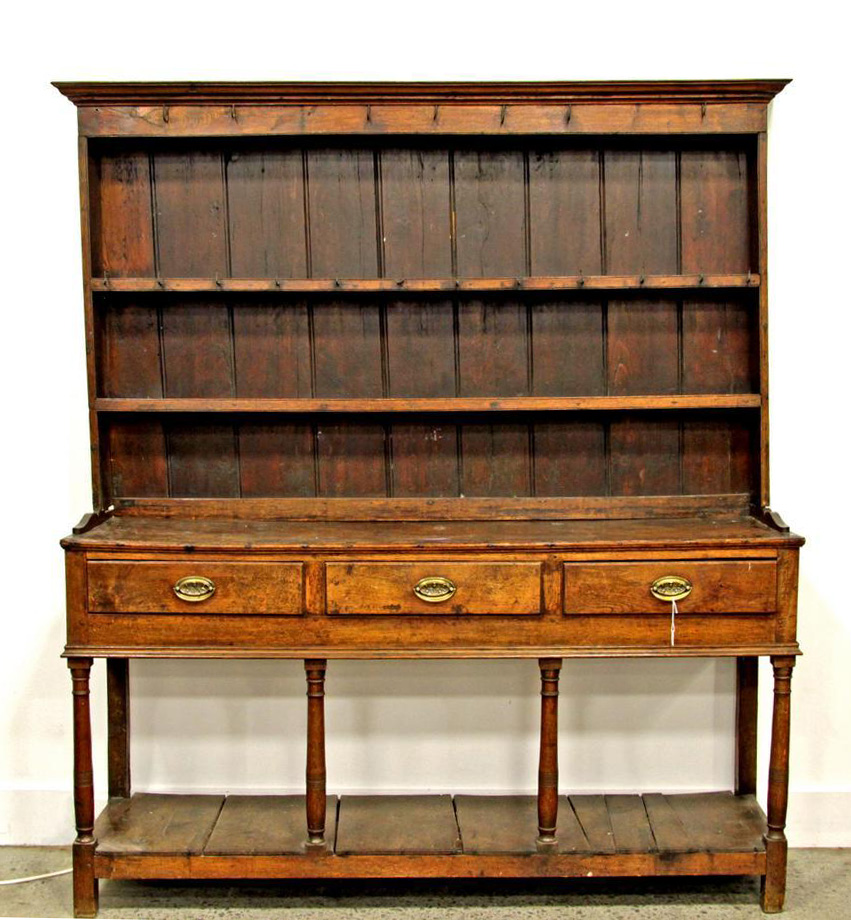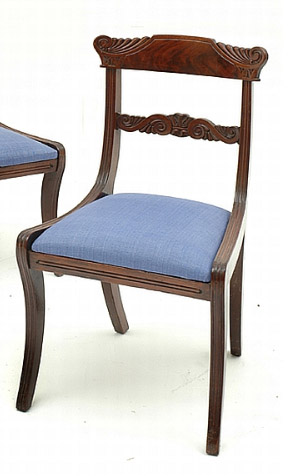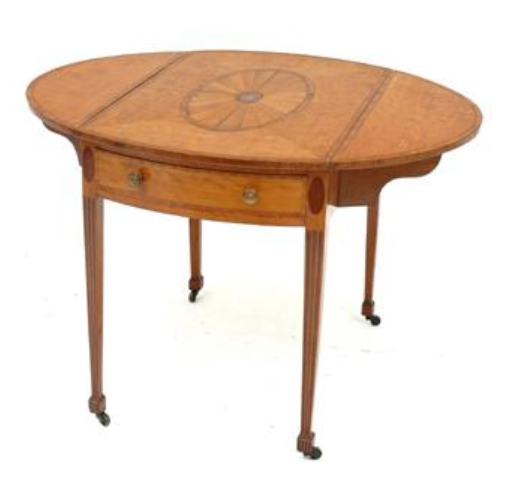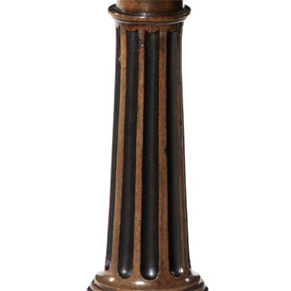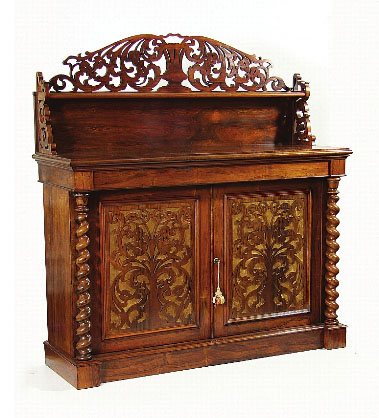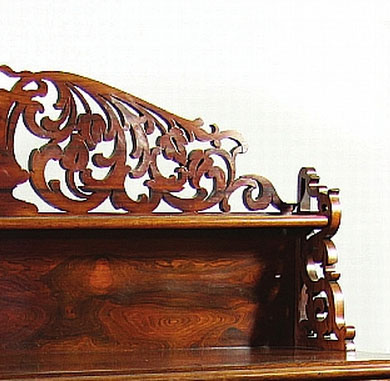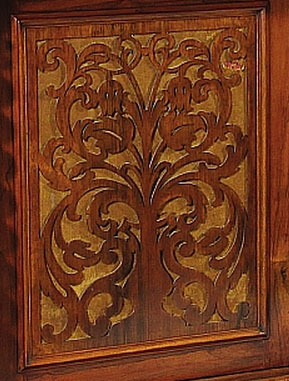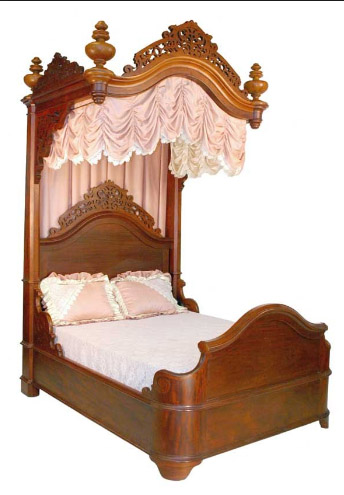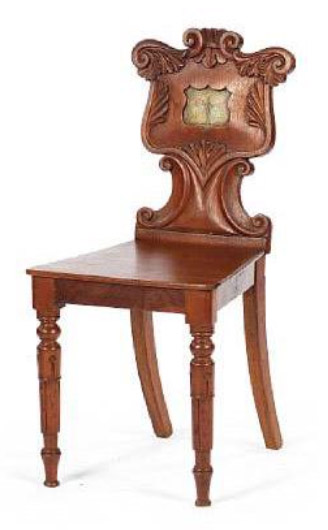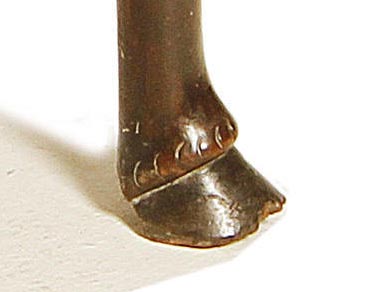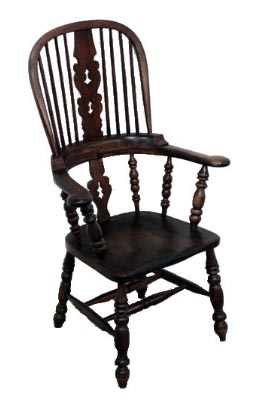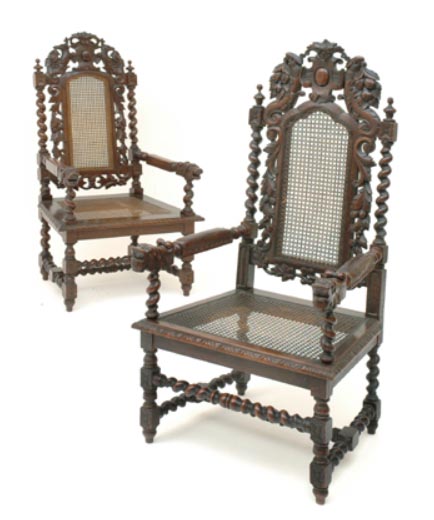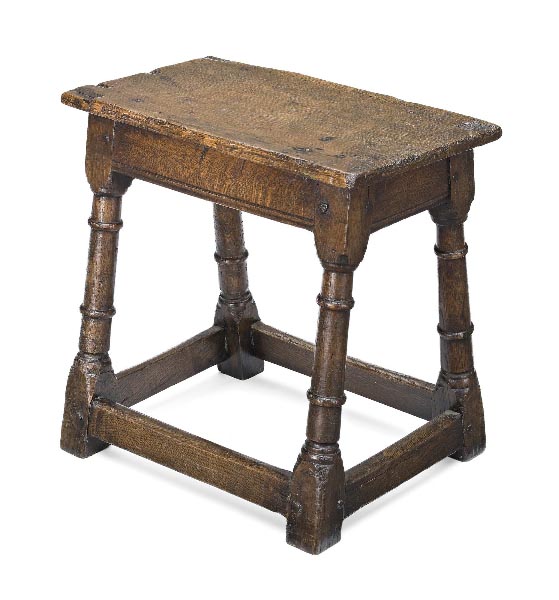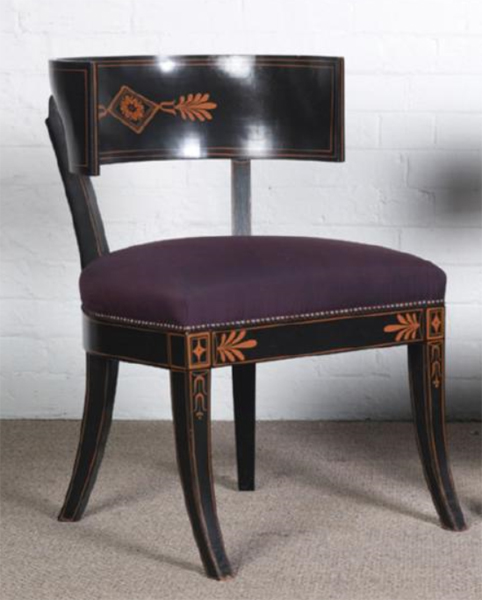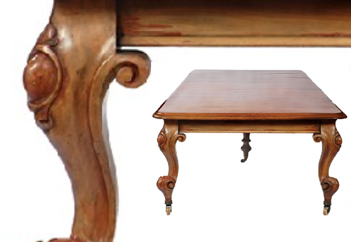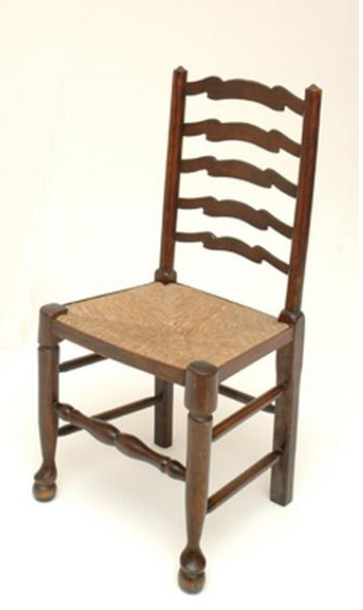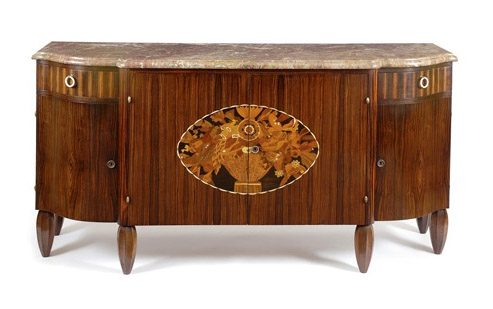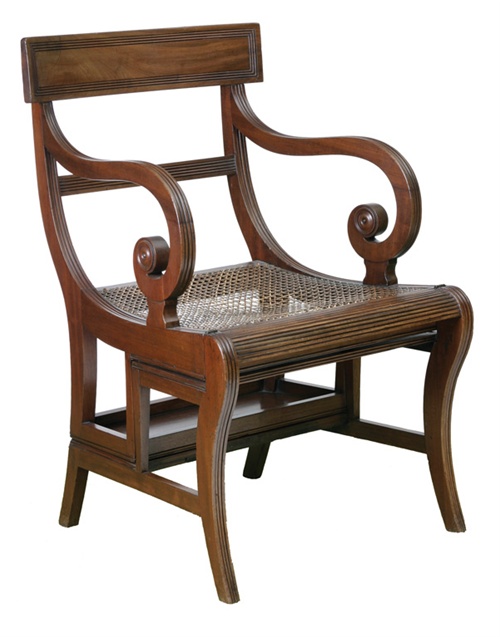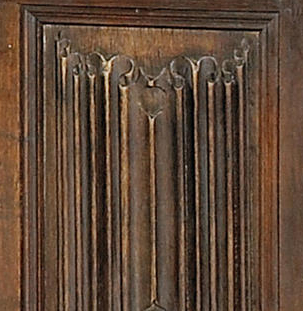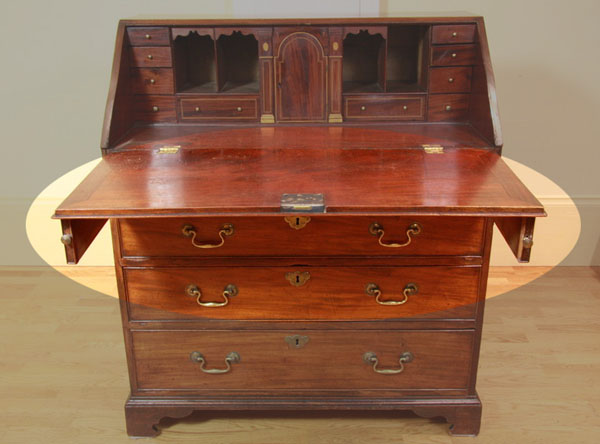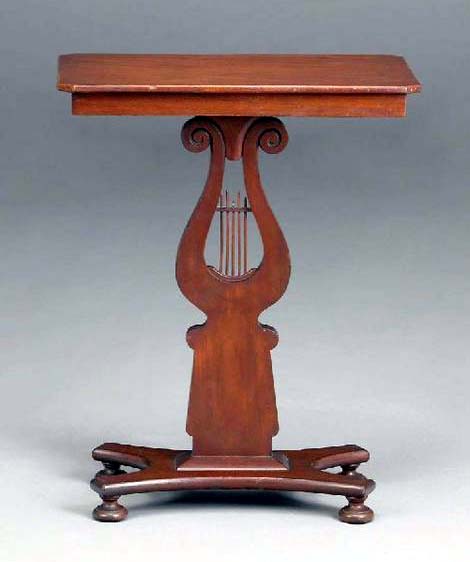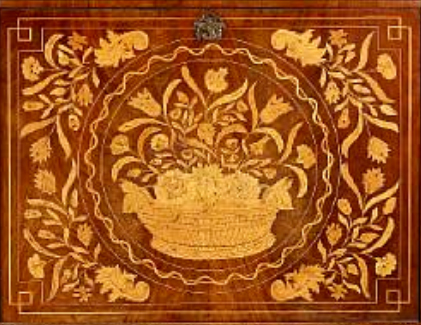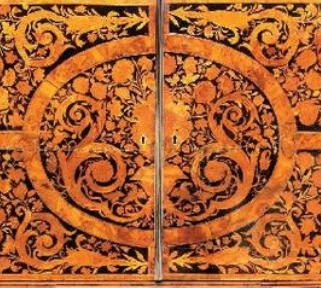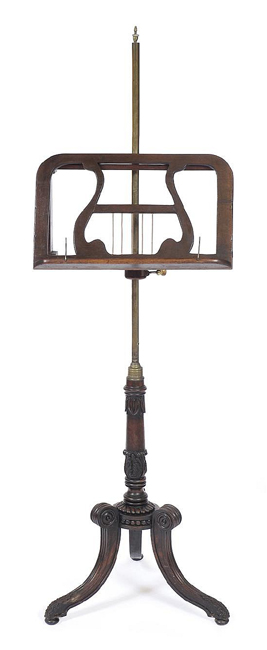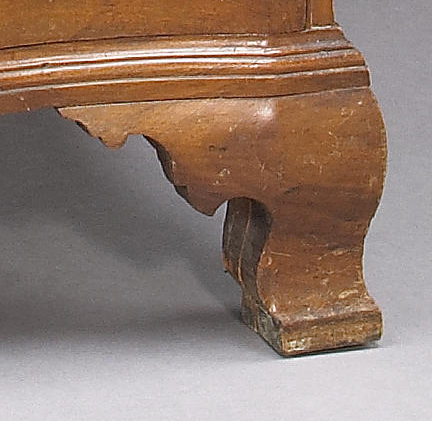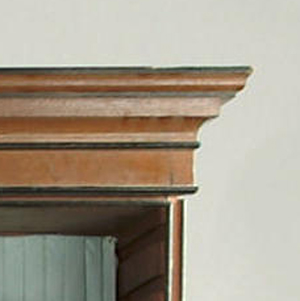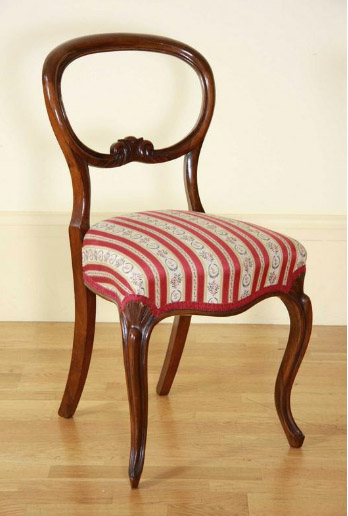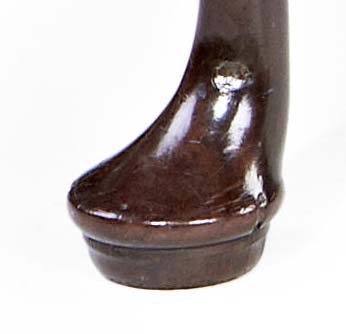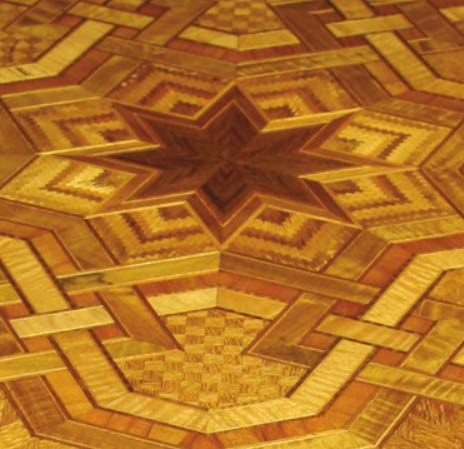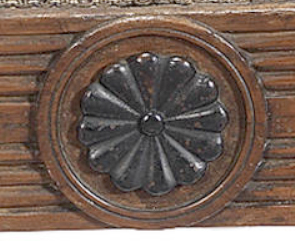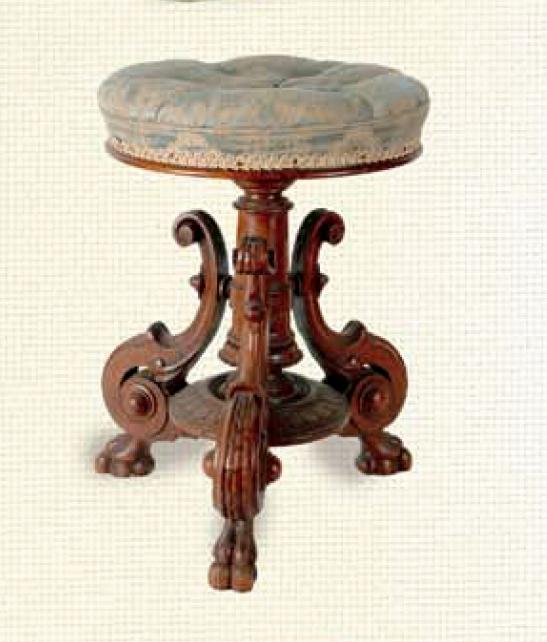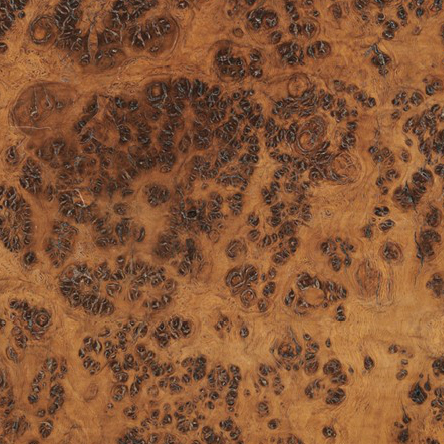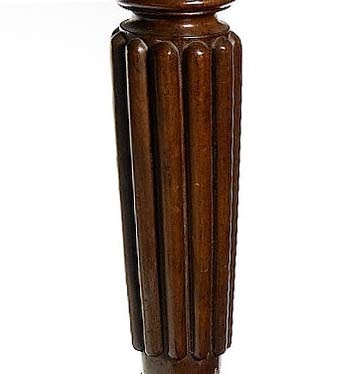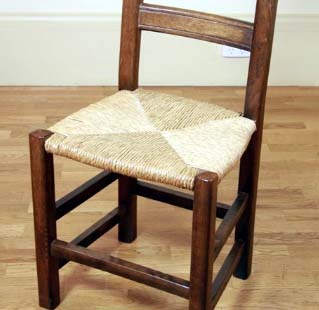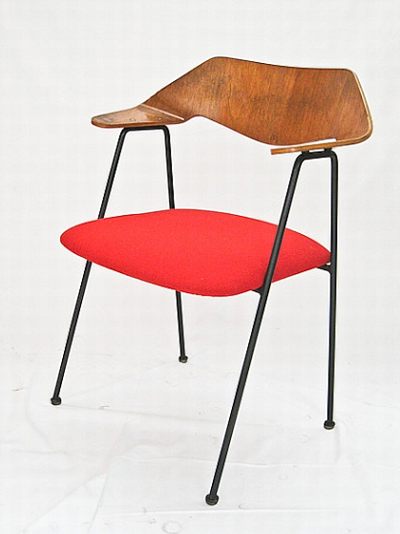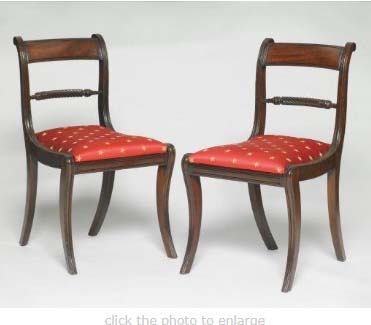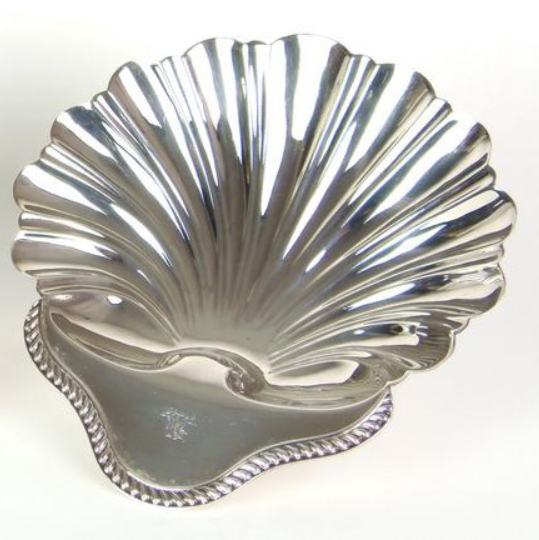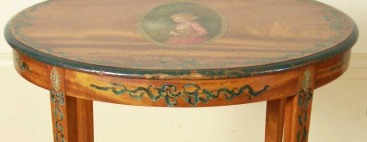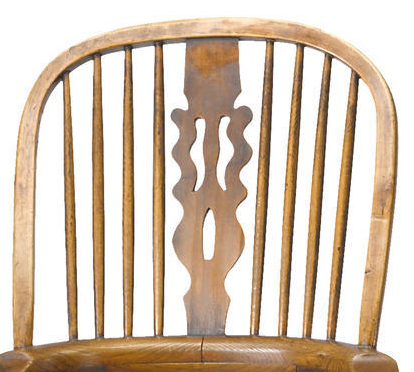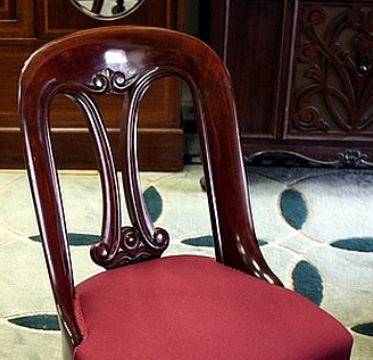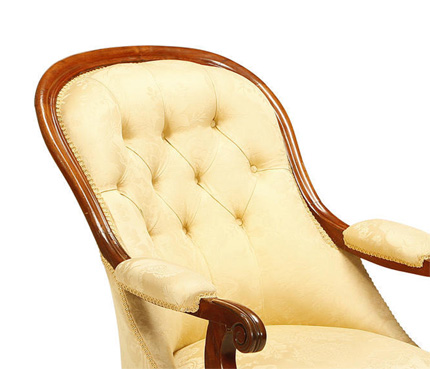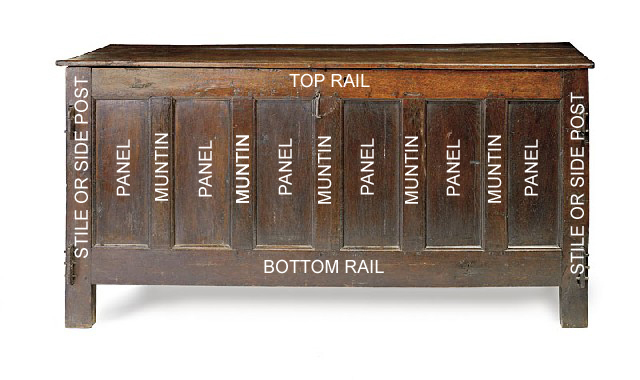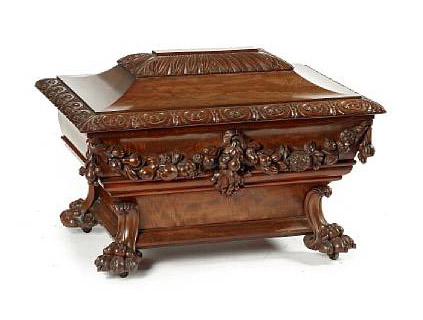Learn about antiques and collectables...
Click on a category below to show all the entries for that category.
Learn about and understand the items, manufacturers, designers and periods as well as the specialist terms used in describing antiques and collectables. Either click one of the letters below to list the items beginning with that letter, or click on a category on the left side of the screen to list the items under that category.
'jimmy Possum' Chair
Among the more celebrated versions of primitive stick chairs in Australia is the charmingly titled 'Jimmy Possum' chair, named after similar chairs made by a tradesman supposedly of that name, near Deloraine in northern Tasmania, at the turn of this century. Today several craftsmen are still making chairs and other furniture from naturally shaped sticks, their work forming the greatest possible contrast to the mass-produced goods turned out by the furniture factories.
The way the arms and legs were constructed is the most significant feature of the Jimmy Possum chair. They were made from solid pieces of timber shaped with an adze, axe or spokes shave, and did not use nails. The seat was a roughly trimmed split slab of wood, and is one of the common features. The four legs protrude through the slab seat to support the armrests and are held together with a wooden pegs or wedges.
Apron
A decorative wooden panel that sits underneath the top surface of a table or chair, and unites the top of the piece with the legs, running at right angles to the underside. On carcase furniture such as a chest or wardrobe, the apron sits below the drawers or doors and attaches to the legs.
On carcase furniture without legs the panel under the drawers or doors sits on the floor and is termed a plinth.
An apron can provide a decorative touch to an otherwise unadorned piece of furniture and at the same time provide structural support and strength. They can be carved or pierced and quite elaborate.
Armoire
A French cupboard, usually in walnut, very similar to a wardrobe, with either mirrored or panelled doors, containing shelves and hanging space.
Unlike the English and Australian equivalent, the armoire is demountable, in that the sides, canopy, doors, and base are all held together with a few metal bolts. In an unassembled state an armoire can be 'flat packed', so it can be easily carried in pieces up the stairs of an apartment block.
Astragal / Glazing Bars
An astragal, bead or glazing bar is the term used to describe the wooden strips that divide the glass in a cabinet into sections. However it can also refer to the narrow beading on a multi-door cabinet or bookcase that covers the gap between the doors, when they are closed. The astragal is usually attached to the inner stile of the left-hand door (or the right hand as you look at it).
Australian Cedar
Australian cedar, also known as red cedar or Toona ciliata, is a species of tree that is native to eastern Australia. It is known for its high-quality timber, which has a distinctive red color, fine grain, and a pleasant aroma. In the 19th century, Australian cedar was widely used in the manufacture of furniture, particularly in Australia and the United Kingdom.
The timber was considered to be a highly desirable material for furniture making due to its strength, durability, and natural resistance to rot and insects. It was also relatively easy to work with and could be finished to a high standard and was used to make a wide range of furniture items, including tables, chairs, wardrobes, and chests of drawers.
Australian cedar furniture was particularly popular in the Victorian era and was considered to be of very high quality. However, over-harvesting of the tree led to a decline in the availability of the timber and as a result, the use of Australian cedar in furniture making decreased in the 20th century. Today, Australian cedar furniture is considered to be quite rare and valuable by collectors.
Bachelor's Chest
A small narrow chest of drawers with a folding top. When opened, the top rests on a pair of lopers or slides. Bachelor's chests date from the early 18th century and usually have either three long and two half drawers, or four long drawers. Being narrow they are rarely more than 25cm deep they are popular in today's smaller houses and a great many have been converted from standard chests of drawers. An item of furniture that rarely appears on the Australian market.
Back Boards
As the name implies, the boards that back a piece of cabinet furniture such as a chest of drawers. The backing timber is usually of cheaper material like pine (often called 'deal' by the British trade), though in early Australian colonial days, red cedar was also used to back a piece. As cedar became scarcer during the later 19th century, craftsmen turned to kauri pine.
On early furniture, made before the first half of the 19th century, the backboards were often chamfered at the edges and the wide boards slotted into grooves in a supporting central frame. In later furniture, the backboards were generally nailed or screwed into rebates cut directly into the carcase and the boards became much thinner and narrower.
From about the first world war plywood was frequently used for cheaper pieces.
Backboards are one important way of judging the age of a piece of furniture.
Back Splat
The vertical or horizontal piece that joins the back to the seat, or between the two sides of the chair. The back splat stabilises and adds additional strength to the back.
Backboard
Backboard, as the name indicates, a backboard is a panel that is attached to the back of a piece of furniture, such as a bookcase, cabinet or desk. The backboard serves to support the structure of the piece and can also provide a surface for attaching other features, such as shelves or drawers. In some cases, the backboard may also be visible from the front or sides of the piece, in which case it may be decorated or finished in a specific way to enhance the overall appearance of the piece. For vintage and antique items of furniture, backboards are typically made of wood.
Ball and Claw Feet
Are in the shape of a rounded ball, attached to the underside of the carcase by a wooden shank. Introduced during the late 17th century and found on furniture in the William and Mary and Queen Anne style, are commonly found on cabriole legs in the manner of Thomas Chippendale, and furniture imitating the mid-18th century Rococo style. The leg terminates in a ball held by a carved lion's or bird's claw.
Balloon Back Chairs
A Victorian dining or drawing room chair, the quintessential symbol of the Victorian era. The back upright is waisted just above the seat, widening to a rounded curve at the top rail, forming a balloon shape.
The chairs were popular from the 1830s until the end of the 19th century. British balloon back chairs were usually made from mahogany or walnut, while the Australian version was made in cedar or sometimes Huon pine.
They were made in a multitude of variations, as anyone who has tried to find a matching chair to a set, can attest.
Baluster (furniture)
An architectural term for a column in a balustrade or staircase, often defined as a "vase shape". The shape is extensively used in furniture and decorative arts.
In furniture, it is used to describe a chair or table leg turned in that form, or more usually as an inverted baluster, with the bulbous section to the top. Less commonly used to describe a chair back that has the outline of a baluster. A baluster may also be split and applied to the front of a cupboard for ornamentation.
For ceramics and silver items it is often used to describe the shape of the whole item, rather than a part.
In Georgian glassware, the shape is commonly seen in the stem of glasses.
Bamboo Furniture
Towards the end of the nineteenth century, there was a revival of the taste for bamboo furniture featuring pseudo oriental styles. Bamboo furniture had been popular in Regency days, but the difference was that, while in Regency days the 'bamboo' legs and other members were generally simulated, that is, the wood was turned and notched, and then painted to look like bamboo, the later pieces were actually made of bamboo.
Bamboo frames often enclosed wickerwork covered wood panels. Numerous articles were produced, including hatstands, shelves, small tables, chests of drawers, (often surmounted by a mirror and a complex of small drawers), and overmantels liberally supplied with mirrors.
Bamboo furniture was mass-produced by several London firms. In a way, it was symbolic of the British Empire. Middle-class people felt comforted using furniture which they believed came from some oriental outpost coloured pink on the map. Some may even have been smug enough to imagine they were doing the natives a favour by patronizing their craft industries.
In recent years there has been a resurgence in the demand for bamboo furniture. Repairs can present a problem, for there are not many restorers either expert or interested in such work.
Bar Back Chairs
Also known as rail back, Regency, Trafalgar and spade back chairs. A chair in which a straight or slightly curved top rail extends horizontally between or across the rear uprights. The design is attributed to Sheraton. In the early versions the top rail was often supported by vertical splats, sometimes plain or reeded, sometimes carved with various motifs.
The legs were either square or more generally tapered, sometimes reeded. The simple, square form of the late 18th century chairs evolved into the more rounded shape common through much of the 19th century, sometimes known as spade back chairs, many of which were made in Australia from red cedar.
The top rail is curved, extending beyond the uprights, and generally shaped and rounded at the ends. The construction is strengthened by a horizontal curved splat and the legs are almost always turned. The heavier the turning, the later the chair.
Barley Twist
The leg, and frequently other uprights such as columns, chair frames, spindles and stretchers, are turned in fairly wide and deep spirals, usually slightly rounded. Also known as the 'Jacobean twist' and common on the dark stained Jacobean Revival furniture of the 1930s and 40s.
As a rule, the twists on opposite uprights should move in a contrary direction. Thus, if the spiral on a right side is clockwise, that on the left side should move in a counter-clockwise direction.
This is also true of rope-twist or cable-twist turning, a nautical term that came into fashion after Nelson's victories over the French fleet. The essential difference is that with rope twists, the spirals are more finely turned on the lathe and placed closer together, than they are with barley-sugar turnings.
Baroque Furniture
Baroque furniture is a style of furniture that was popular in Europe during the Baroque period, which spanned from the late 16th to the early 18th century. Baroque furniture is characterized by its ornate, decorative design, which often features elaborate carvings, gilding, and other embellishments.
Baroque furniture was popular in many European countries, including Italy, France, and Germany, and it was often used in the homes of the wealthy and in royal palaces. The Baroque style is also associated with the Church, and many churches and cathedrals from this period feature Baroque-style furniture and decorations.
The Baroque style of furniture is characterized by ornate and extravagant design elements that originated in Italy in the 17th century and spread to other parts of Europe, where it was particularly popular in the courts of royalty and the wealthy aristocracy. Baroque furniture is often made of rich materials such as gold, silver, and precious woods, and it is decorated with intricate carvings, inlaid designs, and gilded or painted finishes.
Beaconsfield Wardrobe
A type of wardrobe, usually of three sections, in which the two outer sections contain hanging space, while the centre section has a cupboard in the top section for hats, then a mirror, and then drawers below.
Beard Watson & Co.
Beard Watson & Co. were Sydney based furniture manufacturers and retailers in the early 20th century, as part of their general furnishing and homewards business.
The company commenced business in 1889 when an existing retail business was taken over and renamed by William Beard, James Watson and James Kebblewhite, and expanded into furniture manufacture when the company acquired a furniture manufacturing business in 1901.
The company established a reputation for well designed furniture of good quality, as illustrated by the items listed in this price guide.
Furniture manufacturing and retailing continued until the 1960s, and as well as the existing Sydney city store, branch stores were opened in a number of Sydney suburbs in an effort to counter declining sales in its city store.
Beard Watson was taken over Nock & Kirby in 1959 but continued to trade in its own name.
However sales continued to decline and the city store closed for good in 1973
Bedside Cabinets
Small cupboards, usually square or rectangular though sometimes round, designed to stand one on either side of a bed. They have been made since the 18th century, but true pairs are very difficult to find. In a genuine pair, the doors should be hinged on different sides, so that the cupboard opened away from the bedside. Small chests of drawers were also made as bedside pieces. Pairs of French bedside cupboards are much more common than English or Australian pairs, which even when part of a bedroom suite, were only made as singles. Most Victorian or Edwardian pairs of bedside cupboards that come on to the market, have been made up from the pedestals of pedestal dressing tables of the period, but due to demand the fact that they are not original does not diminish their value.
Beech
Beech, a pale coloured timber, is native to temperate Europe, Asia and North America and classified as a hardwood, although comparitively "soft" when compared with oak or ash. It has long been popular with with country craftsmen, particulary chair makers, as unlike ash it is suitable for turning.
Bench Seats
A long, narrow wooden form, used for sitting at table or as a verandah seat.
Until the late 17th century, most people sat on benches, chairs being the preserve of the rich or the elderly, and they continued to be used in farmhouses and schoolrooms until comparatively recent times.
Benches may be either simple timber slabs through which holes have been bored for the stick legs or take increasingly elaborate and professionally constructed shapes. The church pew, in fact, is only a highly developed type of bench with the addition of a back.
Bentwood
The Austrian bentwood furniture designed by Michael Thonet (1796-1871) was among the 19th century's most original contributions to furniture development. Thonet used the techniques of steam-bending and the pliable nature of beech wood to make chairs, tables, hallstands, cots and so on. The furniture was simple in form, light in weight, elegant and capable of being mass produced, so that bentwood furniture was exported to many parts of the world, including Australia, following its success at the 1851 Great Exhibition. Thonet chairs, and those made by his competitor Kohn, often have paper trade labels pasted on the inside seat rail. Thonet was not the first to apply the techniques of steam bending to furniture. It was used, for example, during the 18th century by the Windsor chair makers to construct bow back or hoop back chairs, and the arched crinoline stretchers but he was the first to exploit it on such a vast commercial scale.
Bergere Chair
A fairly wide, deep, upholstered armchair used in the drawing room, often accompanying a settee, in the French, a canape. The form was developed in France during the mid-18th century, though it was quickly adopted by English designers such as Chippendale and Sheraton.
The seat frame is over-upholstered, but the rest of the wooden framing is exposed. It is generally carved, and of walnut if the timber is exposed. if made of an inferior timber such as beech or fruitwood, it may have a painted or gilded finish.
Biedermeier
Biedermeier, Empire and Art Deco have shared roots.
Often misunderstood, Biedermeier is a period 1815-1848 , that squarely sits between war and revolutions. It is a period that is not named after a royal personage, nor a fabulously talented designer or a gifted individual furniture maker. The name was coined AFTER that period passed. The name is made up of two words joined together: Bieder- ( meaning simple)and Meier ( a common German name) . It was first coined in a publication of a cartoon like character "Papa Biedermeier" illustrated in "The Flying Pages" a german periodical newspaper. He was a simple character and was quite oblivious to the world around him , a very decent chap with introspective tendencies, who didn't want to trouble anyone else.
Occupation and Empire
Under the French Imperial occupation by Napoleon's troops in Austria and the, as yet to be united, Germanic states in early 1800's , the French Empire style exerted much influence on architecture and design. However the Empire formality did not sit easy amongst the middles classes nor the farmers or workers . It reminded them of the foreign powers controlling their homelands. Various characteristics of the Empire style were however enduring and were adopted by the royalty and the nobility. However it was the growing middle class that really developed and grew the Biedermeier style from its Empire origins. With the defeat of Napoleon in 1815 the liberated germanic peoples sought a simple less grand style on a more human scale. The ancient Roman architectural influences of the Empire style was not lost but flourished in a reinterpretation and triumphed with Berlin's most gifted architect of the time Karl Friedrich Schinkel. His many designs can still be seen today and one of the best examples is the princely conversion of a farm house in Potsdam to an elegant pleasure palace Charlottenhof . The neoclassicism world was definitely still the main source for inspiration.
Biedermeier Begins 1815
With Napoleon no longer in control, the rulers and their minions of the liberated germanic states, such as Metternich in Austria, tightened the reigns of the freedoms that were part of the "Code Napoleon" the legacy of the French Emperor. This suppression led to the growing middle classes wanting more elegant neoclassical interiors in which to entertain family and close friends in private. This growing demand of the more affluent middle classes for Biedermeier furniture also increased the appreciation and use of indigenous materials. Expensive imported mahogany from the Americas was taxed as it passed through each state, so that only the truely wealthy could afford this timber in Holland, port of entry, and Vienna and Berlin. Gilt bronze mounts were also imported but reserved only for the most wealthy houses and palaces. For Biedermeier furniture , local timbers such as elm, walnut , cherrywood, ash and pine were in great demand. The pale colours gave rise to an opportunity to contrast with ebonised inlay and details. Ebonising was a way of staining and polishing black in order to imitate expensive ebony wood. The ebonised contrasting details to carvings was a reinterpretation of Empire style's gilt bronze mounts which were used to great effect. It was also less expensive to produce and gave a beautiful original look to Biedermeier furniture. Regency period publications from England were highly sought after as the neoclassical inspiration for design . It also allowed for a non french style to spread within Europe, something that had not happened for many centuries because Paris led the way in all things style until the 19th century. Design elements such as the usual neoclassical paraphernalia consisting of columns, scrolls, lions heads and lions paw feet, sabre and taper legs swags and garlands, diamond or chevrons and inlaid straight lines were all very popular. Handles were rare as it interfered with the minimalistic simplicity of the architectural form of furniture , however lock smiths and key manufacturers were in their element producing the finest works of the age. This is why many Biedermeier pieces are often mistaken for more modern Art Deco. Drawers would be opened and closed with an elegant key allowing for security of the goods locked within. See image above. Despite the gloom of having little personal liberties or freedom of speech during the Biedermeier period, bourgeoisie interiors were very colourful, a reflection of their new found wealth. The MAK in Vienna houses a fabulous collection of period Biedermeier fabrics that are so colourful it would make a bubble gum manufacturer wince ! The germanic pale timber furniture contrasts nicely with all this colour . Its ebonised details and contrasting inlays even influenced the French under Charles X and Louis Philippe to imitate this sober german style. Biedermeier spread north into Russia and especially Scandinavia where it was much embraced by Swedish cabinetmakers using indigenous birch timbers. It became known as Karl Johan, named after the former French Marshal who changed allegiances from Napoleonic France to Sweden. His family stills reigns in Stockholm to this day.
Biedermeier period ends 1848
Sadly as with most period styles , what appealed to one generation, was soon discarded by the next in favour of the new. In 1845 and again in 1848, liberalistic revolutions swept across Europe and the slow blending of rococo influences became full blood with the revival of historicism in design. Victorian furniture styles became adopted throughout Europe and craftsmanship declined due to mass production and lack of quality materials. In general the second half of the 19th century saw a confusion and revival and blending of previous styles. This era produced most of what the Antiques trade terms "brown shipping furniture". Sadly as often happens with older furniture, the Biedermeier pieces were relegated to the attic or to country house until.........
Biedermeier revival and Art Deco early 1900's
With the approaching new century towards the end of the 1800's there was a desire to embrace a new style. In 1898 the Applied Arts Museum in vienna held the first retrospective exhibition of the Biedermeier period. Examples of quality furniture and interiors including costumes and fabrics were dusted off and proudly displayed. This newly re-discovered design period had a fascinating effect on the European world of interiors. For the first time a new generation learnt that this modern clean and human scale furniture was not only comfortable to live with but with its lightness and colours inspired a new way of living. Original period pieces from the Dannhauser furniture factory were once again looked after and on displayed, thanks to the vast collection at the Hofmöbelsammlung in Vienna. This exhibition created a new interest and hence demand for revival period Biedermeier style furniture. Its popularity was short-lived however from 1900-1915. The Great War interrupted many things and from it was born a new machine age style, the Art Deco period. Although coined after the French exhibition : "International Exhibition of Modern Decorative and Industrial Arts" held in Paris in 1925, the Art Deco style owes many influences to Biedermeier designs. The two periods are often confused and that's really nice if you know what to look for ....
Contributed by Oliver von Wilpert, Director The Empire Company Pty Ltd.
info@antiquesdesign.com.au
www.antiquesdesign.com.au
Bijouterie Table (table Vitrine, Display Table)
A bijouterie table is designed to store and display a collection of small valuable items. In French usuage, a bijouterie magasin refers to a jewellery shop. Bijouterie tables are also called table vitrines, and display tables.
View further examples of Bijouterie Table (table Vitrine, Display Table)
Birch
Birch is a Northern Hemisphere hardwood, closely related to the beech/oak family, and was a timber popular with 18th century craftsmen. Because of the blonde-golden colour of the grain when polished and its close grain, as a veneer it is often used as a substitute for satinwood where cost savings are required. From the late 18th century cabinetmakers in Russia and Eastern Europe used it in the solid for chairs and other furniture.
Karelian birch is birch with a burr grain that resembles marble, from the Karelia region between Finland and Russia. Because only 30% to 40% of seeds result in trees with Karelian birch features, and the fact that it is very slow growing, the timber is very expensive.
Bird Cage Base
In Australia, the term is commonly used to describe the base of a Victorian loo table or games table, where the turned pillars making up the 'birdcage' sometimes extended from the pedestal block at the top, the knees on the legs.
Another more desirable type of birdcage base has four carved supports at the edge of the table, extending to the stem just above the legs.
Blanket Chest
A large wooden trunk, also known as a blanket box, in which clothes and blankets were stored. Examples dating from the 16th and 17th centuries may be elaborately carved, though these decorations are often 19th century 'improvements'.
Blanket chests were an essential household item during Australian pioneering days when sophisticated furniture was relatively scarce. The 19th century chests were much plainer than the earlier panelled versions. Many were brought to Australia by immigrants, although many made from red cedar or kauri pine still survive. The chests usually have flat wooden tops (distinguishing them from sea chests which were frequently domed), and in the better versions the side joints are dovetailed. 'Blanket chest' is a fairly broad term, since the trunks were used for storing all kinds of household effects. Carpenters' tool chests, which resemble blanket chests, often have small divisions and partitions with small drawers let into the base of the chest. The trunks today are very often sought after as convenient coffee tables such things being an entirely 20th century innovation.
Blind Fret
Fretwork that is attached to a solid timber frame or panel, so that the section does not appear to be completely pierced. Often found on 18th century furniture in the Chinese taste and on the canted corners of tallboys or longcase clocks.
Blind Tooling / Blind Tooled
Blind tooling is a technique used in the decoration of leather goods such as book covers, belts, and wallets. It involves the use of specialized tools to impress designs and patterns onto the surface of the leather without the use of added colour.
The process involves the use of a variety of tools, including stamps, embossing tools, and finishing tools, which are used to create various textures and patterns on the leather surface. The tools are heated, and then pressed onto the leather, leaving an impression. The tools can be used to create designs that are simple or complex, with a variety of textures and patterns, including geometric shapes, florals, or scenes. The leather is then burnished to enhance the design and give it a smooth finish.
Block Feet
Block feet are usually found on square or sometimes tapered legs. Although the basic block foot is square on all sides, there are variations including a tapered block foot, moulded block foot and carved block foot.
Bobbin Turning
This turning resembles a series of compressed spheres, not unlike a row of beads or bobbins. Commonly associated with Jacobean-style furniture, bobbin turning is also found on a wide variety of small cedar and pine tables and washstands made in Australia during the late 19th century and up to the first world war.
Bombe Front
More commonly associated with a dome shaped dessert, "bombe" in furniture parlance means "puffed out". In profile the piece is serpentine shaped, narrow at the top, swelling out towards the middle and continuing to the floor, though sometimes it narrowed again at the foot. Drawer fronts are curved in section. Bombe pieces are often highly decorated with marquetry inlay, or veneered and set with brass or ormolu mounts. The most common use of the word, is in the description of the 'bombe commode'.
The bombe design was particularly popular in the 18th century, during the reign of Louis XIV, when it was used to create furniture pieces with a curved, rounded bulging shape. This design was used on furniture in many styles, including Baroque, Louis XIV, Louis XV and Louis XVI. The bombe chest is one of the most iconic furniture piece featuring this design. They were usually made of precious woods like mahogany, rosewood, and walnut, and feature elaborate inlay, gilded ornaments and ormolu. Other items of furniture where the bombe design can be seen include cabinets, commodes, and desks.
Bonheur-Du-Jour
A lady's small writing table, with an upper, usually glass-fronted cabinet containing drawers, pigeonholes and other storage. Very feminine and elegant, the form was first introduced in France in the mid-18th century, although it was quickly taken up by the English cabinetmakers. The style continued to be made throughout the 19th century, very often ebonised with gilt mounts and porcelain plaque inserts. The term literally means 'happiness of the day', and it was presumably at such a desk that the society matron both read and wrote her morning letters.
Bookcases
The glass-fronted bookcase entered the English cabinetmakers' repertoire about the mid-17th century, and the bookcase in one form or another has been an indispensable part of the civilized person's home ever since.The 17th century bookcase tended to be a glazed cabinet from plinth to pediment, with square glass panes. The later Stuart period saw the introduction of the bureau bookcase or the secretaire bookcase, where the bookshelves were double-heightened above a desk or cupboard base. Early bureau bookcases often had mirror or blind-panelled door fronts, although these have frequently been replaced with clear glass panes. During the Regency period, the fashion arose for small cabinet bookcases, rarely more than three feet in height, which left the walls clear for hanging prints and pictures, known in the trade as a 'dwarf bookcase'. Such bookcases were sometimes open at the front, others had elegant brass-grille doors, backed by pleated silk. A bookcase without doors is known in the trade as an 'open bookcase'. The revolving bookcase was invented during the 18th century. Small enough to stand on the floor beside a chair, it was an ideal companion for the bookworm, and is still being made. A large number of these were made from the 1930s to the 1950s for sale with a complete set of the Encyclopedia Britannica. However in the market place revolving bookcases are scarce.In Australia bookcases tended to follow the fashionable British designs. The finest examples were made in cedar, sometimes veneered with rarer native species. Others, towards the later part of the colonial period, were made of pine, frequently stained or varnished, and featuring the typical Edwardian machine carvings in the pediments and lower door panels.
Bow Front
The front is shaped in a gentle curve or bow. Introduced during the 18th century, the bow-front is associated with furniture of the Hepplewhite and Sheraton period, though of course the form continued to be used throughout the 19th century. Bow-fronted pieces are usually veneered, although some were cut from the solid wood. Where veneer is used, the carcase is cut either from pine or deal, or sometimes the front was built up and shaped with small timber 'bricks'. Commonly used on various types of furniture including chairs, settees, chests, side tables, sideboards and display cabinets.
Bracket Feet
On bracket feet the corner edge is square and joined by a mitre to its partner on the opposite angle. The inner edge is usually shaped or scalloped. Bracket feet were first introduced in the early 18th century and used until c. 1830 and are found on carcase furniture such as chests, cabinets, bookcases and bureaux.
Ogee bracket feet, a variation on straight bracket feet, have the outside edge forming an "S" shaped curve with the top bulging outward and the bottom turning inward.
On splayed bracket feet, the exterior edge curves outward.
Bramah Locks
A patented high security high quality lock, invented in 1784 by Joseph Bramah, and designed a lock mechanism operated by a tubular key, of such complexity and security, that he put it in his shop window and offered a reward of 200 guineas to anyone who could open it. In 1787 Joseph Bramah’s lock patent was granted with 479,001,600 keys required to open it under all its variations.
Genuine Bramah locks are stamped with the makers name on the top face of the lock, and are easily recognisable because the circular brass barrel of the lock, also forms the escutcheon, and protrudes front the front to which it is fitted.
Bramah locks were used by the best furniture makers of the period, such as Gillows, most commonly from about 1820 onwards, the use of the lock being restricted presumably due to their cost. If an item of furniture is fitted with a Bramah lock, it is generally an indication it is a quality piece.
Brass and Iron Beds
As early as 1833, J.C. Loudon in his Encyclopedia was singing the praises of the wrought or cast iron bedstead, partly because they were less likely to 'harbour vermin', and partly because of their cheapness. The iron beds were made in a variety of designs stump beds (with short ends not intended to have curtains), tent beds, half tester and four-poster beds.
The early iron beds were usually fairly plain, except perhaps for the brass knobs at the top of each post. With the advances in manufacturing techniques during ,the 19th century, the beds became more elaborate. Some were made of solid brass, others of iron coated with brass. The cast-iron beds were usually painted black or sometimes white, but assumed more and more decorative features. Brass circles, fitted with glass or mirrors, brass sleeves, brass or painted china spindles (known to the trade as 'porcelains'), mother-of-pearl inlay, brass rods and finials were all used to ornament the bed. Some iron beds had decorative wrought, cast or pierced designs in the end panels. Plain, cheap iron beds of course continued to be made either for servants or for children.
The top and foot of each bed were fitted together with bars (known as 'irons'), having shaped ends that slotted into matching female sections in the cast crosspiece. The great advantage of the brass and iron beds, apart from their cheapness, was that they could be easily dismantled and great quantities were exported to the colonial markets. The illustrated catalogues of the period show that the brass and iron bed was virtually a standard household possession until the late 1920s, and the designs show relatively little change over those made half a century before.
The four-poster or tester bed had curtains draped on all sides of the bed. The half tester or Italian bedstead had high posts at the head but only short posts at the foot, where most of the decorative brass work was lavished. The wire mattress bases on most bedsteads were separate and supported on an iron or wooden frame attached to the bed with bolts. Small upright brackets on the side irons prevented the base from slipping. Early bases were mainly flat, crossed pieces of thin metal. The head posts were sometimes further strengthened with serpentine-shaped brackets fitting into the post and side iron, sometimes known as 'pillow brackets'. They certainly prevent the pillow from falling off the bed.
Breakfast Table
From the 16th to the 18th century, breakfast and supper were generally eaten in the bedroom or small parlour, so early examples of breakfast tables are small.
As defined by Chippendale in the 'Director', third edition the breakfast table was a small four legged table with two hinged flaps to extend the top, making it easy to unobtrusivly store when not in use, and sometimes with fretwork decoration to the stretchers.
In the late 18th century and early 19th century, breakfast became a more sociable affair, and the breakfast table morphed into a circular table in mahogany, rosewood or highly figured walnut with a tilt-top, on a single pedestal base. The same table could also be called a supper table, but not a loo table, as they are generally oval in shape.
Breakfront
A design generally found in larger pieces of furniture, such as bookcases, wardrobes and some sideboards. The line of the front is interrupted by the middle section standing out from each end. In a reverse breakfront, the centre section is recessed behind each end. Breakfronted pieces are usually made in three sections the middle and the two wings which are held together by the cornice and pediment, and the plinth on which it stands. The sensible buyer should show caution before buying breakfront pieces, especially bookcases, which are highly desirable and expensive. Always check that the timber, colour, patination, backboards, decoration and thickness of the wood are same in each section.
Brushing Slide
A brushing slide is a sliding shelf between the top drawer and the top surface of a chest of drawers or desk, or above the middle drawer of a tallboy. It could be pulled out to provide a surface on which clothes could be laid out for brushing prior to wearing, for folding clothes or for writing, though Sheraton also refers to it as a 'writing slide'.. A brushing slide is found mainly on 18th century chests of drawers, and is regarded as a key indication of period.
Buffet
As an English or Australian made item, it is a term applied to 20th century dining room sideboard or side table, usually with shelves for dishes and plates, enclosed by cupboards. It generally has a mirrored back, cutlery drawers, and stands on turned or cabriole legs. See also court cupboard for the 17th century version.
As a French made item, the term is applied to a simply made cupboard, most commonly made in the 19th century, usually without a back, with two drawers to the upper section and two cupboards below.
See also buffet deux corps.
Buffet a Deux Corps
A buffet deux corps translates as a "two-section buffet". The most common form is of a two-section two door cupboard, with the lower part being deeper than the top part, and often with a recessed area between the top and bottom sections.
Bun Feet
Similar to ball feet, though somewhat compressed or flattened in appearance. Introduced during the late 17th century, but they have been used on furniture up to the present day.
Bureau
A desk, with a sloping fall front lid supported, when in use, by lopers or chains. Less commonly. the bureau may have a tambour top or roll top. Bureaux have been made from the late 17th century. The interior of the desk was fitted with small drawers and pigeonholes. The lower part of the cabinet may consist either of drawers or cupboard space.
A bureau may also form part of a bookcase, (bureau bookcase) and is also used to describe A French writing table (bureau plat).
A bureau is distinguished from a secretaire by the method of concealment of the writing surface. A secretaire, which serves much the same purpose, usually has the writing section disguised as a drawer, that may be pulled out and the writing surface let down on brass quadrant slides
Bureau Bookcase
In a bureau bookcase, the upper section is a conventional bookcase with wooden or glazed doors, the centre section includes a bureau with the usual drawers and pigeon-holes and a fall-front writing surface, while below there are cupboards or drawers.
Bureau Plat
A flat-topped writing table originating in France in the late 17th century. The top is usually inset with leather and there are small drawers in the frieze or apron. The form is usually elaborately veneered and inlaid with marquetry and fitted with high quality brass or ormolu mounts. Many versions, often ebonised, were made during the Victorian period in the Rococo style, and continue to be made in the same style, at the present time.
Cabriole Leg
The cabriole leg evolved from an elongated scroll, curving out at the knee which may or may not be carved, and forming a serpentine shape as it descends to the foot.
First introduced into English furniture in the late 17th century, cabriole legs were widely used during the Queen Anne and early Georgian periods, where they frequently terminated in a pad foot or ball and claw foot. The style has had many imitators since then. The cabriole leg was re-introduced in the mid-19th century, and is commonly associated with the balloon-back dining or drawing-room chairs made in walnut, mahogany or, in Australia, cedar. The Victorian cabriole leg, on the whole, was rather more slender than the earlier form, following the French style, which emphasized the delicacy and daintiness of the chairs they were designed to support. Cabriole legs are sometimes found on windsor chairs, especially those made during the 18th century.
Campaign and Military Furniture
Most of the campaign furniture on the market is associated with the time of the British Empire in the 18th and 19th centuries when there was a high demand from military officers, administrators and colonists.
Campaign furniture is demountable, through clever use of wooden screws and sometimes metal hinges, so that it can disassembled and then packed into lots of manageable size for ease of movement by ship or animal between postings or camps.
The most common example of campaign furniture is the chest, which breaks into an upper and lower section, each with brass or rope handles at the sides. The corners are protected by brass cappings, and the handles are recessed so they are flush with front of the chest. The usual form is two half drawers and three full drawers, standing on baluster legs which usually unscrew, again for ease of transport.
Many campaign chests bear the label or plate of the retailer or maker, such as the Army & Navy Stores in London or Ross & Co. of Dublin, Ireland.
Other examples can be found that were made in India in the late 19th century, for use by the occupying British army, in local timbers such as camphor wood and teak, which resembles a paler version of mahogany when polished but without the grain markings.
The campaign chest is the most commonly seen item, but a wide variety of items were produced including beds, chairs, tables and desks.
Because of its situation, use and frequent moves, campaign furniture often bears the scars of its extensive travelled life.
Campaign Furniture
Most of the campaign furniture on the market is associated with the time of the British Empire in the 18th and 19th centuries when there was a high demand from military officers, administrators and colonists.
Campaign furniture is demountable, through clever use of wooden screws and sometimes metal hinges, so that it can disassembled and then packed into lots of manageable size for ease of movement by ship or animal between postings or camps.
Canape
As well as a small item of "finger food", canape is also the French word for a sofa or divan, and like its English equivilent it will have a high upholstered back, upholstered seat and arms, and is designed to seat two or more. The canape will often have two or more matching bergeres, the French word for an armchair. The most common wood used in their manufacture is walnut, and where lesser timbers are used, the surface is often gilded or painted.
Cane in Furniture Making
Cane, as used to make furniture is harvested from the ratan palm. The rattan palm is a type of climbing palm that is native to tropical regions of Asia and Africa. The stem of the rattan palm, also known as cane, is harvested, stripped of its skin, and then used to make a variety of furniture items. Rattan furniture is known for its durability, lightness and natural beauty. The cane is flexible yet strong and can be woven into various patterns, making it suitable for a wide range of furniture styles from traditional to modern. The furniture made from rattan cane is also known for its durability and resistance to extreme weather conditions. Popular items include chairs, tables, sofas, and cabinets. The natural colour of the cane can be preserved or it can be stained or painted for different looks.
Canterbury
A low, partitioned stand, used for storage of sheet music, and nowadays also used to hold magazines and papers. Invented in the late 18th century, most canterburies available on today's market date from the Victorian age, frequently in burr walnut veneer and with open fretwork galleries.
Early music canterburies are generally of plain design, in the form of a low-sitting magazine rack, in keeping with design principles of the period, whilst the later versions are much more flamboyant, and have an extra tier added, with a shelf on the top section.
Capital
In architecture, a capital is the topmost member of a column, pilaster, or pier, which sits on top of the shaft and supports the entablature or architrave above it. The capital is typically the most ornate and decorative element of the column, and it can take many different forms depending on the architectural style of the building.
In classical architecture, the most common types of capitals are the Doric, Ionic, and Corinthian. Doric capitals are simple and have a circular shape with a flat top and bottom. Ionic capitals have a more elaborate design with scrolls or volutes (spiral shapes) at the top, and Corinthian capitals are the most decorative, with elaborate carvings of acanthus leaves and other motifs.
In other architectural styles, capitals can take many different forms, such as the bell-shaped capitals of Gothic architecture or the foliate designs of the Romanesque period. The capital is one of the most important architectural element in a building, it is the one that gives the most character and identity to the building.
Captain's Chair
A cottage chair, or Windsor chair, with a rounded back supported by plain or baluster turned spindles, providing an arm rest. The seat may be either caned or, more frequently, a saddled wooden seat. The term is applied to a variety of similar low-backed chairs made throughout the 19th and early 20th centuries. Other names include a 'pub chair', 'smoker's chair', and so on. A great many office chairs are of much the same design.
Carcase
The main body of a piece of furniture, built in the solid, such as a chest of drawers, a chiffonier or bookcase. In some cases the carcase may be built in the solid, that is where the entire piece may be made of cedar, oak or other timber. In other cases, the carcase may be out of cheaper timber, such as pine, and the piece veneered and decorated with more expensive timber.
Carcase in Furniture
In furniture making, the carcase (or carcass) refers to the main structural components of a piece of furniture, such as the sides, top, bottom, and back, that form the basic frame or skeleton of the piece. In antique furniture, the carcase is usually made from solid wood and is the foundation upon which the decorative elements, such as the drawers, doors, and veneers, are added. In furniture making,is important to have a good and strong carcase to ensure that the furniture is durable and can withstand regular use.
Card and Games Tables
Also known as 'gaming tables'. From the early 18th century there have been a wide variety of styles and designs. The playing tops are usually covered with cloth or green baize. Queen Anne and early Georgian examples, with simple cabriole legs, often had recesses for gambling chips. Fold-over card tables, either rectangular or circular were introduced during the mid-18th century, and continued to be made until this century. In some versions, the table legs opened by a concertina or gateleg action to provide support for the top. Other tables, dating from the early 19th century, had a swivel top that rested when opened on the pedestal block or a box-like construction to contain the cards. Collectors will have to rely on stylistic and other evidence to judge the age of card tables, whether they be the elegant half-round tables on tapered and strung legs of the Neoclassical style, the early Victorian pedestal card tables, or the later 19th century card tables frequently veneered in burr walnut in the Rococo revival manner. The small, square tables with fold-up legs and baize or leather tops are a 20th century innovation.
Carlo Bugatti
Carlo Bugatti (1856 – 1940) was an Italian-born furniture designer and manufacturer, who was active in the late 19th and early 20th centuries. He was born in Milan, Italy in 1856, and began his career as an architectural sculptor. He later turned his attention to furniture design and became known for his highly decorative and eclectic pieces.
Carlo Bugatti's furniture was known for its inventive use of materials, such as inlaid woods, horn, and mother-of-pearl. He often incorporated elements of Art Nouveau and oriental design into his work. He also experimented with unusual forms and shapes, creating furniture that was not only functional, but also highly decorative.
Carlo Bugatti's furniture was highly sought after by wealthy clients and was exhibited at several prestigious art and design shows such as the Paris Salons, where they won many awards. His work was also exhibited at the Turin International Exposition of 1902, the Milan Triennale of 1907 and the Paris World Fair of 1900.
Carlton House Desk
The Carlton House Desk is a type of writing desk that was designed in the late 18th century. The desk gets its name from Carlton House, the London residence of the Prince Regent (later King George IV) who commissioned the desk. The desk was designed in the neoclassical style, which was popular during the late 18th and early 19th centuries.
The desk features a rectangular top that is supported by a set of fluted legs. The top of the desk is typically divided into three sections, with the central section featuring a raised writing surface and the two side sections including drawers and compartments for storage. The design of the desk also includes elements such as gilded bronze ornaments and ormolu (gilded brass) mounts.
Carver Chair / Elbow Chair
A carver chair is a dining chair with arms, also called an elbow chair. They are usually made in pairs as a part of a suite of dining chairs. Presumably they got their name from the fact that the master of the house would sit in one at the head of the table while carving the joint.
Carver chairs are always larger in size, both height and width, than the equivalent side chair. A 'long' set of dining chairs that includes two carver chairs will always command a considerable price premium over a set of side chairs of the same number. Be aware that sometimes side chairs have had arms added at a later date to create carvers. In this case the giveaway is that the dimensions of the carver chairs will be the same as side chairs.
Cassone
An italian word for a chest or coffer. In the Renaisance period the designs were very ornate and richly carved, and may have had applied gesso or painted decoration.
They were made as marriage chests and were the contribution of the bride's parents to the wedding.
The cassone available on the market in Australia are of a later period, and do not carry the elaborate decoration of the originals.
Castors
Wheels, fitted especially to chair legs, couches, tables and some smaller pieces of furniture, to enable them to be easily moved about. The earliest castors were of brass, with shanks fitting into the base of the leg, and the wheels often made of leather. In the late 18th century, brass 'bucket' or 'cup' castors were introduced, either rounded or square, fitting directly over the end of the leg and held in place with screws. The wheels were generally solid brass. Bucket/cup castors continued in use throughout the 19th century and indeed are still made today. In the later 19th century wheels were sometimes made of wood, china, either white or brown, and sometimes of steel.
Chaise Longue
A French term meaning literally 'long chair'. Originally made in two or three sections, chaise longue now means a couch with a rolled upholstered end and a back which does not extend the whole length of the piece. The chaise took many forms, from the Grecian designs of the Classical Revival, with sabre legs and scrolled arms, to the more massive productions of the later Victorian period. The Victorian nine-piece drawing room suite would usually include a chaise longue, a gentleman's chair, lady's chair, and six drawing room chairs, usually of the balloon-back type.
Chest of Drawers
Until the mid-19th century, the standard chest had either four long, or three long and two short drawers. Rarely were there any exceptions to this rule. A chest with three drawers, or a series of small upper drawers, purporting to be Georgian, will probably have been converted from a chest-on-chest or tallboy. It is true that the 18th century commode often contain two long deep drawers, but this was a much grander and more decorative piece altogether, intended for drawing rooms, not bedrooms, and in any case was usually made to stand on legs. The standard chest of drawers continued to be made throughout the 19th and early 20th centuries (some Edwardian pine chests even had bracket feet), but variations were introduced during the mid-Victorian period, with some chests having seven or more drawers usually a deep hat drawer and smaller glove compartments. Chests with barley-sugar twist or split bobbin-turned supports date from the mid-19th century.
Chest-On-Chest
A double-height item of furniture consisting of a chest of drawers placed on top of another chest. The lower section usually contains three drawers, the upper section having three or four long and maybe three shorter drawers across the top.
The upper section sometimes has canted corners and a fairly substantial cornice. The drawers on most chests made until at least the mid-19th century were generally graduated that is, the upper drawers were quite shallow, the lower drawers becoming proportionately much deeper.
Also known as a tallboy in England and Australia.
Chesterfield
A substantial double-ended couch, usually button upholstered in leather, intended for smoking rooms, clubs and large sitting rooms. They date from the later 19th century, and are the forerunner of the modern deeply buttoned leather lounge suites, that were popular in the 1980s and 1990s. However the Victorian examples have a visible and often ornate frame, usually in mahogany.
Cheval Mirror
A long dressing mirror supported on a timber stand, the angle of which is able to be adjusted with thumbscrews. On the earlier Victorian examples, the mirror supports were sometimes fitted with candle brackets. The heavier and more stylistically confused they are, the later they are likely to be.
Chiffonier
An early 19th century innovation, chiffoniers continued to be made virtually until the end of the Victorian period. It usually consists of a two-door cupboard, with a long cutlery drawer and a shaped back, with one or two shelves, supported by spindles for ornaments and such like.
Regency chiffoniers were quite small and delicate, with the doors often decorated with pleated silk behind brass grilles. The backs were usually square, sometimes with a triangular pediment, although from the 1820s they often featured the carved Regency scroll.
Many Australian cedar versions have simple Doric columns and recessed panelled doors. Victorian chiffoniers tended to take on the characteristics of the Rococo revival with a notable increase in carved ornament and scrollwork around the serpentine-shaped backs, and the size became more substantial. Some were of breakfront design.
During the later part of the 19th century, they tended to supplant the sideboard in many dining rooms. While some early chiffoniers had marble tops, usually white in colour, most available on the Australian market have solid timber tops.
Chinese Chippendale
Chinese Chippendale furniture is a style of furniture that is characterized by its ornate, decorative details and Chinese motifs. This style of furniture is a Western interpretation of Chinese design elements. It became popular in the 18th century during the Chippendale period in England, which was named after Thomas Chippendale, a famous furniture designer of that era. The Chinese Chippendale style was popular among the upper classes and was considered a status symbol. the style was heavily influenced by the fashion for all things Chinese that was prevalent in Europe during the 18th century. It featured elements such as pagodas, lanterns, and fretwork, which were seen as exotic and fashionable. The furniture was often made of mahogany and was decorated with intricate carvings, lacquered surfaces, and gilded details.
Chippendale
Probably the only household name in antique furniture, taking the last name of Thomas Chippendale, a furniture London cabinet maker and furniture designer who published a book of his designs, titled 'The Gentleman and Cabinet Maker's Director' in 1754.
The designs in the book reflected the current London fashion for furniture for that period, and were used by other cabinet makers outside London.
Very little of the furniture described as 'Chippendale' can be actually traced to Chippendale's workshop, and if it can, the value of the items is greatly increased. Certainty of manufacture by Chippendale would require an invoice from the time, together with a history of the item since manufacture.
In fact most 'Chippendale' furniture that comes onto the market was made at a later date following in various degrees the designs from his 'Director', as the popularity of Chippendale designs has continued through to the present time. The name 'Chippendale' has become a generic term for furniture in the style associated with him and sometimes in later examples, the style bears little resemblance to the designs in the 'Director'
Chippendale was also an interior designer who advised on soft furnishings and colours and his aristocratic commissions included Blair Castle Perthshire for the Duke of Atholl, Harewood House Yorkshire for Edwin Lascelles and Petworth House Sussex for the 3rd Earl of Egremont. In all 26 of these commission have been identified and furniture from Chippendale's workshop can be identified in these houses.
Thomas Chippendale (1718-1779) was born in Yorkshire and appears to have come to London about 1745. he was in partnership with James Rannie, a cabinetmaker from about 1753 until Rannie's death in 1766, and then with Thomas Haig from 1771. At the time the partnership was formed, Chippendale is recorded as employing 22 cabinetmakers in his workshop.
Following Chippendale's death in 1771, his son Thomas Chippendale II took over his share of the business and continued the partnership with Haig until 1796. Thomas Chippendale II opened showrooms in the Haymarket, London, and then moved to Jermyn Street in 1821. Thomas Chippendale II died in 1823.
Claw Feet
Carved or cast in the shape of a lion's claw or the talons of other more fabulous beasts. They may be found on chair and table legs, supporting platform bases, and cabinets in the Classical Revival manner. Claw feet are not uncommon on Australian furniture made throughout the 1850s and 1860s, though, as with all forms of carving, the deeper and richer the claws are carved, the earlier the piece is likely to be.
Clerk's Desk
A sloped writing desk, sometimes with a hinged lid, on tall legs, at which a clerk could either stand or sit on a high chair.
Many Australian country versions are to be found in pine, where they were often used in the shearing sheds to keep the 'tallies'.
Clothes Press
Also known as a gentleman's wardrobe. A double-heightened piece, in fashion before the wardrobe with hanging space. The lower section consists usually of three long, or two long and two half drawers. The upper section has blind-panelled cupboard doors, with the interior fitted with three or more sliding open drawers. Many presses have been converted into bookcases or china cabinets, with the addition of glazing bars and shelves. Frequently the sliding drawers in the upper section have been removed to provide hanging space. Clothes presses continued to be made until the mid-19th century, and notable Australian examples in cedar sometimes bearing the trade labels of makers such as Andrew Lenehan turn up on the market from time to time.
Coalbrookdale Company
The Coalbrookdale Company was founded in 1709 by Abraham Darby, who was originally involved in the making of brass pots and began experiments in 1707 that finally led to the patent for casting iron bellied pots in dry sand and in particular, to the art of casting them in thin section.
He leased a furnace at Coalbrookdale, and from there the company expanded rapidly to meet demand for its castings and forgings. Additonal furnaces were established locally and in surrounding towns, and by about 1750 the company was the largest in England.
Coalbrookdale had a growing reputation among engineers, and by 1778 the Company had cast more than 100 steam cylinders and many complete engines, including Boulton and Watt engines, under licence.
At this time the company commenced building the world's first cast iron bridge, completed in 1781, and which gained Abraham Darby III (grandson of the founder) the Gold Medal of the Society of Arts in 1790.
In the 1840s, the company was in the hands of Francis Darby, the son of Abraham Darby III, and it began developing lines of decorative furniture. Due to the strength and resistance to rust when painted, cast iron was an ideal material for outdoor furniture and decorative items.
Once the moulds had been manufactured, it could mass produced, making it more economical than wrought iron furniture which had to be individually made.
Coalbrookdale furniture was designed in a variety of styles, in line with that of furniture fashions of the times, including Gothic Revival, Renaissance Revival, Rococo. Ornate and often lavishly detailed decoration of fruit, vines, ferns, leaves, and floral motifs were especially popular.
Garden seats are amongst the firm's most best-known items, either with wooden or cast iron seat slats.
Coalbrookdale items made during the 19th-century usually have a cast indented 'Coalbrookdale' or 'C-B Dale Co.' and often a date lozenge, a kite or diamond shaped mark indicating the year the design (for that item) was registered. Often these markings are difficult to make out due to the build up of successive layers of paint over the years.
Cock Beading
A thin, slightly rounded timber moulding, projecting about 2mm around the edges of a drawer. It was introduced in the early 18th century, essentially to protect the veneer on the drawer-fronts from damage, though the decorative possibilities of cock beading were soon realized. The device continued to be used well into the 19th century. Cock beading is either glued or pinned to the upper and lower lips of a drawer and into shallow rebates on each side. The joints are neatly mitred, and crude butt joints should therefore be treated with suspicion.
Coffee Table
A popular 20th century innovation, so any 'antique' coffee table you see will be an antique table that has been reduced in height to make a low convenient piece for those customers who insist on one. 'Antique' coffee tables are also made up from an antique tray mounted on a specially made stand, or a blanket chest.
Collinson & Lock
Collinson & Lock was a London-based company that was known for its high-quality, handcrafted furniture and decorative arts. The company was founded in 1870 and was taken over by Waring & Gillows in 1897, after which the name was dropped.
The company was known for its fine craftsmanship and attention to detail. They produced a wide range of furniture and decorative items, including desks, bookcases, tables, chairs, and cabinets. They were particularly well-known for their reproduction furniture, which was based on historical designs and made using traditional methods.
Collinson & Lock was also known for their use of high-quality materials, including exotic woods and inlaid marquetry. They were one of the leading furniture makers of the late 19th century and were considered among the best in their field.
Collinson & Lock's reputation for quality and craftsmanship attracted a wide range of clients, from the wealthy and aristocratic to institutions such as museums and government buildings. Some of their notable clients include the British Royal family and the British Museum.
Column
An architectural feature sometimes used for decorative effect and sometimes as part of the supporting construction. Columns should generally taper slightly towards the top. They may be plain or decorated with carving, fluting or reeding. Columns may be fully rounded or, more commonly, half-rounded and attached with glue, screws or pins to the outer stiles of doors, or the facing uprights on cabinets and bureaux.
Commode
The word "commode" when used to describe an item of furniture, has three usuages:
1. As used to describe an item of English furniture, it refers to what is euphemistically called a 'night table', that is a small cabinet concealing a chamber pot.
2. In its 18th century French usuage it describes a low and highly decorated chest of drawers for salons and reception rooms. A bombe commode is a commode with rounded sides and front, giving the chest a somewhat swollen look.
3. It is also used to denote a half round or serpentine shaped cabinet, with panelled doors, standing on legs. They were pieces on which the cabinetmaker lavished his most accomplished art, with rich veneers, marquetry inlays, gilt mounts and other ornamentation.
Commode Chair
In common usage, commode is another rather more polite term for an item of furniture concealing a chamber pot. Commode chairs were and are still used by the elderly or infirm.
They resemble armchairs, but are distinguished by a removable wooden seat and a deep apron at the front to hide the pot. Also made as commode stools, in the form of a square box with hinged lid concealing the pot, with a lower section sliding out as a footrest.
Composition
Composition is a material used for dolls, sculpture and furniture. It is a type of composite material made from a mixture of materials such as sawdust, glue, and pigments. It is a popular material for dolls and figurines because it is lightweight and easy to work with. It is also used in furniture-making, particularly in the construction of decorative pieces such as figurines and sculptures. It is less common in high-end furniture as it is not as durable as some other materials such as wood or metal. However, it is a more affordable and accessible option for some types of decorative pieces.
Console Table
Similar in design and function to a pier table, a console table is a side table supported on legs or scrolled brackets at the front, usually with the back secured to the wall.
Usually surmounted with a tall mirror, they were made to stand in the piers or divisions between the windows of a drawing room.
Later Victorian versions were often freestanding on a platform base, with straight rear supports to enable the table to stand flat against the wall.
Console tables usually had marble tops. Potential purchasers should be aware that many converted marble top washstands are now marketed as 'console tables' or hall tables.
Corbel
An architectural term for a support for a projecting bracket, ostensibly supporting a beam or horizontal feature, but used in bookcases, sideboards and chests as a decorative element. Corbels are often carved with acanthus or other scrolling decoration.
Corner Cabinet
A cupboard built in triangular form designed to stand or hang in the corner of a room as a space-saving measure. The doors are either panelled or glazed.
Freestanding corner cupboards with an upper and lower section are scarce, and most that come onto the market are of the later Victorian to early Edwardian period.
The smaller hanging corner cupboards are much more readily available. Australian made corner cabinets are extremely scarce.
Cornice
The upper section of a high piece of furniture such as a bookcase, wardrobe or cabinet that sits immediately on the main structure. The cornice is usually decorated with a variety of architectural mouldings, worked either with a moulding plane or, from the later 19th century, by machine. The front and side of the cornice are mitred together, strengthened by glue blocks, and the back is generally a simple dovetailed rail to hold the structure together. Cornices are generally, though not always, fitted separately to the piece and are held in place either by screws sunk into the top board or by wooden corner blocks. A pediment may sit above the cornice, but sometimes the terms cornice and pediment are used interchangeably.
Cottage Chairs
Any small wooden chair for domestic or kitchen use, generally mass produced. The seats are usually wooden, with a saddled or slightly hollowed-out section for the sitter's comfort. The deeper the saddling, the earlier the chair is likely to be. The seats were sometimes caned or fitted with embossed plywood. See American spindle chairs, Federation chairs, Windsor chairs, etc.
Cotton-Reel Turning
As the name implies, cotton-reel turning consists of a series of spherical and straight sections and looks like a row of cotton reels.
Country Stool
Usually thought of as a primitive stool, roughly shaped from a slab of adzed timber, usually gum in Australia. The four stick legs are wedged into holes bored with an auger bit in each corner, generally splayed outwards for additional support.
Court Cupboard
The object from which the term 'cupboard' derives literally, a cup board. A freestanding open side table, used during the 16th and 17th centuries, containing shelves for the display of silver or pewter plate. Also used to serve food in dining halls.
However the term court cupboard has now evolved to mean a cupboard containing sections enclosed by doors. They were usually made of oak, with turned and carved supports. Many versions were made during the Jacobean revival in the 19th and early 20th centuries. The word 'court' in this sense means 'short'.
Present usage of the term is to describe a European made double height cupboard, in which the upper section is often glazed, with a full depth serving surface, and cupboards below.
Credenza
An Italian term describing a buffet or sideboard containing shelves enclosed by cupboard doors. The word has a particular meaning in the Australian and British market, referring to an ornate Victorian drawing room cabinet, either with or without a mirrored back in a carved Rococo frame. The base may have either a white marble top or a timber top, and below there may be mirrored doors. The distinguishing feature is the shape of the piece, with the two sides either rounded, or running at an angle towards the front and fitted with doors in section resembling half a hexagon. Commonly found in burr walnut or mahogany, and frequently inlaid. In current everyday usage, a credenza refers to a storage cabinet at the side or behind an office desk.
Cresting
The decorative carving at the top of a piece of furniture, such as a sideboard back, a mirror, or a chair back.
Cricket Table
A small table with a rounded top standing on three fixed splay legs. Essentially a cottage piece, several early Australian examples have been found. The derivation of the term is uncertain though it is commonly believed to refer to the three stumps used in the game of cricket. Some authorities believe it derives from the old English word 'cricket', meaning a three-legged stool.
Cromwellian
A term used to describe a type of 16th and 17th century leather covered chair, either upright or with arms, with an austere rectangular partly upholstered back, the upholstery decorated with brass headed nails.
Cross Banding
A decorative veneer, up to about 2 cm wide, laid at right angles to the parallel grain of the main carcase, continuing around the edge of the piece, used around the edges of table tops, drawer fronts, tops of chests and desks, and sometimes on door frames. The cross band may be either in the same or contrasting timber to the carcase and the joint may be sometimes hidden by a line of stringing or herring-bone banding. Cross banding is found on furniture constructed both of solid and veneered timber. Where solid timber is used, a rebate will have to be cut to accommodate the cross band, so that the upper surface of the piece is flush. However, due to the natural shrinkage of timber over the years, the cross banding will have been pushed up in places, and the joint can be felt by the fingertips. If the cross banding is completely flush or even countersunk below the surface of the carcase and shows no other evidence of strain, it may very well have been a more recent addition.
Crossbanding
Crossbanding is a decorative technique used in furniture-making, where thin strips of wood, known as crossbands, are applied to the surface of a piece of furniture to create a decorative border or inlay. The crossbands are typically made of a different type of wood or a different color than the main piece of furniture, and are applied in a geometric pattern, such as a checkerboard or herringbone design.
Crossbanding was a popular decorative technique in furniture-making from the 17th to the 19th centuries, particularly in the Baroque, Rococo, and Chippendale styles. It was often used to create intricate patterns and designs on the surfaces of tables, desks, cabinets, and other pieces of furniture. The crossbands were often made of exotic woods, such as ebony or rosewood, which were imported from other parts of the world and were highly prized for their rich colors and patterns.
Cup and Cover
The cup and cover motif is a decorative element that was commonly used on the legs and balusters of antique furniture, particularly during the late Renaissance and Baroque periods. The motif typically consists of a small cup-shaped element at the top of the leg or baluster, which is then topped with a larger, domed cover. The cup and cover motif was often used to add a sense of elegance and ornamentation to furniture.
Davenport (furniture)
A small writing desk used by ladies, usually with a sloped top insert with leather, a cupboard, slides and drawers for holding pens and paper. There is generally a row of drawers down one side, with false drawers on the opposing side, and the top is surmounted by a brass or fretwork gallery. Made to be freestanding, davenports are finished and polished on all four sides.
Piano top davenports, so called because the lid resembled that of a rounded piano lid, were introduced in about the 1830s. These 'top-of-the-range' piano front davenports usually include a rise and fall secret section, operated by a concealed button above a drawer operating via a system of counter balanced weights concealed in a cavity at the side of the main body, a and a well fitted pull out writing slope, drawers to one side and opposing dummy drawers.
There are very few Australian made davenports.
Daybeds
A narrow bed in the form of a couch used for resting during the day, usually scrolled at one end for resting the head and back whilst reclining. The back does not usually extend along the whole length of the piece. The day bed may have six or eight legs. The chaise longue is a derivitive of a day bed.
Dentil Moulding
An architectural ornamental feature found on furniture, usually directly beneath the upper mouldings on a cornice. The timber is cut in a series of deep rectangular sections, alternatively raised and flat, like the crenellation on a castle battlement. In appearance not unlike a row of small teeth. From the latin "dens", teeth. Most commonly seen on bookcases, chests and cabinets, and less frequently on desks and wardrobes.
Dicken's Desk
A Dicken's desk is a pedestal desk, with a central sloped writing surface to the top, with small drawers and pigeon holes to each side, at the rear of the desk, a lift-up slope and a false centre drawer.
Dished Top
A dished top on a table is a
table top with a slightly hollowed out centre, creating a concave surface with
raised edges. A dished top is often
found on antique tables from the 17th and 18th centuries. The dished top adds a
decorative element to the table and also has the effect of preventing items on
the table from sliding off.
Display Cabinets
The late 17th century passion for collecting Chinese porcelain and the later European porcelain, (a passion that has not abated), led to the design of various forms of cabinets for displaying the collection. There are various forms, and collectors can find pieces in the Sheraton, Queen Anne and Rococo revival manner dating from the Edwardian and later Victorian periods. Glazed china cabinets or bookcases were frequently made in the Art Nouveau and Art Deco style. The half-round lead lighted china cabinets popular in the 1920s and 1930s, are not all as common as they used to be. Collectors should be careful of 'china cabinets' that have made up by a conversion from a bookcase, armoire or wardrobe.
Dough Bin
Sometimes referred to as a kneading trough. It is a rectangular, trough-like wooden bin, with inwardly sloping sides, made to stand on a trestle base. The interior is usually partitioned, one side holding dry flour, the other for kneading the bread dough. The bin has a solid wooden lid, used as an ironing board or side table in farmhouse kitchens. Australian examples, both in cedar and pine, have survived, dating to early colonial times, but rarely come onto the market.
Dovetail Joints
At regular intervals in one board, wedge-shaped projections are cut, which fit and are glued into matching recesses cut in the corresponding board opposite, thus forming a 'dovetail' appearance. One of the strongest joints devised for furniture. Found in most drawers and the joints fixing the tops, bottoms and rails at right angles to the side pieces of most cabinets. Before the invention of the dovetail joint, furniture had been held together by metal or wooden dowels or pegs.
Drawing Room Suite
A Victorian and Edwardian term for a suite comprising a gentleman's chair, lady's chair, a settee and four or six upright chairs. The Edwardian version is also known as a Parlour Suite.
Dresser
An essential feature of every well equipped kitchen, the name derives from the board or table on which meat was 'dressed' or food prepared.
Over time, the design of the dresser has changed, even though the nomenclature is unchanged.
Dressers were particularly popular in Wales, northwest and southwest England, each type having strong regional characteristics.
First introduced in the 18th century, the dresser consisted of a base containing shelves, drawers and cupboards, and an open upper section, with stepped shelves known as the 'rack', for storing plates and other crockery.
Some dressers, particularly from Wales and northern England had panelled backs, while others have open backs so the wall behind the back of the upper section of the dresser is visible.
Alternatively the rack was sometimes attached directly to the kitchen wall rather than remain free standing upon the base, which explains why so many of them have since been lost.
The base could take many forms. It may be in the shape of a table with drawers beneath the top, sometimes with a 'pot board' beneath, sometimes with a cupboard, three or four side drawers for linen and cutlery, and sometimes with a hutched 'dog kennel' to display cooking pots. Some dressers have a series of small drawers, known as 'spice drawers', beneath the rack shelves.
Dressers in a wide variation of designs continued to be made in the 19th and 20th century, but bear little resemblance to the earlier examples.
The main difference is that the upper section is enclosed with glass doors, and the base would have a row of drawers, with cupboards below, fully utilizing the storage space. Leadlight doors were a feature of dressers made in the early 20th century.
A series of dressers made during the late 19th and early 20th centuries contained an astonishing variety of built-in devices including flour bins, sifters, bread boards and beaters.
In America, the dresser is often called a 'hutch'.
Dressing Chest
A low chest of drawers with a mirror, either at the rear ("dressing table style" ) or on the underside of a lid, sometimes with a kneehole front.
Dressing Table
A table or cabinet fitted with mirrors, small drawers and compartments, used especially by ladies at their toilette. There have been many variations over the past two centuries. The great 18th century designers delighted in contriving elegant tables, ingeniously fitted with all kinds of sliding and hidden mirrors, drawers and cosmetic boxes. Some versions had small bookshelves and drawers in the superstructure, while others were plainer, square tables, with fold over lids which, when opened, revealed the mirrors and compartments.
Victorian dressing tables followed the prevailing fashions of the various revival styles, although the form became established as a table supported by scroll, turned or cabriole legs, with an oval or square mirror and a series of small drawers known as a Duchess dressing table. Another version consisted of two pedestals, fitted with drawers on either side of a cheval mirror.
Edwardian dressing tables were usually plainer, with typical turned legs, squarer lines and sometimes containing wing mirrors. These Edwardian pieces usually contain sections of machine-made carving, based on the acanthus leaf, sometimes in conjunction with various Neoclassical devices such as the broken pediment, shallow reeding and so on.
The revival of the Queen Anne style in the 20th century saw many dressing tables in ash or maple made with cabriole legs and plate glass mirrors. They are usually stained a revolting scarlet described by the manufacturers as 'mahogany'.
Drop Handles
In furniture of the late 17th and early 18th centuries, small metal drop handles were often used, frequently in a pear or tear shape. The back plate, to which the drop was attached, may be either a simple plain circle, or in the form of a star or diamond. These handles have been widely reproduced, and are frequently found on Jacobean and Queen Anne style furniture made after the first world war. Reproduction handles can usually be identified by the inferior quality of the metal used during the 1920s and 1930s, sometimes thinly coated with brass or copper, though modern copies are often of excellent quality.
Drop in Seat
Mostly used on Regency upright chairs, a drop in (or "drop on") seat is an unsprung removable seat where the upholstery is attached to a wooden frame, which is held in place by the sides of the chair, and usually a wooden peg at the front of the chair. An inset upholstered seat is of the same construction, but it sits within a frame whose perimeter includes four sides of the chair.
Because the upholstery frame was not very deep, the seats were relatively uncomfortable. In the mid 19th century coiled upholstery springs came into use and frame of the chair was used as the upholstery frame, making for a much more comfortable and responsive seat.
This type of seat was known as an over-upholstered or over-stuffed seat.
Drop-Leaf / Dropside Table
A small table with hinged flaps on either side or at each end, which, when raised, increase the size of the table surface. The flaps may be supported by fly rails or a gateleg which pivot ou to support the top. The following are all variations of the dropleaf / dropside table: gateleg table, Pembroke table, sofa table, Sutherland table.
Duchess Dressing Tables and Chests
A Victorian dressing table, usually in the Rococo revival style. It generally has heavy cabriole or scroll legs standing on a platform base, although turned and reeded legs are not uncommon. The table. top may be rectangular or serpentine in shape. The superstructure consists of an oval or rounded mirror supported by carved brackets, beneath which are two or three small drawers for gloves, pins, jewellery and so on. Normally made from walnut, mahogany or cedar. A duchess chest is a term frequently, though some-what misleadingly, applied in the Australian antique market to a combination chest. It consists of a chest of drawers surmounted by a swing mirror flanked by several small drawers for gloves or studs. Mainly found in Edwardian furniture, both in pine and cedar.
Dumb Waiter
There are two distinct furniture forms known as a dumb waiter. The Georgian version od the dumb waiter consisted of three revolving circular trays attached to a central pedestal column, usually on a tripod base. It was used for holding plates and tea cups in the drawing-room. Generally made from mahogany, some varieties were contrived so that the trays were collapsible.
In the later 19th century the term was applied to a two or three tiered form, with turned legs and supports, used for dishes and crockery in the dining room.
Many Australian examples survive in cedar, blackwood and pine. Its descendant is the small tray mobile beloved of tea ladies and hostesses.
Dummy Drawer
A drawer with facia decorations only, which is not operative.
Ebonised
Timber that has been stained or lacquered black in imitation of ebony. The process has been used since the Renaissance, but is most commonly found in late 19th century furniture, sometimes gilded and turned in imitation of bamboo. Furniture with an ebonised finish is not currently in vogue, and this is reflected in the price for such pieces.
Edwards & Roberts
Edwards & Roberts was founded in 1845, and by 1854 were trading as ‘Edwards & Roberts, Antique and Modern Cabinet Makers and Importers of Ancient Furniture’. By the late 19th century Edwards & Roberts was one of the leading firms of English cabinetmakers.
They produced furniture designs of the times, as well as reproductions of earlier French and English styles, and their name is associated with high quality workmanship and materials, specialising in marquetry, inlay and ormolu.
They also retailed many items of second-hand furniture, so an Edwards & Roberts stamp does not necessarily mean that the item was made by them.
Egg and Dart Moulding
A decorative element consisting of a row of oval shapes, generally vertical, and spaced with pointed darts or tongues. Originally derives from the architectural decorations of classical antiquity, and the feature can be found on bookcases, mirrors and tables and other furniture imitating the classical style.
Elbow Chair
Another name given to a dining chair with arms, more commonly called a carver chair.
Enfilade
An enfilade buffet or sideboard is a long and low French buffet, usually with four doors or more, but without a back.
Escritoire
A French term for a writing desk, usually with a vertical fall front which opens to the writing surface, and an interior fitted with drawers and pigeon holes. with further drawers below, similar to a bureau.
Escutcheons
An escutcheon is a plate, made of brass, wood, ivory or ebony, which fits into or over the h keyhole, to protect the edge of the timber keyhole from damage by continual insertions of the key. As a general rule you would expect these escutcheons to be sympathetic in design to the handles of the piece. From the early 19th century escutcheons were sometimes made from ivory, ebony, bone or contrasting wood, often cut in a diamond or shield shape and inlaid into the front. Ivory, in particular, will tend to discolour with age, and certainly should not show up as brilliantly white.
Etagere
A French term, used to describe a small table with several tiers. They were made in many styles and are sometimes miror-backed rather than open. The equivalent English item is the whatnot. The term is also used to describe a set of either wall-hanging, free-standing or corner shelves, designed for display of treasured objects.
Extension Table
Also known as banquet table or sectional table. A dining table made in such a way that it can be extended or increased in size by the insertion of one or more leaves in the centre section of the table. Georgian dining tables were sometimes made in separate sections, with the two ends (known as `D' ends from their shape) able to be used as free-standing side tables.
When in use as a dining table, the individual leaves were held in place with brass clips, sometimes supported from beneath by extra legs. D-end tables were generally supported by four tapered or turned legs. Some versions were extended by the use of a drop-side table between the two end sections. The pedestal dining table of the period usually had four splay feet with brass claw or bucket castors. Three feet were not usual until the Victorian period. The legs themselves were slender and tapering in a 'gun-barrel' shape, although turned legs became heavier and more ponderous as the century progressed.
There were two major innovations to the extension table during the 19th century. In the first version, the rectangular table top rested on a series of compound slides or runners which could be pulled out by hand, allowing the insertion of additional leaves. The leaves were held in place either by small wedge-shaped pieces or, rather later, dowels. Additional legs often supported the weight of the leaves when the table was fully extended. To prevent the table opening while in use, brass clips joined the leaves, or the leaves to the ends.
The second innovation was the introduction of the screw mechanism to extension tables. Rather than being pulled out manually, the slides were wound out by a crank handle. Very occasionally, extension tables were made with rests beneath the table top to store the leaves when not in use. Some tables were made with a separate leaf cabinets. The screw mechanism is common on most late Victorian and Edwardian tables, some of which could accommodate twenty diners or more when fully extended.
Fall Front
Furniture with a hinged flap, usually associated with desks and secretaires, that opens or 'falls' to provide a flat writing surface. The flap may be supported by chains or brass quadrants and rest on wooden supports or runners, known as lopers, that pull out from a recess in either side of the piece. The interior of a fall-front desk is usually fitted with small drawers and pigeonholes.
Farmhouse Table
A general term used to describe a substantial, solid and practical kitchen table, often with one or more drawers. There are many variants in oak, elm, pine and fruitwoods. Rarely if ever polished or varnished, the top was kept scrubbed spotlessly clean. Generally rectangular in shape, the farmhouse table may have X-shaped, turned, square or tapering legs, sometimes in a different timber to the top gum, cedar and blackwood were used in Australia. The more desirable and early examples have a stretcher base. Together with the kitchen dresser, and matching chairs they will contribute to a most useful and comforting country kitchen.
Fauteuil
A wide and deep easy chair, with upholstered back and seat, but with open arms, sometimes padded on top. The ends of the arms were frequently carved with scrolls, lions' heads and so on. The style was developed in France in the late 17th or early 18th centuries, but was taken up by the English cabinetmakers, such as Chippendale, who described them as 'French chairs'.
Faux Bamboo
Faux in French means "artificial" or "imitation", so faux bamboo is imitation bamboo. The wood was turned, notched and painted to look like bamboo. It was a popular design feature in the Regency period and can be seen on many "Chinese Chippendale" pieces.
Influenced by the growing trade with China, the style reached its peak with the Prince Regent's Royal Pavilion at Brighton, designed by John Nash, and built between 1817 and 1822.
Federation Chairs
Wooden cottage chairs, with spindle backs, featuring Australian motifs pressed into the top rail. The three most common designs were: the kangaroo back with banksia flowers (registered number 252), the emu back with ferns and gum flowers (registered number 253), the lyrebird back with ferns and the Sturt desert pea (registered number 254). There is a fourth design featuring the Australian coat of arms, but this is very scarce.
The Melbourne Chair Company, which manufactured many types of kitchen and office chairs, is still in business under the trade name Melchair Pty Ltd. The so-called Federation chairs were made from about 1906 until the 1930s, although reproductions are now on the market, including carver and high chairs. Some of the original machines in fact are still in use, but the dies used to press the famous backs have been replaced.
Tasmanian blackwood was used for the turned legs and spindles, the seats were usually of kauri pine, sometimes saddled, sometimes caned, and the backs were pressed from hoop pine. When finished, the chairs were dipped in varnish. Essentially based on the American mass production techniques, Federation chairs have become sought after by most collectors of Australiana.
Fielded Panel
A recessed panel, where the outer edges have been bevelled or chamfered. The central section of the panel is thus raised or 'fielded'. The field may follow a variety of shapes square, rectangular, rounded or shield shaped. Fielded panels are found on many cabinet doors made over the past several centuries. On some chests, the drawer fronts may also be fielded
Figured
A descriptive term to describe the patterns in the grain of timber. An object may be described as "well figured" or "highly figured" if the grain on a section of the object is highly patterned, as with flame mahogany or burr walnut.
Fire Screen
Firesceeens take various forms, with their purpose being to shield occupants of a room from the heat of the flames of a fire. They were in use from the Middle Ages until the demise of the open fire as the main form of heating during the 20th century. For protective purposes the most effective type of firescreen is made from metal such as brass with decorative grille, which follows the outline of the hearth. However these are a 20th century inventions, and prior to this firescreen were largely made from wood.
Another type of firescreen is the polescreen, which consists of a frame on a pole, with a tripod base. The frames were usually heavily carved and often enclosed a tapestry or beaded panel. The height of the screen could be adjusted to suit the user by sliding the screen up or down the pole to protect the face.
A framed screen on legs that approximated the site of the fireplace is another type of firescreen. This type of screen was usually placed in front of the fireplace when it was not in use, to hide the untidyness of the hearth. The frames of these screens were often gilded or heavily carved and polished and the frame may contain a painted panel or tapestry. A variant of this type of screen had sliding panels to each side that extended the width of the screen.
The flat brass firescreens, pressed with embossed pictures of ships, dogs and Queen Elizabeth I, are a 20th century innovation, dating from the 1920s and 1930s.
Fluting
A form of decoration found on many pieces of furniture, as well as ceramics, silver and clocks, in which round-bottomed grooves, of varying width and depth, are let into columns, pilasters, legs. As a general rule, flutes are cut in the vertical, though they may follow a turned leg in a spiral pattern. In cross-section, they may be described as a series of 'U' shapes, rising and narrowing at each end of the groove. Fluting is the opposite of reeding, with which fluting is often associated.
Foldover
A term used when describing card, tea or games tables, where the top folds over onto itself when not in use. The interior surfaces that are exposed when the top is open may be polished (in the case of tea tables) or baized (for card or games tables).
Folio and Plan Stands
A wooden stand with open slatted adjustable leaf supports that form a "V" when open, designed for storing unmounted prints, drawings, watercolours maps etc. They were usually made in mahogany and in use in England from the Georgian to the Victorian periods.
Food Cupboard
Also known as a meat or food safe, and regarded as a uniquely Australian contribution to the world's heritage of furniture design. The cabinet, usually with panelled doors and , and zinc or tin sides, pierced or punched into decorative designs and patterns, is raised on legs, generally turned but sometimes square. One style, usually of cedar, is about the proportions of chiffonier, and has a shaped chiffonier back, usually decorated with applied machine-made carving, with the cupboards below. The other type is in the form of a narrow two door cabinet, made from cedar or kauri pine.
Foot Stool
A small, low stool, usually upholstered, either for resting one's feet when sitting or sometimes used as individual seats. Legs on footstools followed the general stylistic changes, although some early 19th century stools were made with X-shaped legs. Many Victorian footstools are circular, covered with Berlin woolwork and other forms of embroidery. Some footstools were made en-suite, replicating the design to the matching chair.
Four-Poster Bed
Until late Victorian times, the four-poster or canopy bed was regarded as an essential possession for any family of substance and was frequently the most expensive piece of household furniture. Elizabethan and Jacobean beds have heavily carved and turned foot posts, often with melon or cup-and-cover turnings, with the canopy or tester constructed of wood. During the Georgian and Regency periods, the timber posts became much more slender and finely turned, although the draperies were often quite lavish and fantastic. Turnings on Victorian beds, in line with overall trends, were much heavier and more baluster shaped. In general, the foot posts were more ornate than the head posts, and the curtain rails may be square, arched or sometimes domed.The heads of many of the beds were of unpolished timber, intended to be covered by curtaining. Therefore any four poster beds with a polished headboard should be carefully examined.
Many Australian four-poster beds of the period survive, both in cedar and rosewood, often featuring rope twist turnings on the foot posts. The headboards were often serpentine shaped or scalloped, and the typical colonial bed features a 'rolling pin' turning on the raised central section of the headboard.
Unlike the 'standard', 'queen' and 'king' sizes of modern beds, there was no standard width for antique beds, as mattresses were individually made. The length and/or width of many antique beds has been changed to accommodate modern mattress sizes.
During the second half of the 19th century, the timber four-poster beds tended to be displaced by the brass and iron beds which were very much cheaper and rather more of a novelty. In the present century, however, fears that the bed curtains harboured disease, as well no doubt the change in fashion, led to many people cutting down the high posts of the traditional bedsteads.
Fretwork
Pierced intricate decorative patterns, cut with a fine saw and generally found around the galleries of desk tops, open-hanging shelves and small tables.
In open fret, the timber is completely pierced, giving an appearance of great lightness and delicacy.
With blind fret, as seen in Chinoiserie styles of Chippendale, the fretwork is applied like a moulding to a solid panel.
Fruitwood
A catch-all term used to describe the wood of any of several fruit-bearing trees, such as the apple, cherry, or pear, used especially in cabinetmaking.
With a blond colour when finished, fruitwood was used in Europe, especially France, in the 18th and 19th centuries for larger items of furniture such as tables, chairs, cabinets and bookcases but in England its use was generally restricted to decorative elements such as inlays.
Galle, Emile
Emile Galle, (1846-1904) was a French designer of glass, furniture and jewellery and leader of the Nancy School in the applied arts. He was undoubtedly the most outstanding of the French glassmakers of the late nineteenth century.
Born in Nancy, the son of the owner of a prosperous glass and faience factory, he studied botany, drawing and landscape painting and from 1862 to 1864, the techniques of glass production at Weimar Art School in Germany. After further travels, study and work he returned to Nancy in 1873, and began to produce fine pottery, jewellery, and furniture in his own glass studio. In 1874 he was given control of the family glass business.
Galle began experimenting with coloured glass, attempting to improve the range of colours without diminishing the transparency of the material. These early experiments culminated in the vivid blue glass, created by means of cobalt oxides, which came to the attention of the discriminating public at the Exposition Universelle in 1878 in Paris, where he received four gold medals.
At the Exposition Universelle of 1889 in Paris his glass art became the icon of the Art Nouveau movement.
He also opened a carpentry shop employing cabinet makers to produce furniture, specialising in marquetry using botanical themes as his inspiration.
In the ensuing decade, he continued to experiment with various colours, eventually achieving success with the full range of colour from deep purple to bright orange. Throughout his long career, however, Galle was pre-occupied with the decoration of glassware rather than the manipulation or transformation of the substance itself. The earliest type of embellishment consisted of enamelling, a technique which he gradually improved. Galle's finest glassware was produced at the turn of the century.
By the time of his death in 1904, his workshop had become a highly successful business with a considerable output, though quality was never sacrificed to quantity.
Galle always signed his works "Galle". The signature may be engraved, acid-etching or enamelled.
Up to the time of the First World War, the factory continued under the guidance of Galle's friend, the painter Victor Prouve, and glass made in this ten-year period (1904-14) continued to bear the word "Galle" preceded by a small star.
Production was halted by the course of the war, but some attempts at reviving the business afterwards were only partly successful and the Galle factory finally closed in 1935.
Because of the popularity and high prices of Galle glass the field is attractive to copyists and forgers. If the item is not a genuine Galle piece, and the seller recognises this, the description will include terms such as "in the style of Galle", "bears the signature of Galle" or "in the style of Emile Galle". If the seller is trying to pass off the item as genuine Galle, experience gained in handling Galle glass is the best way to tell a forgery from an original
Gallery
On furniture, a gallery is a small upright section, frequently pierced and decorated, around the tops of small items of furniture, such as davenports, side tables, and so forth. Galleries are made in brass or bronze,and be fretted, pierced or solid timber. A three-quarter gallery is one that surrounds three of the four sides of a table, desk or other top.
Games Table
A small table equipped with an inlaid chess board and sometimes a backgammon board. They are often fitted with drawers to hold games pieces, pencils, score sheets and so on. The tops of these tables are sometimes reversible, sometimes opening to reveal the chess board beneath. Examples dating from the 18th century are known, but most still available are of Victorian origin. Many Australian games tables have survived, with the chess board made of stained woods or sometimes consisting of many different inlaid native timbers. Card tables are a variant of the games table.
Gateleg Table
A dropside table with deep flaps, of which one or more legs
is hinged, able to be opened to support the flap when raised. The hinged legs fold
under the tabletop, allowing the table to be compactly stored when not in use. The
number of legs varied from eight to twelve. These types of tables are believed
to have originated in the 16th century in England, and they were popular among
the wealthy upper class during the 17th and 18th centuries..
Most dining tables of the Jacobean and early Georgian
periods were round oak gateleg tables, usually with barley-sugar twist or
baluster turnings. Some card tables and most Sutherland tables work on the
gateleg principle.
In the early 20th century the gateleg table again become
popular as a small dining table, in a revived Jacobean style. The gateleg
revivals generally have barley twist turned legs and egg-shaped oval tops. They
are also usually finished in a dark coloured polish and have brass or steel
butt hinges.
Gentleman's Chair / Ladies Chair
A gentleman's chair, gent's chair or grandfather chair is a term usually applied in Australia to a deep upholstered Victorian easy chair, often button-backed and with upholstered arms. The chair generally stood on short cabriole legs and had a 'spoon' or a wide balloon back. The 'show wood', that is, the polished frame, was usually mahogany or walnut, although many examples in Australian red cedar have survived.
There are Australian versions of the gentleman's chair, ladies chair and matching settees, usually made from cedar, and occasionally from blackwood. As cedar is a softer timber than walnut, mahogany and rosewood, from which the English versions were made, the carving is usually not as crisp as in the imported version. However the Australian blackwood gentleman's chair is often difficult to distinguish from a good quality English walnut example.
The Edwardian form of the gentleman's chair is much squarer in outline, with short turned legs and the arms are often supported by spindles. There was sometimes a row of spindles, like a gallery, beneath the top rail. The chairs were frequently upholstered in leather.
The cost of re-upholstering seating furniture such as a gentleman's chair, can be substantial, and it is financially prudent to pay a little more for a chair that is newly upholstered, rather than purchasing a well-loved example which will require re-upholstering in the short term.
A ladies chair or grandmother chair is smaller version of a grandfather chair, but without arms, sometimes, though misleadingly, referred to as a nursing chair. The grandfather and grandmother chairs were usually part of a drawing room suite consisting of the two chairs, a couch or chaise longue and four or six single side chairs.
Gillow Furniture
Gillow & Company were an English furniture company, founded by Robert Gillow (1704-72) in Lancaster about 1727. Robert's younger son, also named Robert, (1745-1795) established a branch of the business in Oxford Street, London around 1769. In 1813 the firm was taken over by a partnership of Redmayne, Whiteside and Ferguson but continued to trade under the Gillow name.
During the nineteenth century, Gillows became the leading manufacturers of furniture for the rising middle and upper class market due to the quality of the materials used and craftsmanship in manufacture. For major clients it was supplying complete interior decorating schemes including metalwork, stained glass, wallpapers and the whole range of upholstery and soft furnishings as well as furniture
The company encountered financial difficulties towards the end of the 19th century and this led to a loose association with Waring of Liverpool from 1897. In 1903, Waring took over Gillows, and Waring & Gillow was established, marking the end of the Gillow name as a benchmark for quality.
Trading as Waring and Gillow the firm survived the depression and in 1962 it was taken over by Great Universal Stores. It merged with Maples in 1980 and in 1990 maple Waring & Gillow as it was then named was taken over by Allied Maples Group.
Gillow furniture is keenly sought by enthisiasts, not only because of its fine quality, but because many of the pieces they manufactured were signed with the Gillows name. The Gillow orders and designs were recorded in the "Estimate Sketch Books" which are preserved in the City of Westminster archives enabling historians and collectors to establish a provenance, the who and when, of some pieces that come onto the market. In 2004 Christie's London held an auction of "The Glory of Gillows and Fine English Furniture" which included 81 lots by Gillow.
In July 2008, Bonhams London held a sale of "Fine English Furniture and Works of Art including the Bracewell Collection of Furniture by Gillows and Holland & Sons", which included 43 lots by Gillow, of which 35 were sold at the auction.
Girandole
An ornate candle sconce, usually with several lights and combined with an ornate mirror to reflect the light, made to be attached to the wall. Sometimes also used to refer to a mirror with sconces.
They reached their height of their popularity in England and France in the second half of the 18th century,
Glastonbury Chair
A Glastonbury chair is a term applied to a type of English folding chair where, from a side view, the legs form an "X". They were supposedly named after a design of a similar chair by the Abbot of Glastonbury in the16th century.
Contrast this with a Savonarola or "X" chair, traditionally made in Spain and Italy, where the 'X" of the legs is visible from the front or rear of the chair.
Glazing Bars
Thin astragal mouldings, almost always of timber, behind which glass panes in bookcases, china cabinets, kitchen dressers, and so on are fixed. The glass is either puttied in or held by thin beads. Old hand-made glass should show imperfections, such as bubbles and ridges when looked at obliquely against the light, something which is not found in modem factory-made glass. The joints of the glazing bars should always be neatly mitred.
A cheap shortcut is to apply false glazing bars over a single pane of glass, and this indicates either an item of modern manufacture, or a later conversion, where the panelled door of a press or wardrobe has had a glass front fitted, and the article turned into a 'bookcase'.
Globe Wernicke
Stacking bookcases, also known as "barrister bookcases", were introduced in the early 20th century.
They consisted of a series of glass fronted and almost dust proof cabinets each of which held one row of books, together with a cornice which was fitted to the top cabinet, and plinth which fitted underneath the bottom cabinet and finished off the bookcase.
The number of cabinets could be varied depending on the customer's requirements, but most comprised between 3 and 6 cabinets.
About 1900 there were over 20 companies producing stacking bookcases, but the largest and best known manufacturer was the Globe Wernicke Company, a United States company with factories in the US, Canada, Britain, France and Germany. Their book cabinets were produced to a standard length, with variable depths.
A Globe Wernicke bookcase always carries the manufacturer's name, either on a paper label, an ivory coloured tag, a metal plate or a stamp on each sectional piece.
The fashion for stackable bookcases only lasted about 30 years, and by the 1930s production and sales were in decline.
Gold Tooled
Gold tooling on leather inlays in desks and other furniture and leather book bindings refers to the decorative process of embossing the leather with a design using gold leaf. The design is first traced onto the leather and then incised into the surface using a small blade. The incisions are then gilded with thin sheets of gold leaf. The gold leaf is burnished into the leather to create a raised, metallic design. The process is repeated until the entire design is covered in gold.
Goncalo Alves / Tigerwood
Goncalo Alves also known as tigerwood is a rare hard, dense and fancy tropical wood with colors that range from red to yellow and orange and with deep black stripes. It is sometimes compared to rosewood.
Gothic Style, Furniture
Gothic style furniture refers to pieces that are designed and crafted in the Gothic architectural and decorative style that was popular in Europe from the 12th to the 16th centuries. This style of furniture is characterised by its elaborate and ornate details, as well as its use of dark and heavy woods, such as oak and walnut.
Gothic style furniture often features intricate carvings and embellishments, including pointed arches, quatrefoils, and tracery. The style also frequently incorporates elements such as coats of arms, shields, and religious symbols. Gothic furniture often has a heavy and substantial appearance, and the pieces are often finished with a dark stain to accentuate the detailed carving and embellishments.
The furniture items can be quite large and imposing, and they are often used as statement pieces in large rooms. Gothic furniture can be a striking and dramatic addition to any space, and it is often appreciated by those who have an interest in medieval and historical design.
Gout Stool
A stool usually with an adjustable sloping top and a right angled "back", for resting a foot or feet afflicted with gout, the symptons of which is a red, tender, hot, swollen joint. They were popular in the 18th and 19th centuries.
Graining
Decorative painting applied to furniture to imitate the natural pattern of fibres in timber. In the Victorian period it was used to simulate more expensive timber finishes such as rosewood and walnut.
Greek Key
Moulding, found around cornices and sometimes tables, in the familiar Greek key pattern. The pattern was commonly used as brass inlay in furniture of the classical revival period
Grilles
Lattice work, generally in brass, popular in door fronts during the Regency period, especially on such salon pieces as chiffoniers, small bookcases and so on. Very often, the grille was backed with silk to produce an elegant effect. Early grilles were notched at each crossover and the joint may be hidden by an embossed stud. Grilles are uncommon on Australian furniture of the period, doors being either glazed or panelled.
Half Tester Bed
A wooden or brass and iron bed, which has tall posts only at the head, supporting a canopy or curtains, and with short posts or no posts at the foot.
The tester or canopy thus covers only the top part of the bed. On brass and iron beds the curtain rails are supported by brackets fitted over the top of the posts and held firm with the threaded brass knob.
The canopy may be either a half round hoop or have straight arms usually made from brass rod. The half tester bed was sometimes referred to as an 'Italian canopy bed' though the term does not seem to have survived in general use.
Hall Chair
A wooden chair usually without arms, with a wooden seat and an upright shaped back, sometimes including a carved family crest.
They were placed in the entrance halls of large houses and are exceedingly uncomfortable and present day purchases are for decorative rather than practical use.
Suggestions that they were purposely made uncomfortable, to discourage the servants from sitting down on the job, are probably exaggerated. Hall chairs were designed by Chippendale among others, and the general style continued for at least the next century.
Hall Table
A form of console table although usually much heavier in form and design. Generally rectangular in shape, with scroll or turned legs at the front and flat rear supports. Often fitted with drawers. Many large side tables are nowadays described as hall tables, and the collector should be careful of the converted or incorrectly labelled Victorian washstand.
Hallstand / Hall Stand
A 19th century innovation, the earliest hallstands usually consisted of a straight or shaped upright, sometimes with a drawer and with rounded wooden pegs or hooks on which to hang coats and hats. Some versions also contained umbrella stands, eith in the central section or to each side.
Hallstands became proportionately larger during the course of the century, sometimes being equipped with lift up seats and arms, and later models had brass hooks that tended to replace the wooden knobs. Early versions were usually wooden, although wonderful cast iron hallstands are to be found from the middle of the century, richly cast and ornamented.
The best known manufacturer of cast iron hallstands was Coalbrookdale Company of Shropshire England, founded in 1709. In the 1840s the company developed a range of cast iron furniture, which, once the moulds had been created, could be mass produced. Coalbookdale items are marked either with the full name of the company or an abbreviation such as 'C-B-DALE Co'
Cast iron hallstands will often also include the date lozenge, often cast into the base of the drip trays indicating the year in which the design was registered.
Some were made in Australia featuring native plants as their dominant motifs.
Towards the end of the century, hallstands were made in bamboo and lacquer work in the Japanese taste. Hallstands continued in fashion until the 1920s and were sometimes made in the prevailing Jacobean revival fashion or the plainer styles inspired by the Arts and Crafts Movement.
A variant on the hallstand is the hall tree, usually made of timber with a central stem and three or so arching branches to each side, fitted with knobs or hooks for coats and jackets.
Another variant is the umbrella or stick stand, usually about waist height or lower, in cast iron, with a loop in the upper section and a drip tray below to hold the walking sticks, canes or umbrellas. The backs are sometimes cast in the form of animals, testifying to their connection to the great outdoors.
Hanging Cupboard
Any small cupboard intended to be attached to the wall, often of a triangular shape for corners. Used as food and storage cupboards from early times, some were fully panelled, others were fitted with glazing bars. Collectors should rely on stylistic evidence to determine age, although hanging cupboards with large plate glass fronts usually date from the 20th century.
Hardware
A general term applied to the metal fittings on an item of furniture, such as locks, hinges and handles. Whilst most furniture will usually have brass hardware as it does not rust, some earlier rustic objects such as coffers sometimes have iron hardware.
Harewood
Harewood is sycamore which has been stained a green colour and is used in veneer form as an inlay.
Harlequin Set
A "harlequin set" or "matched set" of chairs, is a set in which the chairs are similar, but not identical in design and construction, as in a true set. At a time when complete sets of chairs are increasingly difficult to find, dealers often have to rely on assembling a matched set from various sources. The world 'Harlequin' derives from the Italian comedy figure who traditionally wears a diamond-patterned costume. It is sometimes used to describe a pattern of inlay in this design.
Heal & Co.
Heal & Co. was established in London 1810 as a feather dressing factory by John Harris Heal, and in 1818 opened a store in Tottenham Court Road trading as general furnishers.
The business expanded and by the time John Harris Heal's great grandson, Ambrose Heal (1872-1959) joined in 1893, it was one of the largest stores in London.
Ambrose Heal published a catalogue entitled 'Heal's Plain Oak Furniture' in 1898 displaying oak furniture in a cheaper Arts & Crafts style enhanced by ebony and pewter decoration with the oak sometimes darkened by smoking.
The business stayed with the family until 1983 when it was purchased by designer and businessman Sir Terence Conran, and became part of the Storehouse Group. The recession in the late 1980s led to a management buyout which revitalised the company. There was a further change in ownership in 2001 when the business was acquired by Wittington Investments Limited, Heals is still trading from Totenham Court Road at the present time.
The best known member of the Heal family is Ambrose Heal (1872-1959) who was an important patron of the Arts & Crafts movement.
He joined the firm in 1893 and extended its business to include the full range of interior furnishings. he favoured simple well designed furniture that appealed to the emerging middle classes.
He supported upcoming Arts & Crafts designers and co-founded the Design & Industries Association in 1915, which campaigned for "Fitness for Purpose" in industrial production
Hepplewhite Style Chairs
The shield back chair is a design attributed to Hepplewhite with the back shaped like a shield often accompanied by a wheat sheaf or Prince of Wales feathers motif in the splats.
Hepplewhite Style Chairs
The shield back chair is a design attributed to Hepplewhite with the back shaped like a shield often accompanied by a wheat sheaf or Prince of Wales feathers motif in the splats.
Herringbone Pattern in Furniture
The herringbone pattern is a popular decorative pattern used in furniture, created by inlaying small rectangular pieces of veneer in a zig-zag pattern, similar to the pattern found in the herringbone link used in jewellery. The pieces of veneer are cut at a 45-degree angle to create the distinctive V-shape, and are arranged in a way that creates a seamless, interlocking pattern.
The herringbone pattern in veneer can be used in a variety of ways in furniture design. It is commonly used on table tops, cabinet doors, and other flat surfaces, where it can add visual interest and texture to the piece. It can also be used on curved surfaces, such as the front of a chest of drawers or the top of a curved console table, where it can create a dramatic and eye-catching effect.
Hoof Foot
A hoof foot, resembling an animal's hoof was sometimes used at the termination of a cabriole leg.
Hoop Back
Used to describe the back of Windsor and other similar chairs where the back has a top rail bent around in the shape of a half-hoop.
Horsehair
Horsehair fabric is a woven textile made from the mane and tail hair of horses, used in upholstery in the 19th century, when it was a staple of high-end furniture production.
The hair is collected from horses by grooming or clipping the mane and tail. It is then washed and sorted, with longer strands usually reserved for the warp (lengthwise) threads and shorter ones for the weft (crosswise) threads. The horsehair is then spun into yarn and woven into a durable, tightly-woven fabric with a distinctive texture. Horsehair fabric has a natural lustre and is known for its resilience and durability, making it an ideal material for upholstery.
Husk Motif
The husk motif is a decorative element that has been used in furniture, silver, glass and ceramics decoration for centuries. The motif is typically based on the shape of the husk, or outer covering, of a nut or seed. It is often depicted as a series of overlapping, scalloped shells that create a textured, ornamental pattern.
In furniture, the husk motif is commonly used in the design of chair and table legs, as well as in the decoration of cabinet doors and drawer fronts. The motif is carved into the wood or other material, creating a three-dimensional effect that adds depth and visual interest to the piece.
In ceramics, the husk motif is used in a variety of ways, from the decoration of bowls and plates to the design of decorative tiles and other objects. The motif is often painted or carved into the surface of the clay, creating a relief pattern that adds texture and dimensionality to the piece.
The husk motif has been used in many different historical and cultural contexts, from ancient Greece and Rome to 18th-century France and England. It has been adapted and modified over time, with variations including the acanthus leaf and the palmette motif.
Hutch
A term without a strict definition, but generally used to describe a food or storage cupboard with doors in the top section, standing on legs with shelves below.
Inlay
Decorative patterns inserted into the main body of a piece of furniture, generally in wood of contrasting colour and grain, though brass, ivory, ebony, shell and sometimes horn have been used. Inlay may consist of a panel of well figured timber inset into a cabinet door front, geometric patterns, or complex and stylized designs of flowers, swags of foliage, fruits and other motifs. As a general rule, in pieces where the carcase is constructed in the solid, the inlay is relatively simple such as stringing, cross banding and herringbone banding. Where more elaborate and decorative work was required veneer was used. Inlay has been fashionable from at least the latter half of the 17th century, when a variety of elaborate forms were developed
Jacobean
Jacobean is the name applied to the style of furniture and decorative arts in vogue from about 1600 to 1630 which includes the reign of James I (1603-1625). The most common timber used is oak, and it is ornamented with turning and elaborate carving. Characteristic of decoration of furniture in this style are bun feet, mortice and tenon joints (replacing dowell joints) and 'X' frame chairs.
The style was revived in the 19th furniture (Jacobean Revival or "Jacobean style") as represented by most of the furniture coming onto the market in Australia, that is described as "Jacobean".
Jacquard Fabric
Jacquard fabric is woven on a jacquard loom, which allows intricate and complex patterns to be created. The jacquard loom is controlled by a system of punched cards or a computer program that controls the movement of the loom and allows for the creation of complex patterns in the fabric.
Jacquard fabric is known for its elaborate and detailed designs, which can include intricate floral patterns, geometric designs, and other complex motifs. The patterns are woven into the fabric, rather than printed or embroidered, which gives them a unique texture and depth.
Jacquard fabrics can be made from a variety of fibress, including silk, cotton, wool, and synthetic materials. They are often used for upholstery, drapery, and other decorative applications, as well as for clothing such as dresses, suits, and jackets.
Joint Stool or Joined Stool
A broad term used to describe small wooden stools dating from the 16th to the 18th centuries, with turned legs and stretchers and constructed with a pegged mortice and tenon joint, and made by a joinder rather than a cabinetmaker.
Klismos Chair
The Klismos chair was originally developed by the ancient Greeks in the 5th century BC. The design with a rectangular curved back and concave tapeing legs was revived during the Regency period. Versions were made for the Earl of Harewood for the refurbished Entrance Hall at Harewood House, c. 1805.
Knee
The curved top of a cabriole leg, often carved.
Kneehole
A recessed section, mainly found on Georgian desks and dressing tables, which does not go through the full depth of the item, and usually terminates in a cupboard at the back.
Kneehole Desk
A type of small pedestal desk, in appearance not unlike a chest of drawers with a central recessed section enabling the user to draw a chair close to the writing surface. The recess was usually fitted with a cupboard. Kneehole desks date from the early Georgian period and usually have three drawers on either side of the kneehole and either one long or three short drawers across the top. There was some variation to this rule among 19th century pieces. Chests of drawers are very susceptible to conversion into kneehole desks, which are several times more valuable.
Knole Settee
A Knole settee is a settee with a high back and hinged arms which can be adjusted so they are upright, on an angle, or lying flat, in which position it becomes a daybed. It was named after a settee of this design made for Knole, a palace near Sevenoaks, Kent c 1605-20. The style became popular again amongst the well-to-do in the 1920s and 1930s.
Ladder Back Chairs
Ladder back chairs were a popular style of seating in the 17th and 18th centuries, particularly in England and America. They were typically made from hardwood, such as oak, elm and beech and were known for their simple yet sturdy construction.
The defining feature of ladder back chairs is the upright back, which is made up of horizontal slats that resemble the rungs of a ladder. These slats are typically curved or slightly concave to provide a comfortable backrest, and they are held in place by vertical stiles that run from the top to the bottom of the chair.
The seat of a ladder back chair is typically made from woven rush or cane, which is stretched over a wooden frame. Some ladder back chairs feature upholstered seats, but this was less common in the 17th and 18th centuries.
Ladder back chairs often have turned legs and stretchers, which provide stability and support. The legs are usually straight and slightly tapered, and the stretchers connect the legs to prevent wobbling.
The overall design of ladder back chairs is simple and functional, reflecting the utilitarian aesthetic of the time. However, they are often decorated with intricate carving or turned details on the legs and stretchers, adding a touch of elegance to their utilitarian form.
Lamb of Manchester
James Lamb (1816-1903), founded a cabinet-making workshop in Manchester which flourished during the boom years of the Industrial Revolution. The firm was renowned for their richly upholstered, finely carved Victorian furniture including dining chairs, settees and cabinets.
They exhibited at the 1862 London Universal Exhibition, and in Paris in 1867 and 1878, winning several awards.
Principally associated with the Aesthetic Movement, Lamb worked in association with several key designers of the period including Alfred Waterhouse, Bruce Talbert and Charles Bevan.
Lappet Decoration
In the context of furniture, ceramics, and oriental wares, the word "lappet" refers to a decorative motif that consists of a repeated pattern of stylized or abstracted "lappets."
A lappet in this context is a decorative element that resembles a small, hanging flap of cloth or fabric, but rather are stylized patterns that resemble the shapes and folds of lappets. They can be found on a wide range of objects, including furniture, vases, bowls, and plates.
Lappet decoration can take many different forms, but typically consists of a series of semi-circular or pointed shapes that are repeated in a continuous pattern. The shapes may be simple or highly ornate and may be arranged in a regular or irregular pattern. The design may also include other decorative elements, such as floral or foliate motifs.
Lappet decoration is often associated with Asian design traditions, and can be found on a wide range of objects from these regions, including Chinese porcelain, where lappet decoration is often used as a symbol of abundance and prosperity, and is believed to have protective and auspicious qualities.
Leadlighting
The use of stained glass, held together with leaded strips, sometimes found in cabinet furniture. While stained glass is not uncommon in Victorian houses, it is unusual to find it in furniture before the end of the 19th century. It was favoured by cabinetmakers for sideboards and smaller pieces such as dinner trolleys, in the style of the Art Nouveau, and is often found in kitchen cabinets and display cabinets dating from the 1930s and 1940s.
Leleu, Jules
Jules Leleu (1883 - 1961) took over from his father in the family's decorative painting business at Boulogne-sur-Mer, France about 1910, and then after World War I diversified into furniture design and manufacture.
By 1924 he was ready to move to Paris where he opened Maison Leleu, and by the 1930s, working with his family members, offered a full range of furnishing services, including interior decoration, furniture and cabinet making, textiles, rugs and lighting fixtures.
He designed luxurious suites for embassies, hotels and ocean liners, such as the SS Ile de France and SS Normandie.
His two sons and daughters continued the family business after the death of their father in 1961.
Library Chair
An easy chair, usually with a somewhat reclining back and open arms. Some versions were made with detachable book and feet rests. Also of interest are metamorphic chairs, a chair which opened up to become a set of library steps. These are quite rare and keenly sought because of their dual function, when they come onto the market.
Library Steps
Library steps were an essential piece of furniture in the 18th and 19th centuries, particularly in large libraries or homes with high shelves. They were designed to provide a safe and stable means of reaching books or objects on high shelves. The most common types of library steps that were in use during that period were:
- Folding library steps: These were designed to be easily stored when not in use. They usually had two or three steps and were made from wood or metal.
- Ladder library steps: These were freestanding ladders that had several steps and a handrail. They were typically made from wood and were often very ornate.
- Metamorphic library steps are in the form of a chair which opens up to become a set of library steps. These are quite rare and keenly sought when they come onto the market because of their dual function.
Library Table
A substantial table, equipped with drawers or cupboards, and sometimes with an adjustable reading rack, designed to stand in the centre of the library. They took the form either of a pedestal desk at which two people could sit opposite each other, or of a more conventional table form. The tops were generally lined with tooled leather. Many Australian examples in red cedar and sometimes stained pine survive from the 19th and early 20th centuries.
Linenfold Carving
Linenfold carving is a carving style characterized by a pattern of vertical lines and curves that resemble folded linen or cloth. Linenfold carving was used primarily for the decoration of wood panels, which were often used for doors, furniture, and architectural elements such as wainscoting and panelling. The pattern was created by carving a series of shallow, parallel grooves into the wood, which were then smoothed and shaped to resemble folds of cloth.
Lit-En-Bateau
Literally from the French, 'boat-shaped bed', an Empire-style bed with curving head and footboards, often forming S-shaped scrolls, with the head and foot of equal height. Also known as a "sleigh bed"
Loop Handles.
Throughout the Georgian period, a form of loop handle was used on drawer fronts, where the pull was attached to a solid or pierced brass backplate, frequently shaped and scalloped. Keyhole escutcheons were often made in similar design. Towards the end of the 18th century, the backplate was often oval in shape and impressed with a variety of beads and patterns. Smaller loop or ring handles were made, with the circular brass backplate complementing the ring pull
Lopers
Wooden slides which are concealed just below the hinged front of a drop front bureau or desk, and when pulled out, support the open desk flap in the horizontal position.
Love Seat / Conversation Settee
The 19th century love seat, also known as the conversation settee, was a popular style of furniture that emerged during the Victorian era. These seats were designed for intimate conversation between two people, and often featured a curved or S-shaped back to facilitate face-to-face interaction.
The love seat was a product of the changing social norms of the time, which placed greater emphasis on privacy, comfort, and leisure. As the middle class grew in size and wealth, people began to spend more time at home, entertaining guests and engaging in leisurely pursuits. The love seat provided a comfortable and stylish seating option for these activities.
One of the most famous designers of 19th century love seats was John Henry Belter, a German immigrant who worked in New York City. Belter's love seats were known for their intricate carvings, curved backs, and use of laminated rosewood. His designs were widely imitated, and many other furniture makers began producing love seats with similar features.
Lyre
Attributed to the 18th century designer Robert Adam, the back splat of a chair or sthe supports of a table are in the form of a lyre, a Greek musical instrument similar to a harp.
In shape it resembles two reversed scrolls.
Chairs continued to be made in this style for at least the next fifty years.
In Australia many cedar chairs and tables have survived dating to the 1830s and 1840s, featuring the lyre shape in the back splats and as supports for small tables.
Marquetry
In marquetry inlay, contrasting woods, and other materials such as ivory, shell and metal are inlaid either as panels or in a single continuous sheet over the surface of the piece. The design may be straightforward, such as a shell pattern or a basket of flowers, or it may be infinitely complex, with swirling tendrils of leaves, flowers and foliage, such as one finds, for example, in the "seaweed" patterns on longcase clocks of the William and Mary and Queen Anne periods.
Marriage Chest or Coffer
A marriage chest, also known as a hope chest or a dowry chest, is a large, ornate wooden chest that has traditionally been used in many cultures to store household items and personal belongings. In many cultures, the chest is given as a gift to a young woman in anticipation of her marriage, and is often filled with items such as linens, towels, clothing, and other household goods.
The practice of giving a marriage chest as a gift has a long history, dating back to ancient times. In many cultures, the chest was seen as a symbol of a woman's worth and her ability to manage a household. The chest was often decorated with intricate carvings or paintings and was considered a valuable possession in its own right.
In some cultures, the marriage chest was also used as a form of dowry, with the chest and its contents serving as a way for the bride's family to provide for her in the event of her husband's death or other unforeseen circumstances.
Marriage chests are still used in some cultures as a symbol of tradition and family heritage. They are often passed down from generation to generation as a treasured family heirloom, and may be used to store a variety of items, from family photographs and documents to personal mementos and keepsakes. While the practice of giving a marriage chest as a gift has declined in many cultures, the chests themselves continue to hold a special place in the hearts and homes of many families.
Marsh, Jones & Cribb (uk)
Marsh, Jones & Cribb was founded in the mid 19th century, based in Leeds, and in the 1860s opened premises in Cavendish Square, London. In the 1880s and 90s the firm were proponents of the Gothic Revival style and then later Arts & Crafts style. They worked with distinguished designers such as Charles Bevan, Bruce Talbert and William Lethaby.
Each piece manufactured usually bears the name of the craftsman, as well as the name of the company.
In 1923 the firm was taken over by C. P. Sixsmith and after several changes of ownership is still in operation today as a painting and decorator contractor to large companies and government departments.
Melbourne Chair Company
The Melbourne Chair Company made wooden cottage chairs, with spindle backs, featuring Australian motifs pressed into the top rail. The three most common designs were: the kangaroo back with banksia flowers (registered number 252), the emu back with ferns and gum flowers (registered number 253), the lyrebird back with ferns and the Sturt desert pea (registered number 254). There is a fourth design featuring the Australian coat of arms, but this is very scarce.
The Melbourne Chair Company, operating under the trade name Melchair Pty Ltd was trading until the mid 1980s but closed a short period after a fire destroyed the factory.
The so-called Federation chairs were made from about 1906 until the 1930s, although reproductions are now on the market, including carver and high chairs. Some of the original machines in fact are still in use, but the dies used to press the famous backs have been replaced.
Tasmanian blackwood was used for the turned legs and spindles, the seats were usually of kauri pine, sometimes saddled, sometimes caned, and the backs were pressed from hoop pine. When finished, the chairs were dipped in varnish. Essentially based on the American mass production techniques, Federation chairs have become sought after by most collectors of Australiana.
Metamorphic Furniture
An item of furniture, that can be transformed from its apparent purpose to a different purpose. The most common examples are the library chair that can be folded into a set of library steps, and the side table that transforms into a multi-tiered dumb waiter through a series of ropes, pulleys and weights.
Miner's Couch
Also known as a colonial day bed. Another Australian piece, the design derives from the sofas and couches in the Classical Revival style. The single or double ends are rounded or scrolled, with splay or sabre-shaped legs. The ends are connected by three or sometimes four substantial turned spindles. The pieces were sometimes supplied with backs, usually solid wood, of serpentine shape and often with a central 'rolling-pin' turning. The base generally consisted of three or four loose wooden slats laid horizontally.
The ends and side rails of these couches were often held together with bolts, enabling the piece to be easily dismantled and transported from one place to another. Hence the colloquial terms often used 'miner's couch', or 'shepherd's couch'. Many couches made in the same general design were not intended to be moved from the parlour and were often equipped with fixed turned feet and upholstered seats and backs. The colonial day beds were frequently made from red cedar, though many examples survive in pine or blackwood.
Mirrors
Small handheld or wall mirrors were not made in England until the beginning of the 17th century. Until then, most were imported from Venice. The celebrated Vauxhall glasshouses were opened in the 1660s.
At first, hand blown techniques were used, but the glass showed a great many imperfections, particularly when used for mirror making. Glass casting, where the molten glass was poured on to a bed of hot metal and rolled, was introduced in France in the later 17th century, but it was not until 1773 that the British Plate Glass Company was incorporated. From then on this glass tended to supplant the French imports.
Initially the mirrored pieces were relatively small and a large carved frame frequently had to incorporate glazing bars to accommodate several pieces of glass. After the mid-18th century improved techniques meant that large plates could be produced, and one supplied by Chippendale measured 231cm by 146cm.
Bevelling techniques, in which the edge of the plate glass was ground to a forty-five degree angle and polished, were not used on a wide scale until after 1750. Thereafter, most mirrors were bevelled until recently when the cost involved made it largely uneconomic.
From the early 19th century large numbers of round wall mirrors have been made with convex glass, the frames generally gilded and surmounted with an eagle or other trophy. While such pieces originally date from the Classical Revival period they have been made until modern times.
Though mirror backs are referred to as being 'silvered', silver was not used until the mid-19th century. Before that, an amalgam of tinfoil and mercury was used. In 1840 the process was invented whereby a thin coat of silver was applied to the glass by chemical means. Up until about 15 years ago, it was possible to have mirrors re-silvered, but this is now illegal, as it has been realised that the mercury and tin backing found on antique mirrors can damage heart, kidneys, lungs, brain and immune system.
Nowadays if a mirror is in poor condition it is replaced rather than resilvered. This is accepted practice for Victorian and later pieces, but for Georgian and earlier mirrors, the value is substantially depreciated if the mirror has been replaced or re-silvered. The consensus is that it is far better to learn to live with a mirror even if the reflection is somewhat worn and rubbed, than remove the main evidence that the piece is an antique.
An overmantle mirror is large framed, carved and often gilt plate-glass mirror attached to the wall above a mantelpiece. In Australia the term more usually describes a wooden frame containing several small mirrors and shelves supported by spindles that, during the later Victorian period and certainly by the Edwardian age, had largely replaced the single mirror above fireplaces. It was an age that liked indeed needed many small shelves to display the countless household knick-knacks.
Monk's Bench
A dual purpose item of furniture, where the table top sits atop a chest, and when required the top tips to form the backrest while the top of the chest becomes the seat.
Monopodia
A monopodia is a support on an item of furniture comprising an animal's head and a leg, and was in use during the Regency period in England.
Moquette
Moquette is a heavy woven upholstery fabric with a thick nap, renown for its hard wearing and durable qualities. Moquette is used as the upholstery fabric on the London buses and the Underground.
Mouldings
Decorative strips, deriving from architectural features, that may be either applied separately to a piece of furniture or worked directly on to the carcase. Mouldings are found on cornices or pediments, around the edges of panels and drawer fronts, and around both the tops and bottoms of chests, bookcases and other cabinet furniture. Until the late 19th century mouldings were worked by hand, using a shaped moulding plane. Latterly, they have been shaped by machine.
Mounts
Mounts are used to describe bronze, brass and ormolu adornments on furniture especially quality furniture in the rococo and classical revival style, and are also the cabinet makers' name for the metal fittings on furniture, such as hinges, locks and handles, and metal edges and guards which protect furniture from damage.
Music Stand
An adjustable rack of chest height, used for holding sheets of music during a performance.
Wooden music stands are not readily available, and because of their scarcity, command a high price when the come onto the market.
Musk Wood
The musk is native to Tasmania, and is found in the rainforests and wetter regions especially along river banks. It grows to a height of between five and fifteen metres, it has a musk scent. A rare timber and therefore mainly used as a veneer in the 19th-century, it is light brown in colour and furniture constructed from it is very expensive.
Nest of Tables
A set of three or more small occasional tables of graduated height, each one of which fits comfortably inside the other when not in use. Invented during the 18th century, they remain popular to the present day.
Nests of tables of the Georgian and Victorian period are scarce, and consequently command high prices. But the form became fashionable again after 1900 and up until the present day, and there are multiple designs available. Australian made examples rarely exist prior to 1900.
A nest comprising four tables is called a quartetto.
Nulling
A form of carved decoration used on 19th century furniture. Found around the bottoms of dining table pedestals, where they join a platform base, and on table edges. In Australia the term is sometimes used to describe the carving on Regency scrolls, especially on sideboard backs or couches made in the Classical Revival style. In section, nulling is convex, similar to reeding, though much wider, and frequently turns outward from a central core.
Nursing Chair
A low upholstered chair without arms, the top of the seat usually only about 30 cm from the floor, compared with about 45 cm for a standard chair. They were intended to be used by mothers or nurses when feeding babies. The term is often applied to any low easy chair of the type, but most commonly used for a low-seated chair made in the late Victorian or Edwardian period.
Occasional Table
A small portable table, usually with a fixed top, able to be moved easily for the convenience of visitors. The term covers numerous designs, and the top may be rectangular, oval or round, standing on tripod, pedestal or framed legs.
Octagonal Leg
Octagonal leg, also known as a faceted leg, is usually found on chairs and table pedestals made during the first thirty or forty years of the 19th century, though the design appears in some pattern books dating from the late 18th century. They are not uncommon on Australian colonial furniture of the period. The leg is turned, with the main body of the leg planed into a slightly tapering octagon between the upper and lower turnings. The leg was sometimes fluted or carved with foliage, although in colonial furniture it was more often plain. Octagonal legs are often found on elbow or carver chairs of the period, with scrolled arms sometimes known as Trafalgar chairs.
Office Chair
A term that came into use in the early 1900s to describe a chair usually with a curved back supported by spindles, and with a revolving caned, leather or solid wooden seat, that had a screw adjustable height. Some also incorporated a tilt mechanism, but the height and tilt adjustment mechanisms were primitive by today's standard.
Ogee
A serpentine shape, usually convex at the upper part, concave at the lower. Mostly used to describe the front shapes of parts of carcass furniture, such as cornices, drawer fronts and feet.
Olive Wood
Olive wood is the wood from the olive tree (Olea europaea). Olive trees are native to the Mediterranean region and have been cultivated for thousands of years for their fruit, oil, and wood. Olive wood is a hardwood with a tight and dense grain, known for its distinctive pattern of light and dark brown streaks, which can create a beautiful and unique look in finished products. It is a popular choice for carving, turning, and furniture making, as well as for decorative and functional items such as kitchen utensils, cutting boards, and religious objects.
Olivewood
Olivewood is a hard, close-grained wood from southern Europe and has a green-to-yellow colour with interesting black-grey marking. It was used in the mid-17th century for marquetry inlay, because its colour provided contrasting decoration to walnut, which is a darkish brown with black veining. Olivewood was also frequently seen as cross-graining on chests of drawers from the mid-17th century onwards.
Ottoman
The term was used during the 18th and early 19th centuries to describe an upholstered deep couch, usually without arms, sometimes with a seat on either side of a central divide. Named after those found in the luxurious palaces of the Ottoman (Turkish) Empire.
It later came to refer specifically to an upholstered day bed containing a deep box base in which linen, clothing and other domestic effects could be stored. Popular until the 1920s.
Over Upholstered Seat
In the mid 19th century coiled upholstery springs came into use and frame of the chair was used as the upholstery frame, making for a much more comfortable and responsive seat. The springs were held in place by webbing and were covered with horse hair, coconut fibre or seaweed with the edges stiched so they were more defined.
This type of seat was known as an over-upholstered or over-stuffed seat
Prior to this, a drop in (or "drop on") seat was commonly used. This was an unsprung removable seat where the upholstery was attached to a wooden frame, which was held in place by the sides of the chair, and usually a wooden peg at the front of the chair. Because the upholstery frame was not very deep, the seats were relatively uncomfortable.
Overstuffed (in Upholstery)
"Overstuffed" is a traditional term used to describe seat furniture where the upholstery completely covers the wooden frame, but the description is little used nowadays.
Ovolu Moulding
An ovolo moulding is a type of architectural moulding that features a convex shape with a quarter-round profile. It is characterized by a smooth, rounded edge that projects from a flat surface, and is commonly used as a decorative trim. The moulding is used to trim the edges of furniture components, such as table tops, cabinet doors, and drawer fronts, or can be used to create decorative accents, such as panels, medallions, and rosettes.
Pad Foot
In furniture design, a pad foot refers to a type of
furniture foot that is shaped like a flattened ball or pad. It is a common
design element in traditional furniture styles, particularly in English and
American furniture from the 18th and 19th centuries. The pad foot is typically
wider than it is tall, with a broad, flat surface that rests directly on the
floor. It is often carved or turned with decorative details, such as fluting or
ridges, and can be made from a variety of materials, such as wood, metal, or
leather.
Pad feet are used to support the legs of various types of
furniture, such as chairs, tables, and cabinets. They are often used in
combination with other types of feet, such as bun feet or bracket feet, to
create a more complex and decorative furniture design. In terms of
functionality, pad feet provide stability and support to furniture pieces, and
can help distribute the weight of the piece evenly across the floor. In terms
of design, they add a classic and traditional look to furniture designs, and
are often used to create a sense of elegance and refinement.
Palm Stand / Pedestal / Torchere
A stand, popular from the later 19th century until the 1930s, usually about a metre or more in height, for displaying potted palms and especially the aspidistra of the 1930s.. They may be of columnar form or stand upon tall splayed or curved legs, not unlike an extended cabriole leg. Some had a flat top, others had containers built in the piece to hold the pot plant. The flat top style of stand are also known as a pedestal.
Panels
Timber pieces, usually of well-figured wood either recessed or applied over the frames of doors and as decoration elsewhere in the carcase of cabinet furniture. The panels may take a variety of shapes rectangular, square, shield shape, oval, half-round or in the form of Egyptian pylons.
Parquetry
Parquetry is inlay laid in geometric patterns, the contrast being achieved by the opposing angles of the grain and veneers. The herringbone pattern is the most commonly used in flooring, but this is almost never seen in furniture - the patterns used are more complex and unlike flooring, can include several different varieties of timber.
Partner's Desk
A double-sided desk at which two people can sit facing each other. Usually containing drawers on either side and generally leather-topped. Sometimes described as a library desk or library table. They may take the form either of pedestal desks or conventional four-legged tables. Many such desks have survived in red cedar from Australian colonial days, for the most part preserved in banking chambers, court houses, police stations and public service offices. Such colonial government furniture dating from the later part of the 19th century is often stamped with a crown, the 'V.R.' monogram, and sometimes a date.
Patera
A small decorative device, used as ornament in Neo-classical style furniture. Patera (or paterae) are usually round or oval, in the form of stylized rosettes. In the best pieces they are carved directly into the timber, otherwise they applied to the surface. Sometimes painted or inlaid motifs in the style are referred to as patera. Also known as a boss or a rosette.
Paw Feet
A paw foot is a base of a furniture leg that resembles the paw of an animal, such as a lion or bear. It is a decorative feature that is often seen in traditional furniture designs, particularly in styles such as Chippendale, Queen Anne, and Georgian. A paw foot typically consists of a carved or moulded ball or disk at the bottom of the leg, which is then carved or shaped to resemble the toes or claws of an animal. The foot may be smooth or textured, depending on the design, and may be finished in a variety of materials, such as wood, metal, or even marble.
Paw feet are often used on heavier pieces of furniture, such as chests, tables, and chairs, to provide additional stability and support. They are also used as a decorative element, adding a touch of elegance and sophistication to the overall design.
"Hairy paw feet" is a term used to describe a variation of the foot design that features a carved or sculpted animal paw, such as a lion or bear, with hair or fur details. The hair or fur details were often carved in a realistic manner and added to the overall decorative effect of the furniture. Hairy paw feet were commonly found on furniture items such as tables, chairs, and cabinets and were popular in the 18th century.
Peddle, George
The "Peddle" chair is unique to Tasmania, named after their maker, Geoge Peddle.
George Peddle came to Australia in 1884, aged 29 from the centre of chair-making in England, High Wycombe. He arrived in Hobart and found employment at Risby's Furniture Factory. After about four years he moved to Launcestion in northern Tasmania and set up a back room workshop in the Windmill Hill area. He moved his workshop to Launceston four years later and worked there until 1894.
His chairs were always made of blackwood, and in the style of the English Windsor chair with which he would have been familiar before he emigrated to Australia. As well as the conventional upright chairs, he also made armchairs and rocking chairs.
In 1895 he was joined by his brother in law, Harry Hearn, and they continued the craft in the North East town of Nabowla near Devonport.
Around 1900 he won a contract from the Tasmanian railways to supply chairs and Peddle chairs become a common sight on the railway stations around Tasmania.
George Peddle died in 1933.
Pedestal
The columns that support many dining tables and most small occasional tables. They are usually turned, though octagonal-shaped pedestals were fashionable during the 1830s and 1840s.
Pedestal
A column or series of columns, of timber, marble, alabaster or metal, surmounted by a flat top, that may be used to display a sculpture, ceramic or a plant.
Pedestal Desk
A desk with an enclosed, box-like pedestal on either side of the central kneehole section, usually containing three or more drawers or sometimes a cupboard with shelves. To enable movement through door and passage ways, they are usually made in three sections, with the writing top, containing two or three drawers, fitted separately to the two pedestals which it help to hold it secure. Pedestal desks are wider than kneehole desks and have no cupboard in the middle section where the occupant sits. Roll top desks are frequently pedestal desks with the addition of a superstructure containing pigeonholes and a slatted roll top.
Pedestal Desk
A pedestal desk is a type of desk that consists of a large work surface supported by two pedestals or cabinets, one on either side. The pedestals are usually identical and contain drawers and cabinets for storage. The desk's design allows it to be placed in the centre of a room, as the back of the desk is usually finished with the same veneer as the front.
Pedestal desks were popular in the 18th and 19th centuries, and were usually made from high-quality wood, such as cedar, mahogany, walnut or oak, and were decorated with intricate carvings and other decorative details. They were used by businessmen, politicians, and other professionals, and were considered a symbol of status and success.
Pedestal Dining Tables
Rectangular, oval or round dining tables, supported by a central pedestal column. Georgian pedestals usually had four splay legs, gracefully curved and ending with claw or bucket brass castors. The pedestal itself was slender and tapering, and the table top, usually made from one piece of timber, did not have an apron. If the edge of the top is reeded, the splay legs ought also be reeded. From the Regency period, the pedestals sometimes stood on a platform base, often with carved claw feet. After the 1820s the pedestals tended to become heavier, with bulbous rings and swellings eventually assuming the typical Victorian baluster shape. Longer tables, often with rounded ends, were supported on at least two pedestals. Those made to have extension leaves inserted, were equipped with brass clips or winding mechanism, and additional pedestals frequently provided further support.
Pedestal Sideboard
A sideboard consisting of two enclosed box-like pedestals, usually with cupboards or drawers, and a central flat serving top containing a cutlery drawer. This middle section is screwed to the pedestals to hold the piece in position. Sideboards usually have a back of some kind. Early 19th century backs were often simple brass supports, as in the traditional Sheraton sideboard. From about 1820, timber backs became more common, generally simple in form to begin with (with a triangular pediment) but becoming more ornate, often carved with Regency scrolls, foliage and other decorative devices. By the Victorian age, sideboard backs often consisted of large plate glass mirrors in a polished frame, usually carved in the manner of the Rococo revival
During the Regency period from about 1800 the pedestals were often slightly tapering in shape, and were somewhat higher than the middle serving board. Frequently the pedestals were surmounted by a pair of urn-shaped knife boxes. Subsequently, the pedestals assumed more conventional rectangular form and were of the same height as the middle section.
A wine cooler or sarcophagus was frequently placed on the floor between the two pedestals. The pedestals themselves often contained cellaret drawers, with divisions for holding wine bottles, and sometimes a compartment for a chamber pot very useful for those long dinner parties after the ladies had retired to the drawing room.
Pediment
The uppermost section of a tall usually double-heightened piece of cabinet furniture, surmounting the cornice. The pediment can take a variety of forms derived from the architecture of classical antiquity. A broken pediment is of triangular shape, however, the two raised sides do not meet at the apex but are 'broken' the gap between them often ornamented with an urn or finial. Swan-neck pediments are of similar form, although the uprights are gracefully arched, resembling a swan's neck. They are often found, for example, on longcase clocks.
Pembroke Table
A side table with two flaps, supported on fly rails when raised. Eighteenth century Pembroke tables were usually oval in shape when opened and often decorated with marquetry inlay or painted decoration. Victorian versions tended to be more rectangular in shape and of plain polished wood.
Phyfe, Duncan
Duncan Phyfe (1768 - 1854) is the best-known New York cabinet maker of the early and mid-19th century.
He made use of the forms and ornament of classical Greece and Rome and gave his name to the generic term for American furniture in the neoclassical style.
Duncan Phyfe style furniture was made into the mid 19th century, with a revival in the late 19th/early 20th century
Piano / Music Stool
A seat or bench for use especially by pianists. There are two types The first type, which are mainly Victorian, and of English origin, have a circular upholstered adjustable screw seat, able to be wound up or down. They are decorative in their way, but very restricting to the performer.
The second type, popular after around 1890, were commonly made in Australia, and is of a simpler bench design, sometimes with arms, sometimes not, and the seat may or may not be upholstered. Frequently the seat has a lift up lid and a box for holding music.
Duet stools (seating two), in the bench type are rare, and in the screw type even rarer.
Piecrust Edge
An edge finish, usually found on small round pedestal side table, on a tripod base, where the table top has a raised lip of alternate concave and convex section resembling, well, a pie crust. On 18th century tables, the piecrust edge should be carved from the solid top rather than be applied separately to the table.
Pier Cabinets
A small elegant cabinet, sometimes half round in shape, often with a marble top, intended for use in entrance halls and more particularly drawing rooms, where they stood in the masonry piers between the windows. Similar to a console table and usually surmounted by a pier glass.
Pier Glass
A long, narrow mirror in a carved frame, frequently gilded, intended to hang above a pier table or console table. A separate mirror, behind the table, frequently extended to the floor.
Pierced Decoration
Ornamental woodwork with part of the background cut through and removed to produce an open-work pattern.
Pilasters
In furniture a pilaster is a flattened column-like detail
applied to furniture. It is similar to a pilaster in architecture, but it is
typically smaller and less ornate. Pilasters are often used to decorate the
fronts of bookcases, cabinets, and other pieces of furniture. Pilasters can be
made of wood, metal, or other materials. They can be fluted, carved, or plain.
Pilasters are often used to add a touch of elegance and sophistication to
furniture.
Plant Stand
Similar to a planter, but with a flat top on which to place the plant in its container.
Planter
A decorative cylindrical pot or box shaped container, for household plants, usually on legs, and sometimes with a cover, to conceal the trough when not being used as a planter. Victorian examples can be quite ornate with fancy veneers, gilt metal mounts and cabriole legs. Edwardian and later examples tend to be more austere,
Platform Base
Flat-surfaced bases supporting the pedestals of dining tables and some other smaller occasional tables, including console and pier tables. Introduced during the Regency period, they continued in popularity throughout the 19th century. On tables, platform bases are usually of triform, or three-cornered shape, supported by bun, turned or carved claw feet. They may be either of veneered box-like construction, or formed from the solid timber.
Plinth
The square or rectangular base of a piece of cabinet furniture, often ornamented with moulding. The plinth may be separate, as in some wardrobes or presses, and act as the support for the carcase. In a false plinth, the moulded boards may be attached directly to the piece. Furniture with a plinth base usually does not have separate feet. The term derives from architecture where it denotes the base of a column or statue.
Pole Screen
A type of firescreen, consisting usually of a square, rectangular, oval or shield-shaped piece of tapestry or embroidery, attached to an adjustable brass or wooden stem on a tripod base. They were designed to protect the face from the fire. There were also smaller versions made, designed to stand on a table.
Another type of polescreen, usually known as a banner screen does not have a frame, but a tapestry hanging from a horizontal pole attached to the upright.
Pollard Oak
Pollard oak, used in furniture manufacture in the 18th and 19th centuries, is harvested from an oak tree that has been regularly pollarded, that is the top has been regularly lopped to stimulate fresh growth. The new shoots results in a burr displaying in the timber.
The process of producing pollard oak from an oak tree was laborious and time had to be allowed for th tree to grow, so the timber was scarce and expensive.
Poplar Wood
Poplar wood is classified as a hardwood but it differs from many other hardwoods in its lighter weight and softer texture. The fine grain of poplar wood results in a smooth surface that takes paint and stain exceptionally well, allowing for versatile finishing options.
Poplar is a popular choice for furniture frames, drawers, interior components, and upholstered furniture. Its light weight and smooth surface make it ideal for these applications. Additionally, poplar finds its way into various items like musical instruments, toys, chopsticks, and even cheese boxes due to its neutral taste and odor.
Proportions
Essentially, the size of the various parts of a piece of furniture in relation to the whole. Ideally, the proportions should be pleasing to the eye appearing neither top-heavy nor unbalanced and convenient for ordinary use.
Provenance
A term used to describe the provable history of an antique or work of art, and thus an additional aid to verifying its authenticity. Provenance can have an inflating effect on the price of an item, particularly if the provenance relates to the early settlement of Australia, a famous person, or royalty. Less significant are previous sales of the item through an auction house or dealer.
Quartetto Tables
A nest of four small tables, made in decreasing graduated sizes so that they fit inside each other, and lightly made so they can easily be moved. (See "nest of tables")
Rail
A term used by cabinet makers for the horizontal sections of the frame of an item such as a chair or settee which have a front rail, a back rail and two side rails, and also on a door or carcase, where the rails are joined to the vertical framings.
Reading Chair
A term applied to many easy chairs dating from the early 18th century. Reading chairs were usually upholstered, with arms, and often fitted with side 'wings' to keep draughts away from the sitter. Some had detachable book rests on the arms. Victorian versions were often slightly more reclining in shape with scrolled arms and leather upholstery. See under library chair, wing chair and cockfighting chair.
Reeding
A series of parallel, raised convex mouldings or bands, in section resembling a series of the letter 'm'. The opposite form of fluting, with which it is sometimes combined. Reeding is commonly found on chair legs, either turned or straight, on the arms and backs of chairs and couches and around table edges in the Neoclassical or Classical Revival manner. Reeding was also used as a form of decoration during the Edwardian period, but it is usually much shallower and evidently machine made.
Refectory Table
A long, substantial, solid-topped table, without leaves or extensions, used as a dining table. They were originally used in the refectories, or dining halls of monasteries, and are found in such places as boarding schools and university halls of residence. The tables usually have heavy turned legs, sometimes connected by stretchers close to the floor, and often have additional supporting legs along the railed frame. The term is also sometimes applied to a much shorter solid-topped table with a somewhat Jacobean flavour of the early 20th century.
Regency Chair
A style introduced during the Classical Revival, based on the design of the ancient Greek klismos. The distinguishing features are the sabre leg and the rounded spade back usually extending beyond the back uprights.
Rocking Chair
A form of cottage chair fitted with half round rockers, good for dozing in before the fire or on the verandah. There are many variants dating from about the middle of the 18th century, although most found on the Australian market are Victorian or later. Many rocking chairs are based on adaptations of the Windsor chair, with or without arms, others on the 19th century Grecian chair, usually with a caned seat and back. American spindle back chairs were also made as rockers. The genuine rocking chair is usually somewhat wider than the standard dining chair, and the American spindle back rocker always has two horizontal splats below the vertical spindles. Some truly wonderful rocking chairs were made by Thonet and others in bentwood during the second half of the 19th century.
A platform rocker is a chair mounted on a frame or platform, with short legs and castors. The rocking chair itself was fitted with coiled springs to regulate the action when in use. They were very popular from the later 19th century until the 1930s, and often had a carpet back and seat.
Skid rockers are not as common as platform rockers. The rocking motion is achieved by mounting the chair on a pair of rounded skids.
Rococo
A stylistic development covering the period from about 1730 to 1770, during the reign of Louis XV in France. The rococo style falls between the rather overbearing manner of the Baroque and the formal elegance of Neoclassicism. The Rococo style reached its full maturity in France, though many of its features were used by English furniture makers. The style is marked by asymmetrical forms, especially pierced and intricate scroll work as in mirror frames, chair backs etc., and the use of shells and floral motifs. The term derives from the French 'rocaille', meaning rock work, as in gardens and fountains. There was a major Rococo revival in the mid-19th century and indeed much of what is now considered to be typically Victorian furniture is influenced by the Rococo. It is essentially feminine in feeling, and for this reason, perhaps, was regarded as rather frivolous by its successors.
Roll Top
A term introduced in the 19th century to describe a desk with a sliding enclosed top.
Roll Top Desk
A desk, usually but not always of pedestal shape with a superstructure of small drawers and pigeonholes, enclosed by a shutter of horizontal timber slats. Also known as a tambour top desk. The slats are glued to strips of canvas and may be rolled up or down along parallel grooves on either side of the frame. Dating from the late 19th century and usually made from oak, one of the better known brands is the 'Cutler' desk. The Cutler style desk was much copied, and a genuine Cutler with the 'Cutler' name around the extended brass escutcheon, will command a price premium over a desk in the Cutler style without the maker's plaque.
There is a second type of roll top desk, known as a cylinder desk that dates from the second half of the 18th century. The desk opening is enclosed by a quarter-round cylinder of veneered timber which, when opened, slides back into a recess behind the superstructure.
Rolling Pin
A decorative ornament often found on Australian colonial furniture mainly from the second half of the 19th century. It consists of a turned piece of timber, perhaps 45 cm long, with small turned finials at either end. It is used, for example, to surmount the shaped backs of some miner's couches or four-poster beds.
Runners
runnders.Runners or slides are wood on each side of the bottom of a drawer, being the surfaces which take the weight of the drawer and provide for its movement in and out. The runners of a drawer are usually the first areas of a drawer to display wear, due to the friction between the two surfaces. In modern cabinet making the wooden runners on the bottom of the drawer have been replaced by metal tracks, usually fixed to the side of the drawer and the side of the cabinet.
The timber bearers on the underside of an extension table that move horizontally against each other, thus moving the table in and out are also called runners. The number of bearers in a table will determine how far the table will extend.
Rush Seating
Associated with country style chairs, stools and settees, rush seats are woven from rushes, with the pattern of the weaving often dividing the the chair seat diagonally into four triangles.
The weaving of rushes has been practiced for centuries, and it is believed that some early rush seats of the 18th and 19th century were painted, although common practice now is to leave the rush in its natural state. As the rush ages the colour
Rushes of the type used in Europe for seating are not available in Australia, and instead fibre rush, a man-made product from one-ply twisted paper, is used. Another substitute material is twisted natural sea grass.
Seats in Danish furniture of the 1950s were often finished with Danish cord, a three ply twisted paper cord, which has a similar appearance to rush.
S. Hille & Co
The S. Hille & Co. furniture company was founded in the East End of London in1906 by Salamon Hille. The company manufactured quality reproduction Sheraton and Chippendale furniture, with the emphasis on quality rather than volume.
In 1932, Salamon Hille retired and his daughter Ray Hille took over the company. During and after World War II, timber was not available for manufacure of new furniture, unless for export, so the company concnetrated on repairing and restoring furniture with second-hand materials, and building up an export market, using new timber.
In 1949, Ray Hille, a formidable matriarch, with her daughter Rosamind and son-in-law Leslie Julius, began the collaboration with Robin Day which continued successfully for more than 20 years.
In addition to designing nearly all of Hille’s products Robin Day also took over the graphic design for Hille, including letterheads, forms, vehicle livery, and the Hille logo which with a few variations has been used for 60 years. He was also responsible for graphics, brochures, showroom designs and exhibition stands.
Sabre Leg
The sabre leg is commonly associated with chairs made in the Regency or classical revival manner of the early 19th century. The form was copied from designs of the ancient Grecian chair known as a klismos found on painted classical vases. The characteristic of the sabre leg is a wide, sweeping backward curve which was frequently reeded, similar to a sabre. The sweep of the front legs was sometimes complemented by a corresponding curve in the back legs of the chair, though on most domestic furniture the sweep of the rear support was not as pronounced. Sabre legs are often encountered in reproductions of the regency style. They are uncommon in Australian furniture where, by and large, colonial craftsmen preferred to use turned legs.
Saddle Seat
A saddle seat is a chair with a solid wooden seat, with two shallow depressions separated by a slight central ridge, suggestive of the shape of a saddle. However the term has been applied by designers and auction cataloguers to a wide range of seat shapes.
Savonarola or 'x' Chairs
The Savanarola chair or "X" chair originated in medieval Italy and the style spread through Europe especially Spain. Production in the Renaissance style continued to the 19th century, sometimes with carved decoration to the back and arms. Some versions folded, whilst others were rigid. They often had a wooden seat, which accommodated a cushion for comfort.
Contrast this with the English Glastonbury chair, a type of folding chair, where, from a side view, the legs form an "X". They were supposedly named after a design of a similar chair by the Abbot of Glastonbury in the16th century.
Scallop / Shell Motif
The shell motif has been used in furniture and decorative arts for centuries. In ancient Greece and Rome, shells were often used as decorative elements on furniture and in mosaics. The scallop or cockleshell are the most commonly used. During the Renaissance, the shell motif became popular in furniture and architecture, as the ornate decoration was seen as a symbol of wealth and luxury. In the 18th century, the Rococo style of furniture and decorative arts featured an abundance of shell motifs, and it was used by Thomas Chippendale and as a feature on Queen Anne style cabriole legs. In the 19th century, the shell motif was incorporated into Victorian furniture and decorative items, and often a representation of the the conch shell was inlaid into furniture.
Scroll Legs
are in the form of an elongated scroll or 's' shape, from which the cabriole leg also derived. Scroll legs, however, are usually rather more substantial and are frequently found supporting side tables and hall tables throughout much of the 19th century. As a rule, the back legs of such tables intended to remain against the wall were flat and rectangular.
Scrolls
Serpentine-shaped forms, used in cabinet construction and decoration for centuries. The scroll appears in legs, feet, as carving in chair brackets, chair rails and arms. The deeper and more spontaneous the carving is, the earlier the piece is likely to be. The Regency or 'Thomas Hope' scroll, used on pediments and sideboard backs, consists of two scrolls on the horizontal plane, placed back to back in a mirror image, and sometimes decorated with a variety of carved and/or applied ornament, such as shells, foliate and other motifs. Chippendale-style furniture is often distinguished by two corresponding scrolls in the form of a 'C' in the upper splat or where chair legs join the seat rail.
Seaweed Marquetry
Marquetry of Italian origin having the form of symmetrical, foliate or twining scrolls, as seen on English cabinetwork of the late 17th and early 18th centuries.
Secondary Timbers
As indicated by the name, these are less expensive and thus lower quality timbers used in the construction of an item in surface areas that may not generally be seen, such as backboards, or as the ground for veneers, drawer linings or for framing.
Secretaire
A French term for a type of bureau desk in translation a 'secretary'. Like a bureau, it has a drop front that pulls out to reveal a writing surface, small drawers and pigeonholes. Its front, however, is usually disguised as a drawer which, when let down, is supported on semicircular brass slides known as quadrants. The secretaire may have either cupboards or drawers beneath the writing desk.
Secretaire Bookcase
A double-heightened piece, dating from the second half of the 18th century. It consists of a secretaire in the lower section, the upper part being a glass-fronted bookcase. Very useful pieces of furniture, they were made until Edwardian times.
Serpentine
Resembling a serpent, in the form of an elongated 'S'. A serpentine front is similar to a bow front, except that the curve is shallow at each end, swelling towards the middle. The term presumably derives from its similarity to a moving snake or serpent. Serpentine fronts are usually veneered, with the carcase either being cut and shaped from a solid piece of timber, or built in the 'brick' method.
Settee
A long couch dating from the late 17th century, similar to a sofa with arms at either end. Unlike the upholstered sofa, however, the settee usually has a shaped wooden splat back, similar to dining chairs. In Australia, any small couch is sometimes known as a settee.
Settees and Sofas
An upholstered couch, based on the 18th century French canape, often with a high back and shaped front, usually standing upon cabriole, turned or sabre legs. Distinguished, perhaps, from the full stuffed over couch, the sofa usually had a band of polished show wood around the seat, back and arm frames. During the Regency, many sofas were made based on the principles of the Classical Revival. Such sofas are noted for their deeply scrolled arms and curved sabre legs, usually reeded. Their influence can be traced through the many colonial day beds and miner's couches, however humble by comparison, made during the later part of the 19th century.
Settle
Usually made of oak, a settle is a long wooden bench, distinguished by a high back and usually with timber wings to ward off draughts. Settles were generally placed by the large open fireplaces in country houses and inns. Some had drawers beneath the seat, others had a lidded seat with a storage chest below. Settles date from medieval times, though few have survived that were made before the 17th century.
The settle is a provincial or country piece of furniture and was not made by major London or provincial cabinetmakers.
The form was revived in Australia in the early 20th century, with acknowledgment to the styles of the times.
Sewing Table / Work Table
Originally, ladies small work tables, usually with a detachable or lift-up lid, containing a bag or basket of silk, in which sewing and other needlework could be stored. There was generally a tray beneath the lid containing compartments for cotton, thread, needles and so on, and beneath that a well, with a lined interior and the exterior in either timber or fabric.
There are also combination sewing tables that may include a chequer-board top, or a hinged top that opens for games. These tables may have a drawer under the top, with the compartments for sewing equipment, and the well sliding out from under the drawer frame.
Sideboard
There are several distinct types of sideboard. The Georgian sideboard was a long narrow table, fitted with cutlery drawers and cellaret cupboards, used as a serving table in dining rooms. Most examples are at least five feet long.
Although sideboards date from the mid-18th century, their development is usually associated with the designs of Sheraton. Sideboards may be straight fronted, curved at either end, or sometimes have a recessed breakfront. The latter was partly to lighten the effect of a large piece of furniture and partly, writes Sheraton, 'to secure the butler from the jostles of the other servants'.
The central portion of the sideboard, beneath the long drawer, was usually arched with semicircular lunettes, either carved or often strung. The legs were sometimes turned, but more generally were tapered, often standing on spade or block feet. Georgian sideboards always have six legs one at each corner, one on either side of the central recess. Four legged sideboards were not introduced until the second decade of the 19th century.
Sideboards were usually made of well-figured mahogany or, in Australia, cedar or beefwood veneer, though very few colonial examples appear to have survived. They were sometimes cross banded, strung and inlaid with decorative panels of contrasting timber.
Another type of sideboard appeared in the late 19th century, based more or less on the Renaissance revival forms associated with designers Talbert and Eastlake. It consisted of a two-door cupboard, usually panelled and carved, with a mirrored back, containing shelves and a hutched or overhanging cornice, supported by turned or carved columns.
There are many variants, but the lines and angles were much squarer, handles were often of pressed metal alloy, and by the time the sideboard reached its full Edwardian flowering, it often boasted broken or swan-neck pediments, reeded and fluted decorations, and shallow machine-made carvings of shells, rosettes and other foliage.
The style continued to be made in mahogany, oak, maple, pine or cedar until after the first world war. During the 1920s, and under the influence of the modern movement, furniture forms became much simpler and less cluttered, taking on the characteristics pioneered by the Arts and Crafts designers a third of a century before. It should always be remembered that it may take a generation before an original design, breaking with tradition, becomes fully established in popular taste.
From around 1900 the size of sideboards began to decrease, in order to fit the smaller dining rooms of the day, although this example would still require a substantial room to display it properly.
Signed or Stamped
A signed piece of furniture may mean that the maker has signed (and hopefully dated) the piece in the same way that we sign a cheque, but more likely, that it bears evidence of the name of the maker, wholesaler or retailer as a paper label, metal plaque, impressed into the timber or in later pieces after about 1880, stamped onto the timber with an ink stamp.
The 'signature' or stamp will always be in an unobtrusive position: under the top of a table, on the underside of the rails of a chair, inside a drawer or on the back.
The fact that a piece is 'signed' considerably enhances its value. Signed Australian furniture is extremely rare, and for imported furniture, it is a mark of quality of the item, as only the items by the top makers or retailers were 'signed'
Skirt
In furniture, the skirt is a strip of wood underneath the top or front of the item. On chairs, the skirt is the support under the seat joining the legs, while on tables, the skirt is the support under the top, that assists in supporting the top and also joins the legs. On carcase furniture such as chests and cabinets, the skirt is the timber strip immediately under the drawers or cupboard.
Sleigh Bed
As the name implies, a sleigh bed is postless bed with the foot and head boards of an "S" shape, similar to that of a sleigh. In France it is an Empire style bed known as a "lit en bateau". Sleigh beds are still being made and sold at the present time.
Smoker's Bow
A form of Windsor chair, similar to a Captain's chair or pub chair.
Sofa Table
A long, rather narrow table with drawers and a flap at each end supported by fly rails. Sofa tables are mostly supported by two pedestals which may be turned, of lyre shape or square section standing on splay feet. Originally the tables were placed in front of the sofa for reading or writing. Modern practice is often to place them behind a sofa or to use them as occasional tables elsewhere in a room. Nineteenth century sofa tables sometimes omitted the flaps.
Spindles
Short turned pieces, used as stretchers or back supports mainly in cottage chairs, couches and day beds. Turned shelf supports and the railings used in the backs and arms of day beds during the late 19th century are also referred to as spindles. Until the coming of the industrial age, spindles, like all turned pieces, were made by hand, and should show some slight variation. With the introduction of the factory lathe, spindles and turned legs became quite uniform and standard.
Splat
The central back support between the top rail and the seat in chairs and couches. They may take a variety of forms, and run either horizontally or vertically.
Spoon Back
A term to used to describe the shape of the back of a chair, either upholstered or wooden, that is shaped like a spoon, with a rounded top, and curved back made so that the whole of the sitter's back is cocooned within the back of the chair. This type of back was popular in Victorian dining and occasional chairs.
Squab
A loose cushion that fits onto the seat of a chair or settee, and can be removed. Originally the squab was constructed from horsehair, then later coconut fibre.
Stile
A cabinetmaker's term that refers to the vertical end members of the framework in a panelled item of furniture. The vertical mid-members are known as muntins.
Stinkwood
A common name given to the timber from the Black Stinkwood tree that is native to the high forests of South Africa. Because of the depletion of the species due to the use of its timber for furniture manufacture and its bark in traditional medicines, the tree is now protected, and the timber no longer available.
The name comes from the unpleasant odour that is emitted when the tree has just been felled.
The wood was much sought by cabinet makers and is dark walnut or reddish brown to black with a yellow sap-wood, and the grain is extremely fine, close, dense and smooth.
Stools
There are two distinct types of stools. The earliest is the simplest type of seat furniture probably devised by human beings, consisting of a short wooden bench standing either on four legs or sometimes a flat-shaped support at either end. The legs may be square or turned, and in primitive versions simply sticks cut from a tree. Round milking stools usually had only three short legs.
The second more sophisticated type of stools, were constructed with a frame joined by mortice and tenon joints. Using this construction method, padded or upholstered stools for use in the drawing room have been made since the 17th century, following the trends in stylistic design over the years.
Stretcher
A horizontal rail which connects the legs of stools, chairs, tables and stands, to provide stabilisation of the legs. A stretcher table is any table with a stretcher base. The term is usually applied to substantial farmhouse tables, although many cabinetmaker's pieces, such as sofa tables, also have turned stretchers.
Stringing
Fine inlaid lines, in contrasting colour to the carcase timber, found mainly on furniture made in the styles of the later 18th and early 19th centuries. Stringing, which may be of satinwood, pine, ebony, horn, brass or occasionally ivory, is found principally on drawer fronts, around the outer edges of usually tapered legs and French bracket feet, around the edges of inlaid panels and between the joint of the cross banding and carcase timber on table tops, chests of drawers, cabinets etc. The effect is to emphasize the line of the piece and add to the impression of lightness and elegance. Stringing also occurs in Sheraton-revival-style furniture of the later 19th and early 20th centuries.
Sutherland Table
A Victorian gateleg table, it is notable for its long side flaps, sometimes reaching almost to the floor, with a very narrow central section, rarely more than 15cm wide. They are popular because they take up little space when the flaps are down. They are usually veneered in a fancy timber such as burr walnut, figured walnut or rosewood.
Apparently named after the Duchess of Sutherland, a Mistress of the Robes to Queen Victoria.
Swan Neck Pediment
Most commonly found on clocks, cabinets and bookcases, a swan neck pediment is formed by two flattened "S" shapes which almost meet in the centre. The form was derived from classical architecure and popularised by Chippendale in the 18th century. A true pediment is triangular in shape, and as a swan neck pediment does not meet at the apex of the triangle it is known as a "broken pediment". Swan neck pediments are also known as scrolled pediments.
Tabouret
A French word for a low upholstered seat or stool, introduced in France in the second half of the 17th century, and in England in the 18th century
Tallboy
In Britain and Australia, a tallboy refers to the same item of furniture as a chest-on-chest.
In America, however, it often refers to a chest of drawers, usually with a distinguishing hooded top, placed on top of a stand similar to a lowboy. The American variant is often known as a 'high boy'.
Tambour
A form of folding shutter formed by narrow widths of wood with the flat side glued to canvas, and used on some writing desks, sideboards and other cabinets.
The tambours may run vertically and enclose some stationery compartments, such as in a lady's writing desk. Or the tambours may run horizontally, such as in a Cutler desk, and form an enclosure for the whole of the writing surface.
Tapered Legs
found on both cabinet and country-made furniture from the 18th to the later 19th centuries. The leg sometimes terminates in a spade foot, though on most country furniture the taper continues for the whole length of the leg. The important thing to remember is that the taper ought only to be on the inside face of the leg, and the outer face should be straight and square. Some legs were made where both sides tapered, but in such a case the taper ought to be the same on both the inner and outer faces of the leg. Where the inside of a leg is straight, with only the outer face tapering, there is every reason to be suspicious
Teapoys
Originally a teapoy was a small rectangular table with a single pillar column attached to a tripod or circular base, the name being derived from a Hindu word "tepai" meaning three legged or three footed.
However the word now refers to a tea caddy mounted on a base as described above.
The tea caddy section of a teapoy is much larger than a stand-alone tea caddy, often holding four tea containers and several mixing bowls, (compared with a maximum two and onerespectively for a tea caddy) when the interior of the teapoy is still intact and complete. When the interior fittings have been removed the teapoy is often re-described as a sewing box.
Since the tops of a tea caddies were often domed or stepped, the tops of teapoys are often not flat, so negating their use as side tables.
Tester
The tester is the flat wooden canopy above a bed. A four poster bed is a full tester bed, as the canopy frame follows the perimeter of the entire bed. In a half tester bed, the frame extends only over the upper (pillow) half of the bed.
The Eagle
The eagle has been a symbol of power, victory, and strength for centuries. It is often associated with bravery, prowess, and dominance, and has been used as a symbol by many cultures and civilizations throughout history.
In ancient Greece, the eagle was associated with the god Zeus, who was considered the king of the gods and the ruler of the skies. In many cultures, the eagle was seen as a messenger between the physical world and the spirit world, and was associated with the sun and the sky.
In the Roman Empire, the eagle was the symbol of the Roman army, and was displayed on the standards of the soldiers to show the power and authority of the empire. In medieval Europe, the eagle was used as a symbol of power and victory by monarchs and rulers, and was often depicted in art and architecture as a symbol of strength and courage.
In modern times, the eagle continues to be a symbol of power, victory, and strength. It is often used as a symbol by nations and organisations, and is frequently depicted in art and on monuments to commemorate important events and achievements.
The eagle's powerful appearance, combined with its association with freedom, courage, and dominance, makes it a popular and enduring symbol of power and victory.
Thomas Sheraton
Thomas Sheraton (1751-1806) was born in Stockton on Tees in the north of England. He was apprenticed to a local cabinetmaker and after working as a cabinetmaker, Sheraton moved to London about 1790. Although he described himself as a cabinet-maker, like Chippendale, no definite piece of furniture can be traced to him as maker. Nevertheless, he was immensely influential and in 1791-4 published his four volume book 'The Cabinet-Maker and Upholsterer's Drawing Book'. The books were used as source of design by the furniture-making trade , who often simplified or modified the designs to suit their own preferences. Sheraton furniture is marked by restraint and sophistication, elegance and discretion, though he also found time to invent fanciful combination furniture.
Thomas Willson / Wilson
Thomas Wilson is recorded as a furniture broker and appraiser at 68 Great Queen Street between 1821-29, and is probably the same Thomas Wilson recorded as an auctioneer at 28 Great Queen Street 1799-1825. From 1830-1837 the business was continued by his widow Mary and his Son Matthew using the stamp 'M.Willson' and after 1838 Matthew is listed alone at the Great Queen Street address. It was commonly believed that Thomas Willson was solely a dealer in second-hand furniture who used his stamp as a means of identification. It has, for example, been found on pieces of late 18th century date or stamped by other firm's such as that of Gillows. The rare and seldom seen paper label used by the firm States that he was a cabinet-maker as well as a broker. The label is illustrated in C. Gilbert, Pictorial Dictionary of Marked London Furniture 1730-1840
Toilet Mirror
A small, framed mirror on a stand or supporting brackets, usually placed on a chest of drawers or toilet table, as a looking glass. There are many variants the frames may be square, rectangular, half round, oval or shield shaped. The mirror brackets usually stood on a platform base, sometimes with a marble top, and often with small drawers for jewellery beneath. The angle of the mirror could be adjusted either by tightening small wooden knobs on the brackets or else by brass thumbscrews. The supporting brackets during the Georgian and early Victorian periods were often turned posts, but during the mid-19th century Rococo revival they could be elaborately scrolled and carved. Collectors will also come across many small round mirrors, often framed in brass on an adjustable stand, which were generally used as shaving mirrors.
Tooled
Decoration of a leather surface, usually by stamping the surface with a heated punch or wheel containing foliate or geometric designs. In blind tooling the surface of the punch or wheel is in direct contact with the leather, while in gold tooling, a ribbon of gold leaf is placed between the punch or wheel and the leather, and once they have been applied, the excess gold is brushed off, leaving only the design.
Towel Rack
As the name implies, a stand for drying towels or hanging clothes, usually found in the bedroom. It consists of a pair of upright supports, separated by maybe five or more rods.
Trestle Table
The medieval table was usually a loose board, placed on removeable folding supports called trestles. In the 16th century, trestles fixed to the top of the table were introduced at each end of the frame, each resting on a broad base or foot, often connected and supported by one or two stretchers.
Tripod Base
A type of base used on small tables in the 18th and 19th century, consisting of either a stem to a three legged pillar, or three legs attached to the top. The former was derived from the candle stand, which has a small top and a long stem, terminating in the three legged pillar.
In the 19th century this type of base was popular on wine and occasional tables, and its use extended into larger centre, breakfast and drum tables.
Trumeau
A trumeau mirror is usually rectangular in shape, with a decorative painted panel above the mirror. Most antique trumeau mirrors are highly ornate and often gilded.
They were originally manufactured in France in the 18th century, but became popular agina in the Regency period and in the 1950's.
Trumeau mirrors were originally intended to hang on a wall between windows, providing a decorative element and bringing more light to the room.
Tub Chair
A low easy chair, usually with a rounded back, padded on top and supported by spindles, which forms the arm rest. The term is also applied to many small comfortable upholstered lounge chairs.
Turned Legs
are legs which have been turned on a lathe. In use from the 16th century, turned legs on tables, chairs and cabinets became more frequent until, by the 1830s, the Georgian square or tapered leg was rarely found except in country pieces.
Turning
Any part of a piece of furniture that has been turned and shaped with chisels on a lathe. Turned sections include legs, columns, feet, finials, pedestals, stretchers, spindles etc. There have been many varieties and fashions over the centuries: baluster, melon, barley-sugar, bobbin, cotton-reel, rope-twist, and so on. Split turning implies a turned section that has been cut in half lengthwise and applied to a cabinet front as a false decorative support.
Umbrella and Stick Stands
Although most hall stands and hall trees have provision for umbrellas and sticks, there are stands specifically designed for only this purpose. They are usually of waist height or lower, with compartments that ensure the stored accessories stand upright. The lower sections are usually fitted with removable trays to catch the run-off from any wet umbrellas and sticks that are placed in them.
Most umbrella stands date from the nineteenth century when the umbrella became an indicator that the owner was middle or upper class.
Veneers
Veneers are thin sheets of well-figured timber that are glued under pressure to the surface of a cheaper timber for decorative effect, and then used in the making of carcase furniture.
Early veneers were saw-cut so were relatively thick, (up to 2 mm) but is was realised that saw cutting was wasteful, as timber to the equivilent of the thickness of the saw was lot on each cut.
A more efficient method was devised to slice the timber, either horizontally with a knife, or in a rotary lathe.
Flame veneer, commonly found in mahogany or cedar furniture, is cut from the junction of the branches and main trunk. So-called fiddleback veneers, where the grain is crossed by a series of pronounced darker lines, is usually cut from the outer sections of the tree trunk.
During the 17th and 18th centuries, and in much of the walnut marquetry furniture made during the latter part of the 19th century, the veneer was laid in quarters, each of the same grain, so that one half of the surface was the mirror image of the other.
The use of veneer allows many other decorative effects to be employed, including stringing, feather banding, cross banding, and inlaid decorative panels in the piece. The carcase over which veneer is laid is usually of cheaper timber such as pine, oak or, sometimes in Australia during the first half of the 19th century, red cedar.
The important thing to remember about veneers is that prior to about 1850 they were cut by hand, and were consequently quite thick - ranging up to about 2mm deep.
From the mid-19th century veneers were cut by machines and were almost wafer-thin. This is a critical point when trying to judge the approximate age of veneered furniture.
Vernis Martin
A generic name for a type of lacquer finish applied to furniture and a multitude of small articles, giving a brilliant translucent finish, imitating the Chinese and Japanese lacquer finishes on furniture imported into France during the Louis XV period..
Usually the surface to which the lacquer is applied was embellished with painted decoration of a classical scene.
The name is derived from the inventors, Simon-Etienne Martin and his two brothers, a distinguished family of French artist-artificers of the 18th century, who refined and perfected the technique, and were granted a monopoly in its manufacture in 1730.
Vitrine
A French word for a display cabinet, from the French 'vitre', or glass, and usually applied to a display cabinet of French origin.
They were introduced in a modest way in 18th century France and became popular in the 19th and early 20th centuries. Some vitrines have a mirrored back allowing viewing of both the back and front of the objects displayed.
They are often embellished with ormolu mounts and painted or lacquered panels, and the style was copid in England in the late 19th century when the Louis XV style was in vogue.
Wardrobe
A wardrobe is a cupboard with space for hanging clothes. As an item of furniture as opposed to a separate closet, the wardrobe did not generally appear until the early 19th century. Until then, clothes had been stored in clothes presses.
Wardrobes may have between one and four doors, and sometimes have fitted drawers in the centre section and hanging space on either wing. The doors are often panelled, with a decorative figured timber panel surrounded by a moulded frame. The clothes hangers hung on rails or hooks, usually facing the front. Antique wardrobes are often too shallow to fit standard size wire hangers comfortably side on.
A Beaconsfield wardrobe is the term used to describe an Edwardian period wardrobe that has an open storage area in the centre top section, usually backed by a mirror, with externally visible drawers below.
Wardrobes have been made in most of the usual furniture timbers: oak, pine, cedar, mahogany, walnut and satinwood and the styles range from the plain and simple to the elaborate and ostentatious. Many were made as part of a bedroom suite together with matching dressing table and washstand. Some wardrobes were fitted with small drawers, shelves and cupboards down one side.
Washstand
Essentially a 19th century development of the 18th century basin stand, the washstand had assumed a regular table form by about the 1830s, usually with a marble top and pot board beneath. The earlier timber top washstands had a timber splashback, while the marble top washstands usually had a matching marble splashback often with a small semicircular shelf for the soap dish, or a tiled splashback.
Many washstands had a hole cut into the top to contain the china wash basin.
Washstands were generally supported on pedestal, scrolled or cabriole legs, in keeping with the dressing table with which they were often made en suite.
Edwardian washstands like most furniture of the period were much more rectangular in outline, with squared corners and (Lassetter) fairly plainly turned legs. They sometimes had a cupboard below the marble top. The back was usually tiled, often featuring the Art Nouveau motifs.
Washstands were used until the 1920s.
Wellington Chest
This type of chest was first seen in the 1820's and is characterised by their tall narrow shape, and usually with a locking flap on one side, which when closed, prevents any of the drawers from opening. They continued to be made in the Victorian period in mahogany, walnut and rosewood.
Some had a fitted secretaire occupying two drawer heights, but these are not considered as desirable as the all-drawer model. Due to their compact size, Wellington chests are keenly sought and command high prices. Because of the price differential, be aware that some secretaire versions may have been converted back to full-drawer models, the give-away being the new drawer linings in two of the drawers.
Wellington chests were also made in Continental Europe, and these are usually in decorative timbers, with gilt metal mounts, without a side locking flap.
Whatnot
A set of standing shelves for holding books, ornaments and whatever. The French term for this form is étagère. Georgian and Regency whatnots were usually square in form, with three or more shelves supported by finely turned spindles. There was generally a small drawer at the bottom. Some examples of red cedar whatnots have survived from colonial times.
Victorian whatnots, which are rather more common, were intended to stand in a corner. Usually triangular, they have staged or graduated shelves, supported by spindles and often with a fretwork gallery at the back of each shelf. They were often made in burr walnut, sometimes inlaid. Bamboo whatnots date from the late 19th century.
Usually the finials have a threaded wooden screw which fits into the matching threaded hole in column, so the units can be disassembled. Often at least one of the threads have worn, and to overcome this, the finials and columns have been glued.
William Morris
William Morris (1834-96) was one of the key figures in the Arts and Crafts Movement.
The firm of Morris & Co. produced various types of furniture, mostly designed in collaboration with others and had an important influence in breaking with the over-ornate, vulgar and derivative traditions of the Victorian age.
The furniture was always very well made and always with an eye to beauty and originality of design, however plagiarized and hackneyed it may have become later on. But it was furniture intended for the machine age, and as Morris himself wrote: 'It is the allowing of machines to be our masters and not our servants that so injures the beauty of life nowadays'. Words that are equally as applicable today.
There are two types of chair known as a Morris chair both named after the design or influence of William Morris. The first is a reclining easy chair with upholstered seat and back and padded arms. The adjustable back fits into a series of grooves along the extended rear arms. In Australia the nearest equivalent would be the squatter's chair.
The second is a rush or cane seated cottage armchair, called a Sussex chair, usually made from ebonised or stained timber and which continued in popularity until the 1920s.
Willson, Thomas
The firm of Thomas Willson, cabinet makers and retailers was established in London in 1818 dealing in new and second-hand furniture. Some sources list the firm as furniture brokers only, but this is likely to be because the firm sold second-hand furniture, and overlooks the fact they also made new furniture.
A makers label on a Willson piece reads: "THOMAS WILLSON, Cabinet Maker, Upholsterer, & Co. 68 GREAT QUEEN STREET, Lincoln's Inn Fields, London. Every article of furniture for the Drawing, Dining, Bed Room and Library of first-class make."
From 1830 to 1837 the business was run by Thomas Willson's wife Mary, and from 1838 to 1854 by their son Matthew.
Windsor Chair
The Windsor chair, the prototype of most stick or spindle chairs, has been made since the 17th century and is probably the strongest, most enduring and most influential of all the wooden cottage chairs.
With the spread of the British Empire, the Windsor chair has been taken in all its diverse forms to every corner of the English-speaking world. In Britain, these chairs have traditionally been manufactured in the High Wycombe area of Buckinghamshire, hence the alternative name 'High Wycombe chairs'. The derivation of the name Windsor is uncertain and suggestions that it was bestowed by George III, who ordered some, have been largely dismissed.
Loudon, in his Encyclopedia describes Windsor chairs as 'one of the best kitchen chairs in general use in the midland counties of England' and his general description is still one of the most succinct:
The seats are usually of elm, somewhat hollowed out; the outer rail of the back is a single piece of ash, bent to a horseshoe form by being previously heated or steamed. Its ends are then inserted into two holes bored though the seat and are wedged firmly in from the underside. An additional support is given to the back by two round rails which are also made secure by insertion in two holes formed in a projecting part of the seat.
The chairs were sometimes painted but more frequently stained. Quicklime slacked in urine and laid on the wood while hot, was also used to stain the timber a red colour, and Loudon remarks that 'this is said to be the general practice with the Windsor chair manufacturers in the vicinity of London'.
There are many varieties. Some, made during the 18th century, were fitted with cabriole legs, but the results were a somewhat curious melange. The back spindles may consist of simple turned rods, flat laths or slats, but many contained a wide central vertical splat, usually pierced with a wheel or after the fashion established by Chippendale.
The stretchers may consist of straight, rounded and tapering spindles, or be decorated with simple turnings. Some 18th century versions had steam-bent curved stretchers known as 'crinolines'. The chairs were made both with and without arms. At first, the arm rests were supported by curved timbers, though these were later replaced by the typical 19th century baluster turned upright.
There are many versions and varieties, most of them imported but some surviving from the days of infant Australian enterprise, before the market was flooded with cheap American chairs in the latter part of the 19th century.
As with all dining chairs, the more chairs in the set, the more higher the price per chair. Many "sets" of Windsor chairs are what may be termed a "matched set" or "harlequin set", meaning the chairs are not a true set but closely matching, and therefore should be priced below the level of a true set.
Wine Cooler or Cellarette (wooden)
A cellarette is wooden container, either rectangular, round or sarcophagus shaped, the interior lined with zinc, lead or block tin, in which bottles of wine were cooled on ice in the dining room, prior to consumption. The interior casings were to prevent the ice-melt from leaking into the timber of unit.
The size and shape allowed it to be placed between the pedestals of a pedestal sideboard.
They are also sometimes called a wine sarcophagus, in reference to the shape of the top.
Many are mounted on castors to make moving easier.
The most common timber used in their manufacture was mahogany.
Stand-alone cellarettes were common in the 18th and early 19th century, before the function was incorporated into the body of the sideboard, in a "cellarette drawer".
Smaller versions, usually termed a wine cooler, were made in silver, glass and porcelain, and were designed to sit on top of a table or sideboard.
Wine Table
A small pedestal table, usually on a tripod base, with a round or square top. Used as an occasional side table, and handy to place wine glasses.
Wingback Chair
A chair, usually upholstered, with extended wings on either side of the head rest, essentially to keep draughts away from the occupant. Introduced in the early 18th century they have remained popular ever since. Their other advantage is that they help to hide the sitter from view which is convenient for the reader who does not wish to be interrupted.
Writing Table
Any small table, usually fitted with drawers and a flat writing surface, which may or may not be leathered.
